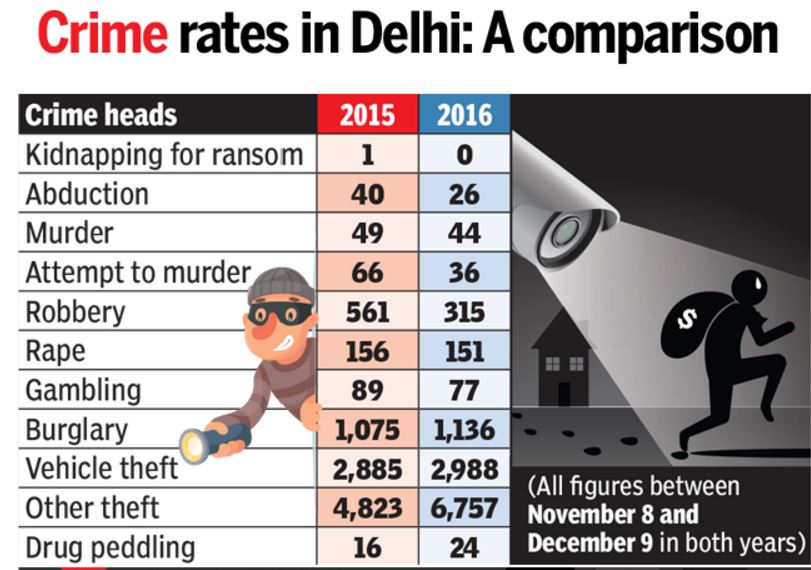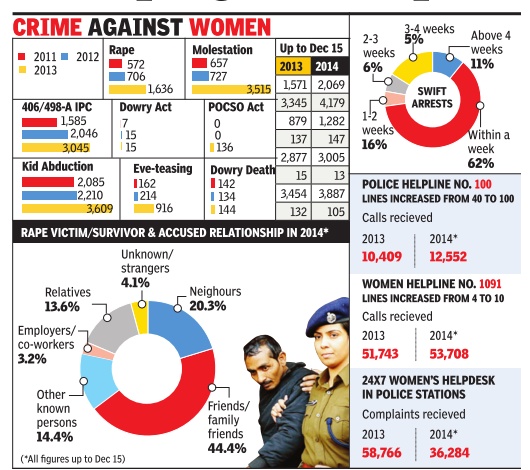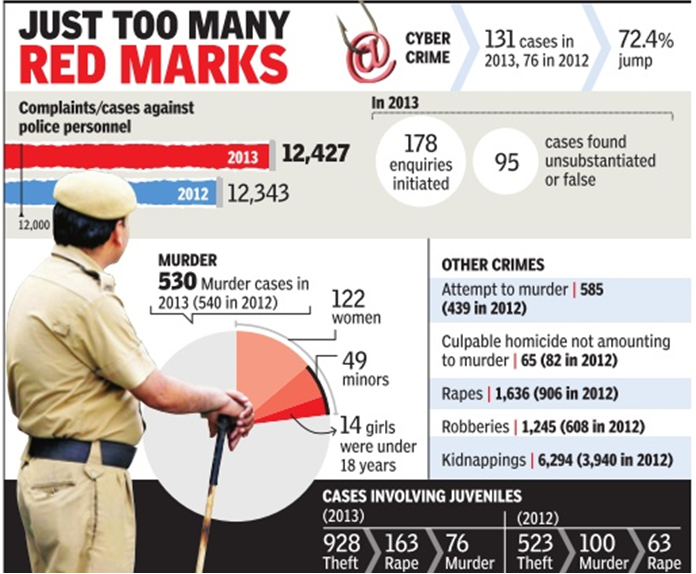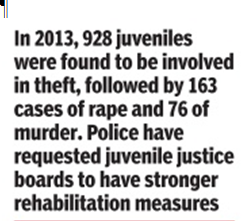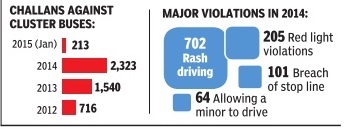Delhi: Crime
(→Rapes decline for 2nd straight year, road deaths rise) |
(→2014: Rapes in Delhi) |
||
| (25 intermediate revisions by 2 users not shown) | |||
| Line 135: | Line 135: | ||
==2015: Safest year since 2005== | ==2015: Safest year since 2005== | ||
[http://epaperbeta.timesofindia.com/Article.aspx?eid=31808&articlexml=City-roads-safest-in-a-decade-05012016005014 ''The Times of India''] Jan 05 2016 | [http://epaperbeta.timesofindia.com/Article.aspx?eid=31808&articlexml=City-roads-safest-in-a-decade-05012016005014 ''The Times of India''] Jan 05 2016 | ||
| − | [[File: | + | |
| + | [[File: Crime in Delhi in 2015, compared with 2014; Crime in Delhi 2010- 2015.jpg|Crime in Delhi in 2015, compared with 2014; Crime in Delhi 2010- 2015; Graphic courtesy: [http://epaperbeta.timesofindia.com/Gallery.aspx?id=05_01_2016_005_008_013&type=P&artUrl=Bassi-shoots-from-hip-at-meet-05012016005008&eid=31808 ''The Times of India''] Jan 5 2016|frame|500px]] | ||
Somreet Bhattacharya | Somreet Bhattacharya | ||
| Line 148: | Line 149: | ||
Police involved people in traffic policing through phone apps and their Facebook page, and 5,200 violations were reported by the public. Hired helicopters were also used for regulating and monitoring traffic movement during festivals in 2015. | Police involved people in traffic policing through phone apps and their Facebook page, and 5,200 violations were reported by the public. Hired helicopters were also used for regulating and monitoring traffic movement during festivals in 2015. | ||
| + | |||
| + | 1.9==2015>17: Despite dip, Delhi still the crime capital== | ||
| + | [https://epaper.timesgroup.com/Olive/ODN/TimesOfIndia/shared/ShowArticle.aspx?doc=TOIDEL/2019/10/23&entity=Ar01000&sk=8988735F&mode=text Oct 23, 2019: ''The Times of India''] | ||
| + | |||
| + | [[File: 2015-17, An overview of crime in Delhi.jpg|2015>17: An overview of crime in Delhi <br/> From: [https://epaper.timesgroup.com/Olive/ODN/TimesOfIndia/shared/ShowArticle.aspx?doc=TOIDEL/2019/10/23&entity=Ar01000&sk=8988735F&mode=text Oct 23, 2019: ''The Times of India'']|frame|500px]] | ||
| + | |||
| + | Delhi appears to have done enough to live up to its unwanted appellation as the crime capital of India, with the latest National Crime Records Bureau report, released on Monday, showing that around 1,050 police cases were registered for every lakh of population in the city in 2017 compared with a national average of just 238. Even though the rate of violent crimes slid, Delhi still accounted for 28% of the violent crimes reported in the metropolitan cities and for 40% of the Indian Penal Code crimes. | ||
| + | |||
| + | While the number of murder cases in 2017 dipped 17% and kidnapping by 8% compared with 2016, Delhi’s 400 homicides and 6,095 abductions still topped Mumbai and Bengaluru. Delhi Police also registered 1,229 cases of rape in 2017 compared with 287 cases in Mumbai. | ||
| + | |||
| + | Alarmingly, the number of crimes committed by juveniles rose to 2,965 in 2017 from 2,499 the previous year and 2,366 in 2015. The maximum crimes against senior citizens were also reported from Delhi with a 10% rise from 685 cases in 2016. Delhi also had the lion’s share, around 35%, of crimes against children in the metros. | ||
| + | |||
| + | While Delhi had the highest percentage (27%) of offences affecting the human body among metro cities ahead of Mumbai (10%) and Bengaluru (8.5%), it saw the most vehicle thefts in the country with 40,972 cases registered, two years after police introduced the lodging of e-FIRs for reporting vehicle thefts. | ||
| + | Delhi also had among the most robbery cases (3,147) in the country and the most number of thefts in 2017 with 1,33,024 cases. Of this, 8,051 cases involved snatching. NCRB said there were 613 cases of attempt to murder and 36 cases of dacoity in the city. Of the 752 lost properties, only 76 were recovered by police, a worse record than in 2016 and 2015. | ||
| + | |||
| + | Delhi Police maintained that the rise in the crime statistics was actually the fallout of its several initiatives. “The figures indicative our pro-active policing, registration of e-FIRs and increase of police presence on the roads,” asserted Delhi Police spokesperson Mandeep Singh Randhawa. “The data shows a dip in crimes that are prime indicators of a city’s crime situation.” Police also cited data showing a decline of 28% in violent crimes and higher disposal of heinous cases to boost their claims. | ||
| + | |||
| + | [[Category:Crime|D DELHI: CRIMEDELHI: CRIMEDELHI: CRIME | ||
| + | DELHI: CRIME]] | ||
| + | [[Category:India|CDELHI: CRIMEDELHI: CRIMEDELHI: CRIME | ||
| + | DELHI: CRIME]] | ||
| + | [[Category:Pages with broken file links|DELHI: CRIMEDELHI: CRIMEDELHI: CRIME | ||
| + | DELHI: CRIME]] | ||
| + | [[Category:Places|D DELHI: CRIMEDELHI: CRIMEDELHI: CRIME | ||
| + | DELHI: CRIME]] | ||
| + | |||
==Nov 2016: demonetisation reduced crime== | ==Nov 2016: demonetisation reduced crime== | ||
[http://timesofindia.indiatimes.com/india/Is-demonetisation-affecting-crime-in-Delhi/articleshow/55908660.cms Is demonetisation affecting crime in Delhi?, The Times of India 10 Dec 2016] | [http://timesofindia.indiatimes.com/india/Is-demonetisation-affecting-crime-in-Delhi/articleshow/55908660.cms Is demonetisation affecting crime in Delhi?, The Times of India 10 Dec 2016] | ||
| Line 274: | Line 301: | ||
The traffic situation remained grim as fatal accidents rose from 1,491 to 1,562 in 2018. And these accidents killed 1,604 people last year as against 1,510 in 2017. Vehicle thefts too remained a cause for concern, registering a rise of around 13% last year — 44,158 cases as against 39,084 in 2017. | The traffic situation remained grim as fatal accidents rose from 1,491 to 1,562 in 2018. And these accidents killed 1,604 people last year as against 1,510 in 2017. Vehicle thefts too remained a cause for concern, registering a rise of around 13% last year — 44,158 cases as against 39,084 in 2017. | ||
| + | |||
| + | ==2019== | ||
| + | [https://epaper.timesgroup.com/Olive/ODN/TimesOfIndia/shared/ShowArticle.aspx?doc=TOIDEL%2F2020%2F10%2F01&entity=Ar00305&sk=78257DFF&mode=text 20% spike in city crimes last year, but heinous offences down: NCRB, October 1, 2020: ''The Times of India''] | ||
| + | |||
| + | [[File: Delhi- Crime, 2018, 2019.jpg|Delhi: Crime, 2018, 2019 <br/> From: [https://epaper.timesgroup.com/Olive/ODN/TimesOfIndia/shared/ShowArticle.aspx?doc=TOIDEL%2F2020%2F10%2F01&entity=Ar00305&sk=78257DFF&mode=text 20% spike in city crimes last year, but heinous offences down: NCRB, October 1, 2020: ''The Times of India'']|frame|500px]] | ||
| + | |||
| + | Cases of rapes in Delhi saw a rise of 3% in 2019 while overall registration of crimes in the capital witnessed a rise of around 20% in 2019 compared with 2018, data released by National Crime Records Bureau shows. | ||
| + | |||
| + | In 2019, 2,99,475 crime incidents were registered against 2,49,012 incidents in the previous year. However, overall heinous crimes saw a dip in registration. Robberies, for example, dipped with 1,956 cases last year against 2,444 cases reported in 2018. This is a fall of 20% but can be categorised as highest when compared nationally. In Delhi, the robbery rate — number of crimes per 100,000 population — in 2019 was 9.8 against the all-India rate of 2.3. | ||
| + | |||
| + | Last year, 1,253 cases of rapes were registered compared to 1215 cases in 2018, a rise of 3%. However, molestations came down in 2019 with 2,355 registered cases against 2,705 in 2018. In 2019, five cases of murders with rape were reported against three in 2018, NCRB data shows. 456 cases of sexual harassment were reported in 2019 against 552 in 2018. | ||
| + | |||
| + | |||
| + | |||
| + | |||
| + | ''' Thefts 80% of registered crimes ''' | ||
| + | |||
| + | ''' Graft Cases Against Public Servants See 3-Fold Rise: NCRB ''' | ||
| + | |||
| + | The NCRB data also shows that registration of “crimes against the state” witnessed a rise of 136% in 2019 compared to previous year. In 2018, 11 cases under this head were registered in Delhi whereas the figure jumped to 26 in 2019. Similarly, cases of corruption by public servants, which are registered under the Prevention of Corruption Act show a three-fold rise in 2019. | ||
| + | |||
| + | In 2018, six cases were registered under this Act where as 18 cases were registered in 2019, a rise of 200%. The incidents of vehicle thefts dipped slightly with 46,215 cases reported in 2019 compared to 46,433 cases in 2018. However, the rate of this crime per lakh population was recorded at 231.8 in 2019 against 17.8 nationally. The murders saw a marginal rise with 521 cases being reported in 2019 against 513 in 2018. | ||
| + | |||
| + | The data suggests that a big chunk of the overall registered crimes were those of thefts — 2,45,985 cases in 2019 against 1,95688 in 2018. The figures suggest that thefts constituted over 80% of the registered crimes. In 2018, a little over half the crimes pertained to thefts. The theft rate in Delhi was around 1,233 while the rate recorded nationally was merely around 50. Economic offences and cybercrimes showed a decline in 2019, NCRB data suggests. | ||
| + | |||
| + | Crimes pertaining to economic offences saw a slight reduction of around 0.5% from 4,918 in 2018 to 4,889 in 2019. The maximum number of cases reported were of forgery and cheating, 4533 cases were reported last year. | ||
| + | |||
| + | Also, registered cases of cybercrime saw a decline of around 35% from 189 in 2018 to 115 in 2019. In maximum number of cases, the motive of criminals was to dupe people, extort money and even revenge was seen as a reason. A total of 17 cases of online stalking of women were reported last year. Human and child trafficking cases reported a slight decline in 2019 with registration of 93 cases against 98 in 2018. | ||
| + | |||
| + | In the 93 reported cases, 536 of the victims were below 18. In many of the cases, the victims were in groups. In 2019, Delhi reported one custodial death and the person was not on remand. The NCRB, which functions under the Union home ministry, is tasked with collecting and analysing crime data as defined by the Indian Penal Code and special and local laws in the country. | ||
| + | |||
| + | ===Details=== | ||
| + | [[File: Crime in Delhi in 2019, vis-à-vis 2018- 1.jpg| Crime in Delhi in 2019, vis-à-vis 2018: 1 <br/> From: [https://epaper.timesgroup.com/Olive/ODN/TimesOfIndia/shared/ShowArticle.aspx?doc=TOIDEL%2F2019%2F11%2F25&entity=Ar00512&sk=9DC2F606&mode=text Nov 25, 2019: ''The Times of India'']|frame|500px]] | ||
| + | |||
| + | [[File: Crime in Delhi in 2019, vis-à-vis 2018- 2.jpg| Crime in Delhi in 2019, vis-à-vis 2018: 2 <br/> From: [https://epaper.timesgroup.com/Olive/ODN/TimesOfIndia/shared/ShowArticle.aspx?doc=TOIDEL%2F2019%2F11%2F25&entity=Ar00512&sk=9DC2F606&mode=text Nov 25, 2019: ''The Times of India'']|frame|500px]] | ||
| + | |||
| + | '''See graphics''': | ||
| + | |||
| + | '' Crime in Delhi in 2019, vis-à-vis 2018: 1 '' | ||
| + | |||
| + | '' Crime in Delhi in 2019, vis-à-vis 2018: 2 '' | ||
| + | |||
| + | [[Category:Crime|D DELHI: CRIMEDELHI: CRIMEDELHI: CRIME | ||
| + | DELHI: CRIME]] | ||
| + | [[Category:India|CDELHI: CRIMEDELHI: CRIMEDELHI: CRIME | ||
| + | DELHI: CRIME]] | ||
| + | [[Category:Pages with broken file links|DELHI: CRIMEDELHI: CRIMEDELHI: CRIMEDELHI: CRIMEDELHI: CRIME | ||
| + | DELHI: CRIME]] | ||
| + | [[Category:Places|D DELHI: CRIMEDELHI: CRIMEDELHI: CRIME | ||
| + | DELHI: CRIME]] | ||
| + | |||
| + | [[Category:Crime|D DELHI: CRIMEDELHI: CRIMEDELHI: CRIME | ||
| + | DELHI: CRIME]] | ||
| + | [[Category:India|CDELHI: CRIMEDELHI: CRIMEDELHI: CRIME | ||
| + | DELHI: CRIME]] | ||
| + | [[Category:Pages with broken file links|DELHI: CRIMEDELHI: CRIMEDELHI: CRIMEDELHI: CRIMEDELHI: CRIME | ||
| + | DELHI: CRIME]] | ||
| + | [[Category:Places|D DELHI: CRIMEDELHI: CRIMEDELHI: CRIME | ||
| + | DELHI: CRIME]] | ||
| + | |||
| + | ==2020== | ||
| + | [https://epaper.timesgroup.com/Olive/ODN/TimesOfIndia/shared/ShowArticle.aspx?doc=TOIDEL%2F2021%2F02%2F20&entity=Ar00705&sk=8EF10A38&mode=text Sakshi Chand, February 20, 2021: ''The Times of India''] | ||
| + | |||
| + | [[File: Crime in Delhi in 2020.jpg|Crime in Delhi in 2020 <br/> From: [https://epaper.timesgroup.com/Olive/ODN/TimesOfIndia/shared/ShowArticle.aspx?doc=TOIDEL%2F2021%2F02%2F20&entity=Ar00705&sk=8EF10A38&mode=text Sakshi Chand, February 20, 2021: ''The Times of India'']|frame|500px]] | ||
| + | |||
| + | [[File: Crime in Delhi in 2020, the Covid year.jpg|Crime in Delhi in 2020, the Covid year <br/> From: [https://epaper.timesgroup.com/Olive/ODN/TimesOfIndia/shared/ShowArticle.aspx?doc=TOIDEL%2F2021%2F02%2F20&entity=Ar00702&sk=959D7592&mode=image February 20, 2021: ''The Times of India'']|frame|500px]] | ||
| + | |||
| + | '''See graphic''': | ||
| + | |||
| + | '' Crime in Delhi in 2020 '' | ||
| + | |||
| + | '' Crime in Delhi in 2020, the Covid year '' | ||
| + | |||
| + | |||
| + | |||
| + | When 2020 turned the corner, Delhi Police found itself engaged in a challenge that pitted its own against an insidious coronavirus. Police had not only to enforce the Covid-19 lockdown, but in doing so had to take care of its personnel. Its duties included policing the streets, securing containment zones, implementing social distancing, distributing food to the stranded and even handing out masks to the needy. | ||
| + | |||
| + | At one point of time, Delhi Police was managing around 2,500 containment zones, preventing people from stepping or moving around in the isolated area. To help the residents in such localities, police created WhatsApp groups and facilitated supply of essential items. All the while, the cops traced containment violators using geo-fencing technology and sometimes registered cases against them. | ||
| + | |||
| + | Around 31 cops succumbed to Covid and over 2,500 recovered after infection. Unfazed, police commissioner S N Shrivastava launched a plasma donation programme, urging personnel who had recovered to help others undergoing convalescent plasma therapy. The cops are still donating blood and plasma for Covid patients in Delhi. | ||
| + | |||
| + | An onerous task for the cops was caring for the stranded migrant labourers across the city. They not only provided meals, but also guided the beleaguered population to the nearest shelters. An even bigger challenge was moving the tens of thousands of migrants to the stations from where they could board special trains back home, all the while ensuring social distancing. | ||
| + | |||
| + | Amid all this, the cops also had to maintain law and order and carry out policing. It was a time when going to a crime scene was a hazard, especially if the crime had taken place in a containment zone. Apart from taking the mandatory precautions, police were able to carry out investigations, relying on extensive use of technology for the purpose. | ||
| + | |||
| + | Dedicated teams in each district tracked social media platforms like Twitter and Facebook and responded to the posts of people in distress. All police premises and colonies were regularly sanitised and complaints were heard from behind plastic barriers. Technology played a major role and complaints were accepted over video calls or online. Most of the cases registered in 2020 were online without police interface. | ||
| + | |||
| + | To motivate the force and their families, police organised wellness seminars and counselling sessions. Over one lakh Ayuraksha kits were distributed to boost the immunity of personnel, and yoga and pranayama camps were made mandatory at the district level. | ||
| + | |||
| + | Delhi Police also showed their humane side, and from June 15 last year till February 18 this year, it distributed over four lakh masks to the needy. Among other such exercises, it also reached out to those living alone, especially senior citizens. In a wonderful gesture, the cops made them feel supported amid the isolation by getting them cakes and celebrating their birthdays. | ||
| + | |||
| + | |||
| + | ===2021 B=== | ||
| + | [https://epaper.timesgroup.com/Olive/ODN/TimesOfIndia/shared/ShowArticle.aspx?doc=TOIDEL/2021/09/16&entity=Ar00812&sk=B6611EDD&mode=text Sep 16, 2021: ''The Times of India''] | ||
| + | |||
| + | [[File: Delhi Crime in 2021.jpg|Delhi Crime in 2021 <br/> From: [https://epaper.timesgroup.com/Olive/ODN/TimesOfIndia/shared/ShowArticle.aspx?doc=TOIDEL/2021/09/16&entity=Ar00812&sk=B6611EDD&mode=text Sep 16, 2021: ''The Times of India'']|frame|500px]] | ||
| + | |||
| + | |||
| + | Crime in the time of Covid had a lesser sting for the city than the year earlier. The patrolling of the capital’s roads to enforce pandemic regulations appeared to have kept street crime and crimes against women in check. However, perhaps because of the online dependence for most activities during the period, cybercrime saw a relative spurt. These trends were revealed when the National Crime Records Bureau statistics for 2020 were released. | ||
| + | |||
| + | Cases of rape reported by women dipped by 21% in Delhi in 2020 in comparison with the previous year. The overall crimes against women in Delhi went down by 24%. Cybercrime, however, saw a significant rise of 55% in the city. The Covid lockdown in 2020 was a major factor that deterred street criminals and those who would commit crimes against women. NCRB put the number of crimes against women in 2020 at 9,782, much lower than the 12,902 reported in 2019. | ||
| + | |||
| + | Against 1,231 cases of rape in 2019, there were a much lower 967 last year, a dip of 21%. Cases of assault against women also slid to 938 in 2020 from 1,088 the previous year. Women also reported 644 cases of sexual harassment when in 2019 they had registered 862. There was also a significant 40% decrease in cases of stalking in 2020. The data shows that 235 cases of stalking were reported to the cops against 388 the previous year. | ||
| + | |||
| + | Police officers believed these were the result of Covid measures such as intensifying night patrolling and tightening security on the streets round the clock. “Patrolling and checking were intensified at night,” an officer said. “Police presence was also adequately enhanced to prevent untoward incidents in localities.” | ||
| + | |||
| + | Across 19 metropolitan cities in India too, there was a 21% decrease in crimes against women, according to the NCRB data. Against the total of 44,738 cases recorded in 2019, there were 35,331 cases of crime against women registered in 2020. The data shows that 30.2% of these cases pertained to either cruelty by husband or his relatives while 197% were cases of assault on women with intent to outrage her modesty. Kidnapping and abduction of women followed with 19% and 7.2%. | ||
| + | |||
| + | The lockdown and the restrictions placed on public interactions also played a vital role in keeping street crimes low in 2020. “Through the lockdown and despite the pandemic, our personnel stood guard on roads and in public for the safety of Delhiites," the officer said. | ||
| + | |||
| + | Cybercrime, however, soared by 55% in Delhi. Against 107 reported crimes in 2019, there were 166 in 2020. A major chunk of these crimes — 59 in 2020 — related to transmitting of sexually explicit content on the internet. Such cases had numbered just19 a year earlier. | ||
| + | |||
| + | Cyber fraud too saw an upward trend, increasing to 31 cases from 11, though cyber stalking cases fell to 12 from 16 in 2019. Cases of online bank frauds also increased to 19 in 2020 from a mere two the previous year. | ||
| + | |||
| + | “There was a rise in the various categories of cybercrime in 2020,” a police officer said. “One of the reasons why online crimes went up was also due to the lockdown. We detected numerous cases of fake job rackets, fake lotteries, people being duped while being promised Covid medicines and home delivery of other items when the city was at a standstill. Our cybercrime teams in each district registered and probed all cases diligently. Arrests were made in most of these cases." | ||
| + | |||
| + | |||
| + | ==2021 == | ||
| + | [[File: Crime in Delhi in 2021; 2019-21.jpg| Crime in Delhi in 2021; 2019-21 <br/> From: [https://epaper.timesgroup.com/article-share?article=25_02_2022_006_016_cap_TOI February 25, 2022: ''The Times of India'']|frame|500px]] | ||
| + | |||
| + | '''See graphic''': | ||
| + | |||
| + | '' Crime in Delhi in 2021; 2019-21 '' | ||
| + | |||
| + | [[Category:Crime|D DELHI: CRIMEDELHI: CRIMEDELHI: CRIME | ||
| + | DELHI: CRIME]] | ||
| + | [[Category:India|CDELHI: CRIMEDELHI: CRIMEDELHI: CRIME | ||
| + | DELHI: CRIME]] | ||
| + | [[Category:Pages with broken file links|DELHI: CRIMEDELHI: CRIMEDELHI: CRIMEDELHI: CRIMEDELHI: CRIME | ||
| + | DELHI: CRIME]] | ||
| + | [[Category:Places|D DELHI: CRIMEDELHI: CRIMEDELHI: CRIME | ||
| + | DELHI: CRIME]] | ||
=Arms, illegal= | =Arms, illegal= | ||
| Line 343: | Line 502: | ||
Delhi Police has undertaken several initiatives to catch vehicle thieves. These include identification of affected places and time zones and proper deployment of staff in these areas; barriers put up at vulnerable spots; manufacturers requested to install security devices at showrooms and offices; parking attendants have been sensitised and educative advertisements in newspapers and radio channels have been distributed. | Delhi Police has undertaken several initiatives to catch vehicle thieves. These include identification of affected places and time zones and proper deployment of staff in these areas; barriers put up at vulnerable spots; manufacturers requested to install security devices at showrooms and offices; parking attendants have been sensitised and educative advertisements in newspapers and radio channels have been distributed. | ||
| + | |||
| + | ==2018: Over 44k vehicles stolen, only 4.6k found== | ||
| + | [https://epaper.timesgroup.com/Olive/ODN/TimesOfIndia/shared/ShowArticle.aspx?doc=TOIDEL%2F2019%2F01%2F10&entity=Ar00809&sk=C3628C7F&mode=text January 10, 2019: ''The Times of India''] | ||
| + | |||
| + | [[File: Motor vehicle thefts, in 2018.jpg|Motor vehicle thefts, in 2018 <br/> From: [https://epaper.timesgroup.com/Olive/ODN/TimesOfIndia/shared/ShowArticle.aspx?doc=TOIDEL%2F2019%2F01%2F10&entity=Ar00809&sk=C3628C7F&mode=text January 10, 2019: ''The Times of India'']|frame|500px]] | ||
| + | |||
| + | |||
| + | Delhi Police has cited lack of parking space inside colonies and inadequate neighbourhood security as reasons behind the 13% rise in auto thefts in 2018. Last year, 44,158 vehicles were stolen against 39,084 in the previous year. | ||
| + | |||
| + | While 6,751auto lifters were arrested in 2018, cops could recover only 4,619 stolen vehicles. Vehicle thefts accounted for 19% of total IPC cases registered in Delhi. Delhi Police data reveals that around 12% of the vehicles recovered from Delhi were stolen in the National Capital Region. | ||
| + | |||
| + | In total, 1,46,707 e-FIRs for vehicle thefts have been registered since the inception of the online facility in April 2015. Last year, cops recorded 43,801 e-FIRs for vehicle thefts. E-courts have accepted 1,22,255 untraced reports through the e-FIR app that allows complainants to file their claims before insurance companies. | ||
| + | |||
| + | The data also reveals that two out of 10 vehicles stolen in the city are cars, while seven are two-wheelers. A majority of the vehicles were stolen from outside colonies after dark last year. | ||
| + | |||
| + | “The increase in the number of fancy cars has made them an easy target for vehicle thieves. Non-availability of parking spaces in residential area, reluctance to spend on security devices, no fixed registration numberplate and a growing second-hand car market play a major role in the absorption of stolen vehicles,” Delhi Police PRO, DCP Madhur Verma, said. | ||
| + | |||
| + | Vehicles stolen from Delhi were disposed in Uttar Pradesh, Bihar, West Bengal, J&K and Northeast states. Cops have undertaken several initiatives to curb this crime. This includes identification of affected places, time of thefts and deploying staff to deter vehicle thieves. | ||
| + | |||
| + | Police have also requested vehicle manufacturers to install security devices, like GPS tracking systems, before the cars leave the factories or showrooms. The record of stolen vehicles has also been computerised and shared with police forces of the neighbouring states to keep a lookout for them. | ||
| + | |||
| + | Last year, parking lot attendants were sensitised to detect stolen vehicles. Police have also been coordinating with insurance agencies for honouring claims for stolen vehicles. | ||
| + | |||
| + | The Delhi Police data revealed that two out of 10 vehicles stolen in Delhi were cars, while seven were two-wheelers. A majority of vehicles were stolen from outside colonies after dark last year. Non-availability of parking spaces in residential areas also contributed towards this crime | ||
| + | |||
| + | =CCTVs help solve crime= | ||
| + | ==2018== | ||
| + | [https://epaper.timesgroup.com/Olive/ODN/TimesOfIndia/shared/ShowArticle.aspx?doc=TOIDEL%2F2019%2F02%2F18&entity=Ar00405&sk=3F9650AE&mode=text Sidharth Bhardwaj, Dim lights, camera, lot of action: Meet these footage warriors looking for clues in low-res, February 18, 2019: ''The Times of India''] | ||
| + | |||
| + | [[File: 3 key cases cracked with CCTV help in 2018.jpg|3 key cases cracked with CCTV help in 2018 <br/> From: [https://epaper.timesgroup.com/Olive/ODN/TimesOfIndia/shared/ShowArticle.aspx?doc=TOIDEL%2F2019%2F02%2F18&entity=Ar00405&sk=3F9650AE&mode=text Sidharth Bhardwaj, Dim lights, camera, lot of action: Meet these footage warriors looking for clues in low-res, February 18, 2019: ''The Times of India'']|frame|500px]] | ||
| + | |||
| + | |||
| + | ''TECH TONIC: A Day In The Life Of Cops Using CCTV To Solve Crime'' | ||
| + | |||
| + | It’s 5am on a chilly January morning as a heavily bearded man in tattered clothes enters Netaji Subhas Place police station. As strange as it seem, the sentry welcomes the ragged fellow with a salute. Eavesdropping on their conversation reveals that the man is actually head constable Jairam Yadav, who has come after spending a night in the slums of Jahangirpuri. He has some clues to a murder of a man in the area and wants to confirm this through CCTV footage. | ||
| + | |||
| + | As a welcome cup of hot tea arrives, Yadav plugs in a USB drive that contains recordings from closed-circuit television cameras in the vicinity of the murder site. “CCTV footage has become a crucial aspect of investigation these days and has contributed to the solving of 60% of cases,” he says, as he constantly pauses, forwards and rewinds the images on the computer, his eyes peering at the screen for clarity on the registration number of a car. | ||
| + | |||
| + | Yadav, who recently got an out-of-turn promotion, is credited with having solved 109 cases and is a member of the emerging breed of cops with expertise in analysis of CCTV footage. This work is an inseparable part of investigation now, with the city covered by a network of CCTV cameras. In fact, as Yadav reveals, “The first step in a probe is to see if CCTV cameras are installed near the crime spot.” | ||
| + | |||
| + | All revelations by informers are correlated with CCTV video. “We determine, for instance, the possible escape route of the miscreants,” says Yadav. “On lucky days, we can identify the wrongdoer on the first few clips. Otherwise, the analysis can go on for months.” While investigating one murder case, Yadav pored through the output from over 100 cameras for a month before nailing the killers. | ||
| + | |||
| + | Yadav and his team members often divide the work. He mingles with informers and criminals on the streets — often disguised, as he was in Jahangirpuri — while the others tackle the technical investigation. But both are after details that corroborate each other, such as the colour of vehicles involved, the routes used, the attire and physical appearances of suspects, etc. | ||
| + | |||
| + | The technical investigation requires the cops to quickly get their hands on films from cameras installed privately or by government agencies. Explaining the difficulties they face, inspector Naveen Kumar, whose team solved the bank robbery in outer Delhi’s Khaira village in October last year, reveals, “Recordings of CCTV cameras get deleted or overlapped after three days, a week or 10 days. The race is to get them as quickly as possible before the evidentiary value is nullified.” The inspector adds, “Also, the specific time at which the suspect might have passed the vision field of the camera is not known, and we often have to sit through six-seven hours of footage to get a glimpse of them.” | ||
| + | |||
| + | Equal importance is given to footage from before the time of the incident. Inspector Vinay Yadav, while narrating how his team solved the robbery of a cash van in northeast Delhi’s Welcome, explains that professional criminals often case the area before executing a crime and are caught by CCTV cameras in their unguarded moments. “During a robbery, criminals may mask their faces,” Vinay Yadav says, “but they usually go about uncovered before that. Footage can show us their faces and help us identify them.” However, for all the expertise of these footage warriors, the lack of high-definition cameras still slows down their work. | ||
| + | |||
| + | Staring at the computer screen for hours at a stretch, their eyes focused on blurry images, does not make for a comfortable workday. Besides, as police doctors have noted, repeated exposure to gory images — of death, violence and antisocial acts — take an emotional toll on the men. But as head constable Jairam Yadav shrugs, “We signed up for this. Of course, the disturbing images keep playing in our heads. But it’s all part of our job.” | ||
=Children, missing= | =Children, missing= | ||
| Line 429: | Line 637: | ||
Cops in plainclothes have started travelling in buses to catch youths passing lewd remarks and misbehaving with women under Operation Shishtachar. Recently , such a drive was launched in Metro trains also. | Cops in plainclothes have started travelling in buses to catch youths passing lewd remarks and misbehaving with women under Operation Shishtachar. Recently , such a drive was launched in Metro trains also. | ||
| + | |||
| + | |||
| + | ==2018== | ||
| + | [https://timesofindia.indiatimes.com/city/delhi/crime-against-women-up-nearly-5/articleshow/73179754.cms January 10, 2020: ''The Times of India''] | ||
| + | |||
| + | NEW DELHI: More number of crimes against women was reported in the national capital in 2018 compared with the previous year. Delhi Police registered 13,640 cases of crime against women, which was almost 4.7% more than the 2017 figures. | ||
| + | |||
| + | As per NCRB data, as many as 1,215 cases of rape were registered in 2018 compared with 1,168 cases of rape in 2017. Delhi also reported more cases of crime against women per one lakh population in 2018 as compared to other metropolitan cities, with 149.6 cases being registered per lakh population. | ||
| + | |||
| + | Police say that measures like removing dark patches of road and immediate registration of cases on basis of a complaint by a woman have led to the rise in the number of cases reported. | ||
| + | |||
| + | In most of the cases registered in 2018, the accused were either a family member, friend, neighbour or a person known to the victims. Out of the 13,640 cases, 1,215 cases of rape and 11 cases of attempt to rape were reported. Besides this, 3,416 cases of cruelty by husbands or relatives, 3,715 cases of kidnapping of woman, 2,705 cases of outraging the modesty of a woman, 18 cases of women-centric crime on the internet and 153 incidents of dowry death were reported. Investigation in at least 20,940 cases from the previous year is still pending and a case has also been reopened for investigation. The rape of a 20-year-old visually impaired girl at her residence in Central Delhi by her neighbour had sent shock waves in the city. The accused had entered her house on the pretext of asking for sugar. According to NCRB, the crime against girls also saw a rise with 394 more cases reported in 2018 compared with 7,852 the previous year. | ||
| + | |||
| + | In 2018, 8,246 cases were reported out of which 1,839 cases were of Protection of Children from Sexual Offences Act (POCSO), 52 murders, 72 of human trafficking and 687 of outraging the modesty of a child under sections of POCSO. In September 2018, a woman had accused a self-styled godman of raping her and molesting her daughter, which was shifted to crime branch. | ||
| + | |||
| + | [[Category:Crime|D DELHI: CRIMEDELHI: CRIMEDELHI: CRIME | ||
| + | DELHI: CRIME]] | ||
| + | [[Category:India|CDELHI: CRIMEDELHI: CRIMEDELHI: CRIME | ||
| + | DELHI: CRIME]] | ||
| + | [[Category:Pages with broken file links|DELHI: CRIMEDELHI: CRIMEDELHI: CRIMEDELHI: CRIMEDELHI: CRIME | ||
| + | DELHI: CRIME]] | ||
| + | [[Category:Places|D DELHI: CRIMEDELHI: CRIMEDELHI: CRIME | ||
| + | DELHI: CRIME]] | ||
=Crime inside buses= | =Crime inside buses= | ||
| Line 592: | Line 823: | ||
Sources said a major dent was how the infrastructure was barely put into use. A cyber forensic mobile van, equipped with the latest capabilities to probe hacking, digital extortion, ransomware and identity thefts, was launched last year. However, sources in the unit said that it has barely moved and covered a distance of just around 100km till December. The van stands in the parking lot gathering dust. | Sources said a major dent was how the infrastructure was barely put into use. A cyber forensic mobile van, equipped with the latest capabilities to probe hacking, digital extortion, ransomware and identity thefts, was launched last year. However, sources in the unit said that it has barely moved and covered a distance of just around 100km till December. The van stands in the parking lot gathering dust. | ||
| + | |||
| + | ==2016>17== | ||
| + | [https://epaper.timesgroup.com/Olive/ODN/TimesOfIndia/shared/ShowArticle.aspx?doc=TOIDEL/2019/10/23&entity=Ar01010&sk=04C2607A&mode=text Oct 23, 2019: ''The Times of India''] | ||
| + | |||
| + | Fraud was the motive behind most of the cyber crime cases — 45 — registered in Delhi in 2017, followed by extortion, revenge and playing pranks. In all, 162 cases were registered with the cyber crime cell of Delhi Police in 2017 against 98 in 2016. | ||
| + | |||
| + | According to the latest National Crime Records Bureau (NCRB) report, sexual exploitation of women were reported in 32 cases, out of which nine were found to be related to cyber stalking and 13 to pornography. The cell registered 14 cases of identity theft, eight of cheating using a computer device and 34 | ||
| + | cases of publication or transmission of obscene and sexually explicit act in electronic form. No case was lodged under the head of cyber terrorism. | ||
| + | |||
| + | In 2017, the cops probed 394 cases of cyber crime, including some pending from the previous years, and arrested 105 people, out of which only two were convicted. Chargesheets were issued in 68 cases. | ||
| + | |||
| + | The cell disposed of 566 cases, including the ones pending over the past few years. Out of the solved cases, 46 were computer-related, 19 fraudrelated and 17 were connected to publishing or transmitting sexually explicit content. | ||
| + | |||
| + | In the same year, Delhi Police launched a dedicated website where victims of cyber crime can log in and lodge a complaint. A cyber laboratory providing assistance to deal with cyber crime cases was also set up in 2017. | ||
| + | |||
| + | [[Category:Crime|D DELHI: CRIMEDELHI: CRIMEDELHI: CRIME | ||
| + | DELHI: CRIME]] | ||
| + | [[Category:India|CDELHI: CRIMEDELHI: CRIMEDELHI: CRIME | ||
| + | DELHI: CRIME]] | ||
| + | [[Category:Pages with broken file links|DELHI: CRIMEDELHI: CRIMEDELHI: CRIMEDELHI: CRIMEDELHI: CRIME | ||
| + | DELHI: CRIME]] | ||
| + | [[Category:Places|D DELHI: CRIMEDELHI: CRIMEDELHI: CRIME | ||
| + | DELHI: CRIME]] | ||
| + | |||
| + | =Drugs= | ||
| + | ==2018: Four-fold rise in heroin seizures== | ||
| + | [https://epaper.timesgroup.com/Olive/ODN/TimesOfIndia/shared/ShowArticle.aspx?doc=TOIDEL%2F2019%2F01%2F10&entity=Ar00810&sk=A05F33BB&mode=text January 10, 2019: ''The Times of India''] | ||
| + | |||
| + | |||
| + | Drugs gave Delhi Police a headache through the year. There was a fourfold rise in seizure of heroin over 2017 — the police seized 196.7 kg of heroin as against 51.6 kg in 2017. There was a spike in the seizure of opium as well — it shot up by three times in 2018. The police recovered 53.7 kg through the year as against 19.6 kg in 2017. | ||
| + | |||
| + | According to police data, 493 cases were registered last year under the Narcotic Drugs and Psychotropic Substances (NDPS) Act compared to 362 in 2017. The number of people arrested under the Act also shot up significantly — 662 smugglers were arrested as compared to 491 in 2017. Many foreign nationals were among them. | ||
| + | |||
| + | Among the major operations against traffickers of heroin, the special cell busted a ‘Golden Triangle’, seizing high-grade heroin worth Rs 100 crore from two smugglers. They were bringing the drug from Myanmar into India through Assam and then transporting it to Delhi in trucks. | ||
| + | |||
| + | The cops said such contraband is being used as a source of revenue by Maoists. In July last year, the special cell busted a module transporting opium and poppy straw from Jharkhand to Punjab via Delhi. Two men | ||
| + | |||
| + | were arrested and 12 quintals of poppy straw worth about Rs 10 crore found. | ||
| + | |||
| + | Ganja, too, was on a high with 4,272 kg recovered as compared to 2415 kg the previous year. TOI had earlier reported about the rise in usage of the contraband with highquality concentrates of the contraband being made. | ||
| + | |||
| + | Recovery of charas, however, declined with cops seizing 14.1kg as against 58.4 kg in 2017. | ||
| + | |||
| + | = Economic offences= | ||
| + | ==2015>17== | ||
| + | [https://epaper.timesgroup.com/Olive/ODN/TimesOfIndia/shared/ShowArticle.aspx?doc=TOIDEL/2019/10/23&entity=Ar01001&sk=227B29E8&mode=text Rajshekhar Jha , Oct 23, 2019: ''The Times of India''] | ||
| + | |||
| + | |||
| + | Kanpur, long famous for its sweet shop called Thaggu Ke Laddu, lived up to the thug reference with 28 cases of counterfeiting in 2017. But the real thug capital was Delhi. The city not only was way above Kanpur in the number of counterfeiting cases with 65, but the capital also topped the economic offences chart in the National Crime Record Bureau data for 2017 with 4,808 cases among metro cities, relegating Mumbai and Jaipur to the second and third place with, respectively, 4,462 and 4,318 cases. | ||
| + | |||
| + | The 2017 figure gave Delhi an unenviable 16% share of the total economic offences reported across India’s states and Union territories. Despite this, the capital actually logged a drop in economic offences given that in 2016 and 2015 such cases numbered a higher 5,942 and 6,396, respectively. According to NCRB, 4,379 cases of forgery, cheating and fraud and 364 cases of criminal breach of trust were registered in 2017. | ||
| + | |||
| + | Among cases involving economic offences, Delhi reported one case where the worth of the property involved was over Rs 100 crore, while three others were between Rs 25-50 crore. In 11 cases, the loss was estimated at Rs 10-25 crore, and in 93 cases, between Rs 1 crore and Rs 10 crore. There were 298 instances of defraud of Rs 50 lakh-1crore, 1,303 cases of Rs 1-10 lakh and 571of Rs 10-50 lakh. The highest number of cases, 1,545, involved losses of under Rs 1 lakh. | ||
| + | |||
| + | However, Delhi Police did not properly dispose of these cases. The NCRB data revealed that though 3,743 people were arrested for these offences in 2017, only 2,880 were eventually charge-sheeted. Of the arrested, 77 were women, of whom 63 had a charge-sheet filed against them. | ||
| + | |||
| + | The courts convicted 963 people of economic offences, while discharging 72 and acquitting 27. Not a single woman was convicted, while two were discharged and acquitted. | ||
| + | |||
| + | Investigation was poor and slow in 2017 if the NCRB data can be interpreted in this manner. Delhi Police dealt with 4,808 cases reported in 2017 but had 13,408 cases from the previous years for which the investigation was pending. Police also opened three cases for re-investigation that year. In total, therefore, the cops probed 18,219 cases in 2017. No other metropolis had so much pending investigation work. | ||
| + | |||
| + | The data also showed that police submitted a final report in 245 cases of economic offences, stating they were of the nature of civil disputes or “mistake of fact”. Eight cases were transferred to other states, while one was withdrawn by the state. | ||
| + | |||
| + | |||
| + | =Foreigners, crimes by and against = | ||
| + | ==2017== | ||
| + | [https://epaper.timesgroup.com/Olive/ODN/TimesOfIndia/shared/ShowArticle.aspx?doc=TOIDEL/2019/10/23&entity=Ar01003&sk=9380E20F&mode=text Oct 23, 2019: ''The Times of India''] | ||
| + | |||
| + | Delhi is noticeable for both crimes against foreigners as well as crimes committed by foreigners. In 2017, crime data for which was released by NCRB on Monday, over one-third of the crimes against foreigners in India took place in the capital. Conversely, Delhi was third in terms of crimes committed by foreigners. | ||
| + | |||
| + | Of the 492 cases where foreigners were crime victims, Delhi accounted for 169. The capital was followed by Maharashtra and Tamil Nadu, which registered 61 and 43 cases, respectively. Places like Andaman Islands, Tripura, Puducherry, Daman & Diu and Jammu & Kashmir did not report a single crime against foreigners. | ||
| + | |||
| + | There has been a constant rise in such crime in Delhi since 2015, when 147 cases were reported, rising to 154 in 2016. Most of these pertain to theft, cheating, forgery and robbery. | ||
| + | Delhi also registered 173 cases of foreigners committing crimes, behind West Bengal and Karnataka. Most of the foreign nationals arrested were Bangladeshis, who were involved in 2,725 crimes, while 193 were from Nepal, 162 from Sri Lanka and 70 from Pakistan. | ||
| + | |||
| + | The cops rescued seven trafficked Nepalese and one Bangladeshi among the total of 404 rescued while being trafficked in and out of Delhi. | ||
| + | |||
| + | [[Category:Crime|D DELHI: CRIMEDELHI: CRIMEDELHI: CRIME | ||
| + | DELHI: CRIME]] | ||
| + | [[Category:India|CDELHI: CRIMEDELHI: CRIMEDELHI: CRIME | ||
| + | DELHI: CRIME]] | ||
| + | [[Category:Pages with broken file links|DELHI: CRIMEDELHI: CRIMEDELHI: CRIME | ||
| + | DELHI: CRIME]] | ||
| + | [[Category:Places|D DELHI: CRIMEDELHI: CRIMEDELHI: CRIME | ||
| + | DELHI: CRIME]] | ||
| + | |||
| + | = Hoax calls= | ||
| + | ==2015- 2019, Aug== | ||
| + | [https://epaper.timesgroup.com/Olive/ODN/TimesOfIndia/shared/ShowArticle.aspx?doc=TOIDEL%2F2019%2F08%2F21&entity=Ar00823&sk=E6856163&mode=text Somreet Bhattacharya, August 21, 2019: ''The Times of India''] | ||
| + | |||
| + | [[File: Hoax calls received by the Delhi Police, 2015- 2019, August.jpg| Hoax calls received by the Delhi Police, 2015- 2019, August <br/> From: [https://epaper.timesgroup.com/Olive/ODN/TimesOfIndia/shared/ShowArticle.aspx?doc=TOIDEL%2F2019%2F08%2F21&entity=Ar00823&sk=E6856163&mode=text Somreet Bhattacharya, August 21, 2019: ''The Times of India'']|frame|500px]] | ||
| + | |||
| + | A few months ago, a man called up the Delhi Police’s control room, informing about an Islamic State terrorist named Baryalai Zeyarkash entering India on a flight from Kabul. The caller gave specific details like the flight number and the time of arrival. Police and the intelligence agencies swung into action, and a man from Kabul by the name mentioned by the caller was indeed found on the flight. While one team started looking for the caller, the other began to scan the antecedents of the suspect. Two days later, it turned out that the caller Mohammed Akbar, a resident of C R Park, had a rivalry with Zeyarkash, and he wanted to implicate and harass him. | ||
| + | |||
| + | Hoax calls have become a major headache for Delhi Police and intelligence agencies. In 2018, they had received 132 bomb-related calls, while they have already received 82 this year. Similarly, 35 terror-related calls were received in 2018, while this year 24 such calls have already landed in the control rooms of various agencies. | ||
| + | |||
| + | Officials say that these calls consume the stretched resources of different wings of the police, intelligence agencies and other security agencies as full protocols are followed for every call. | ||
| + | |||
| + | “Depending upon the contents of the call, bomb disposal team, sniffer dog squads, aircraft crew, CISF and quick reponse teams apart from SWAT commandos are pressed into action, apart from the operational teams of the Special Cell. Every identified caller is put through a joint interrogation along with intelligence agencies to fully examine his intent and the content of his communication,” Delhi Police spokesperson Mandeep Singh Randhawa said. Many agencies also get involved because the point of landing of such calls are many, including control rooms of DIAL, CISF, police and customer care numbers of airlines. | ||
| + | |||
| + | A new trend that has been noticed by the agencies of late is the use of voice over internet protocol (VOIP), which makes it impossible for them to track the callers. At times, these calls are made to virtual private networks (VPNs) using proxy servers that take the cops on a wild goose chase. Even e-mails are used. | ||
| + | |||
| + | An assistant sub-inspector at the Kalkaji police station had recieved a call from a VOIP number 0034602091721 in which the caller had mentioned about a plot to blow up the IGI airport. Immediately, teams from central security agencies, bomb disposal squads, SWAT and the special cell were pressed into action. The airport was scanned, but no explosives were recovered. Cops also couldn’t trace the caller. | ||
| + | |||
| + | Many a times, cops have even found that the owners of the SIM card used in making hoax calls were innocent. | ||
| + | “It is of fundamental importance for police to carefully study the caller so that a genuine caller doesn't get harassed,” says DCP Manishi Chandra. | ||
| + | |||
| + | [[Category:Crime|D DELHI: CRIMEDELHI: CRIMEDELHI: CRIME | ||
| + | DELHI: CRIME]] | ||
| + | [[Category:India|CDELHI: CRIMEDELHI: CRIMEDELHI: CRIME | ||
| + | DELHI: CRIME]] | ||
| + | [[Category:Pages with broken file links|DELHI: CRIME | ||
| + | DELHI: CRIME]] | ||
| + | [[Category:Places|D DELHI: CRIMEDELHI: CRIMEDELHI: CRIME | ||
| + | DELHI: CRIME]] | ||
=Holi and crime= | =Holi and crime= | ||
| Line 668: | Line 1,013: | ||
In a programme conducted by the Delhi police earlier this year, the principal judge JJB-II, Suchi Laler, had even asked the counsellors to find out the reason behind children resorting to crime and had called for educating the parents too. | In a programme conducted by the Delhi police earlier this year, the principal judge JJB-II, Suchi Laler, had even asked the counsellors to find out the reason behind children resorting to crime and had called for educating the parents too. | ||
| + | |||
| + | ==2015>17== | ||
| + | [https://epaper.timesgroup.com/Olive/ODN/TimesOfIndia/shared/ShowArticle.aspx?doc=TOIDEL/2019/10/23&entity=Ar01008&sk=6AEC1B72&mode=text Rajshekhar Jha , Oct 23, 2019: ''The Times of India''] | ||
| + | |||
| + | Hinting at the failure of welfare scheme for children of a vulnerable age executed by Delhi government and Delhi Police, the city topped the number of crimes committed by juveniles in 2017. With 2,677 cases, Delhi accounted for 35% of such crimes in metropolitan cities. | ||
| + | |||
| + | There has been a steady rise in this category of crime in Delhi, with NCRB data logging 1,981 cases in 2015 and 2,368 in 2016. The data showed that minors committed 46 murders in 2017, the highest across the metropolises, and committed the most robberies and fraud among the metros. | ||
| + | |||
| + | Delhi Police has implemented schemes like Yuva and enrolled juvenile delinquents or vulnerable minors in vocational programmes to prepare them for employment. The state government too has schemes to wean youngsters away from crime. However, the data suggests these weren’t as successful as hoped for. | ||
| + | |||
| + | This is evidenced by the highest number of juveniles apprehended in Delhi. In 2017, the number of minors held by police was 3,268. The cops also apprehended 1,611 juveniles whose cases were pending investigation from the previous year, taking the total number of minors held to 4,879. No other metro city came close to this figure. Pune lagged in second place with 1,949 followed by Mumbai with 1,702 apprehensions. | ||
| + | |||
| + | The data showed that 752 of the apprehended juveniles were illiterate, while 1,084 had received education till the primary level. While nine minors had studied beyond the higher secondary level, 1,213 had studied up to Class X and 210 till Class XII. | ||
| + | |||
| + | Of the minors held, 2,783 were found to be living with their parents, 248 with guardians, but 237 minors apprehended in 2017 were homeless. | ||
| + | |||
| + | As per the data, only eight of those apprehended were sentenced to imprisonment, though 86.9% of them were found guilty of the crimes they had been accused of. While 89 juveniles were acquitted, in 406 cases, they were discharged after the cases against them were found to have not occurred or were quashed by the court. The court sent 409 juveniles home after advising or warning them, while 106 were sent to special homes, or “Fit Institutes”, and 66 were penalised with fines. At the end of 2017, there were 3,795 cases still “pending investigation”. | ||
| + | |||
| + | The data showed that 752 of the apprehended juveniles were illiterate, while 1,084 had received education till the primary level | ||
| + | |||
| + | [[Category:Crime|D DELHI: CRIMEDELHI: CRIMEDELHI: CRIME | ||
| + | DELHI: CRIME]] | ||
| + | [[Category:India|CDELHI: CRIMEDELHI: CRIMEDELHI: CRIME | ||
| + | DELHI: CRIME]] | ||
| + | [[Category:Pages with broken file links|DELHI: CRIMEDELHI: CRIMEDELHI: CRIMEDELHI: CRIMEDELHI: CRIME | ||
| + | DELHI: CRIME]] | ||
| + | [[Category:Places|D DELHI: CRIMEDELHI: CRIMEDELHI: CRIME | ||
| + | DELHI: CRIME]] | ||
=Kidnapping/ abduction= | =Kidnapping/ abduction= | ||
| Line 677: | Line 1,050: | ||
''Kidnappings for ransom in Delhi: 2001-2017'' | ''Kidnappings for ransom in Delhi: 2001-2017'' | ||
| + | |||
| + | =Procedural issues, lapses= | ||
| + | ==2017== | ||
| + | [https://epaper.timesgroup.com/Olive/ODN/TimesOfIndia/shared/ShowArticle.aspx?doc=TOIDEL/2019/10/23&entity=Ar01002&sk=7A945528&mode=text Oct 23, 2019: ''The Times of India''] | ||
| + | |||
| + | Delhi Police has disposed of 2.47 lakh cases in 2017, but chargesheets were not filed in 1.7 lakh of them due to insufficient evidence or investigating officers’ failure to collect enough clues. According to the latest National Crime Records Bureau report, the figure is the highest in the country, followed by Uttar Pradesh. | ||
| + | |||
| + | At 1,52,110, Delhi also had the highest number of pending cases carried forward from the previous year, of which only 117 were reopened. In 2017, 16,779 cases registered under Indian Penal Code ended up as mistakes and were turned into civil disputes. Among the metropolitan cities, Delhi had the highest number of such mistakes. | ||
| + | |||
| + | The capital also had the maximum number of cases with pending investigation from 2016 at 1,70,311 followed by Maharashtra at 1,59,395. As many as 1,82,833 authentic cases were disposed of by Delhi Police due to insufficient evidence, no clue or other similar factors, the data stated. | ||
| + | |||
| + | The report showed that 5,522 cases were abated during investigation and 25,368 cases of 2016 were chargesheeted the next year, in addition to 26,707 cases of 2017. Twenty-five cases were transferred from Delhi Police to other agencies or states. | ||
| + | |||
| + | Delhi Police filed 47,635 chargesheets in 2017, including 22,799 which were carried forward from the previous year. Delhi, however, has one of the lowest pendency of previous cases (32.1%) as compared with Kolkata (55.1%) and Mumbai (69%) . | ||
| + | |||
| + | [[Category:Crime|D DELHI: CRIMEDELHI: CRIMEDELHI: CRIME | ||
| + | DELHI: CRIME]] | ||
| + | [[Category:India|CDELHI: CRIMEDELHI: CRIMEDELHI: CRIME | ||
| + | DELHI: CRIME]] | ||
| + | [[Category:Pages with broken file links|DELHI: CRIMEDELHI: CRIMEDELHI: CRIMEDELHI: CRIMEDELHI: CRIME | ||
| + | DELHI: CRIME]] | ||
| + | [[Category:Places|D DELHI: CRIMEDELHI: CRIMEDELHI: CRIME | ||
| + | DELHI: CRIME]] | ||
=Regions that criminals come from= | =Regions that criminals come from= | ||
| Line 761: | Line 1,157: | ||
The traffic police and ministry of road transport had started a campaign for providing free reflective tapes to cyclists in Delhi and more than three lakh bicycles. Experts say that apart from creating awareness, the government should close loopholes and stiffen penalties in hit-and-run cases.“The requirement is a tougher sentences for those who drive away ,“ said an expert. | The traffic police and ministry of road transport had started a campaign for providing free reflective tapes to cyclists in Delhi and more than three lakh bicycles. Experts say that apart from creating awareness, the government should close loopholes and stiffen penalties in hit-and-run cases.“The requirement is a tougher sentences for those who drive away ,“ said an expert. | ||
| + | |||
| + | ==2018: More fatal crashes== | ||
| + | [https://epaper.timesgroup.com/Olive/ODN/TimesOfIndia/shared/ShowArticle.aspx?doc=TOIDEL%2F2019%2F01%2F10&entity=Ar00903&sk=0370EC9E&mode=text More fatal crashes in 2018, more fines too, January 10, 2019: ''The Times of India''] | ||
| + | |||
| + | |||
| + | ''Police Collect Over ₹100 Crore In Challans'' | ||
| + | |||
| + | The number of people getting killed on the roads rose in 2018 as compared to the previous year even as Delhi Traffic Police focused on prosecutions. In total, 1,562 fatalities were reported in 2018 in which 1,604 people were killed as compared to 1,491 incidents in 2017 in which 1,510 deaths were witnessed. The total amount of fines collected crossed Rs 105 crore from 64.8 lakh challans as against Rs 96 crore from 56.7 lakh challans the previous year. | ||
| + | |||
| + | To contain the rising number of accidents, police focused on prosecution of violations that endanger the lives of others. If all goes well, the first phase of intelligent traffic management system (ITMS) will become operational this year. Police commissioner Amulya Patnaik confirmed TOI’s report that an expression of interest for appointment of a consultant has been floated after an inprincipal nod has been received from MHA. | ||
| + | |||
| + | “The tentative timeline, programme evaluation and review technique (PERT) charts along with cost estimates will be prepared by the consultant in the detailed project report,” said Patnaik. | ||
| + | |||
| + | Last year, 145 accident prone spots were identified. There was a 1.8% dip in the number of accidents falling to 6,274 in 2018 from 6,386 in 2017. | ||
| + | |||
| + | The number of injured also reduced by 4.7%. Police also cracked down heavily on drunk driving and speeding, the two major reasons behind fatal accidents, and issued 1,74,753 challans under these heads. Also, 11.9 lakh drivers were booked for driving without helmets. Cops booked 11.6 drivers for wrong parking in the decongestion plan ordered by lieutenant governor Anil Baijal. | ||
| + | |||
| + | A record 9.36 lakh public transport vehicles, including 70,000 chartered buses, were found slowing down traffic and challaned. | ||
| + | |||
| + | Special drives against HTVs and commercial vehicles led to a dip in wrong driving and overtaking from the left side. In all, 16.09 lakh drivers of commercial goods vehicles were booked, while 45,926 goods vehicles were turned away from the borders. During special drives, 1.58 lakh e-rickhshaw drivers were booked for various offences. | ||
| + | |||
| + | To reduce road fatalities and to improve traffic management, PWD has been sent 400 design changes on major stretches across the capital. | ||
| + | |||
| + | = Smoking in public= | ||
| + | ==2018, 2019 Feb: no. of people fined== | ||
| + | [https://epaper.timesgroup.com/Olive/ODN/TimesOfIndia/shared/ShowArticle.aspx?doc=TOIDEL%2F2019%2F03%2F28&entity=Ar00604&sk=DA9EFC83&mode=text Somreet Bhattacharya, 50k fined for smoking in public last year, March 28, 2019: ''The Times of India''] | ||
| + | |||
| + | [[File: 2018, 2019 Feb- no. of people fined for Smoking in public in Delhi. .jpg|2018, 2019 Feb- no. of people fined for Smoking in public in Delhi. <br/> From: [https://epaper.timesgroup.com/Olive/ODN/TimesOfIndia/shared/ShowArticle.aspx?doc=TOIDEL%2F2019%2F03%2F28&entity=Ar00604&sk=DA9EFC83&mode=text Somreet Bhattacharya, 50k fined for smoking in public last year, March 28, 2019: ''The Times of India'']|frame|500px]] | ||
| + | |||
| + | |||
| + | The next time you are standing near a bus stop or metro station in south Delhi, suppress the urge to light a cigarette as there are high chances of getting caught and being fined Rs | ||
| + | |||
| + | 200. In 2018, over 10,000 people were booked for this offence in south Delhi alone. This year, 574 have ended up paying the fine till date. In Lutyens’ Delhi, 1,183 people have been challaned this year. | ||
| + | |||
| + | Since last year, more than 50,000 people have been challaned for public smoking under Cigarettes and Other Tobacco Products Act (COTPA), the highest number since the law was enacted. Beat constables have been asked to patrol markets and areas near schools to nab smokers. | ||
| + | |||
| + | The anti-public smoking drive showed that youths between the age-group of 20-30 were the biggest violators. Women constituted about 30% of the violators. Officers said 95% challans were issued to smokers and 5% to tobacco product vendors near educational institutions. In some instances, the violators were found to be repeat offenders. | ||
| + | |||
| + | Delhi Police PRO, DCP Madhur Verma said that cops have been asked to keep a watch on markets, metro stations and bus stops where the maximum violations are detected. “We issue fines on the spot and counsel offenders about smoking in public places. A police station is tasked each day to conduct such a drive in their area,” he added. | ||
| + | |||
| + | The police drive peaks between 6pm and 9pm, the time when many people are found violating the norms. The rules governing the sale of tobacco products are enforced strictly outside hospitals and policemen have been deployed outside schools to enforce the ban on sale of tobacco within 100 metres of the establishments. Apart from police, a team from the tobacco control cell has been keeping a check on the sale of tobacco to minors. | ||
| + | |||
| + | Police said issuing a challan under COTPA has proven effective. Earlier, challans were issued under “kalandra” proceedings (breach of peace or disturbing public tranquility) where the fine would be payable in the presence of a magistrate. Police sources said that the system proved less effective as violators didn’t provide ID cards or turn up to pay the fine. | ||
=Snatching= | =Snatching= | ||
| Line 905: | Line 1,344: | ||
Patnaik now wants to make public transport safer for women after dark. He said that monitoring systems would be set up to keep a check on drivers of public service vehicles.It would the force's priority to ensure safety of women who usually travel alone. | Patnaik now wants to make public transport safer for women after dark. He said that monitoring systems would be set up to keep a check on drivers of public service vehicles.It would the force's priority to ensure safety of women who usually travel alone. | ||
| + | |||
| + | ==2018> 19: success rate in solving cases== | ||
| + | [[File: 2018- 19- the success rate in solving snatching and robbery cases in Delhi.jpg| 2018> 19: the success rate in solving snatching and robbery cases in Delhi <br/> From: [https://epaper.timesgroup.com/olive/ODN/TimesOfIndia/shared/ShowArticle.aspx?doc=TOIDEL%2F2019%2F10%2F15&entity=Ar00906&sk=FA748717&mode=text Oct 15, 2019: ''The Times of India'']|frame|500px]] | ||
| + | |||
| + | '''See graphic''': | ||
| + | |||
| + | '' 2018> 19: the success rate in solving snatching and robbery cases in Delhi. '' | ||
| + | |||
| + | [[Category:Crime|D DELHI: CRIMEDELHI: CRIMEDELHI: CRIME | ||
| + | DELHI: CRIME]] | ||
| + | [[Category:India|CDELHI: CRIMEDELHI: CRIMEDELHI: CRIME | ||
| + | DELHI: CRIME]] | ||
| + | [[Category:Pages with broken file links|DELHI: CRIMEDELHI: CRIME | ||
| + | DELHI: CRIME]] | ||
| + | [[Category:Places|D DELHI: CRIMEDELHI: CRIMEDELHI: CRIME | ||
| + | DELHI: CRIME]] | ||
=Unsolved crimes= | =Unsolved crimes= | ||
| Line 983: | Line 1,438: | ||
Police sources said there was an urgent need to reshuffle officials in specialised units. While the special cell is mostly busy with documentation of surrenders of interstate criminals or filing chargesheets and collecting evidence in cases handed over to them by intelligence agencies, the crime branch seems to be focusing on routine arrests of petty criminals. Cracking the Jindal family murders, rescuing a kidnapped child and handling the Dhinakaran bribery case, have kept them occupied in the last one year. | Police sources said there was an urgent need to reshuffle officials in specialised units. While the special cell is mostly busy with documentation of surrenders of interstate criminals or filing chargesheets and collecting evidence in cases handed over to them by intelligence agencies, the crime branch seems to be focusing on routine arrests of petty criminals. Cracking the Jindal family murders, rescuing a kidnapped child and handling the Dhinakaran bribery case, have kept them occupied in the last one year. | ||
| + | |||
| + | =Women, crimes against= | ||
| + | ==2015>17== | ||
| + | [https://epaper.timesgroup.com/Olive/ODN/TimesOfIndia/shared/ShowArticle.aspx?doc=TOIDEL/2019/10/23&entity=Ar01011&sk=95BDEF10&mode=text Oct 23, 2019: ''The Times of India''] | ||
| + | |||
| + | Fewer crimes against women were logged in Delhi in 2017 than in the previous year, but the city still had a higher rate — 152 cases per lakh population — than in other metro cities. There were 13,076 cases of crimes against women registered in 2017 against 15,310 in 2016. | ||
| + | |||
| + | According to NCRB data, police registered 1,229 cases of rape, among them 73 gang rapes and 43 committed by parents, guardians or teachers of the victim. In 2017, Delhi saw six cases of rape and murder, the most since 2015. Of the rape victims, 871 were in the 18-30 age group. Around 96% of the accused in the rape cases were found to be familiar to the victims. The cops also reported 2,548 cases related to molestation and outraging the modesty of a woman. | ||
| + | |||
| + | While Delhi Police reported 102 dowry deaths in 2017, there were five cases of acid attacks on women despite the ban on sale of acid being reiterated that year. There were 229 cases of kidnapping of women and 13 cases of human trafficking. | ||
| + | Delhi saw the most stalking cases at 472, ahead of Mumbai (383) and Pune (127). In cases of voyeurism, including women being recorded while undressing in the bathroom or shop changing rooms, Delhi was marginally second to Mumbai having logged 38 cases to the financial capital’s | ||
| + | 39. Police registered 25 cases of sexual harassment at the workplace, the second highest after Hyderabad, and 560 cases of sexual harassment. | ||
| + | |||
| + | Delhi Police responded that the rising figures reflected the immediate registration of cases on complaints made by women. | ||
| + | |||
| + | =Women, crimes by= | ||
| + | ==2015>17== | ||
| + | [[File: Number of women convicted in 2017.jpg|Number of women convicted in 2017 <br/> From: [https://epaper.timesgroup.com/Olive/ODN/TimesOfIndia/shared/ShowArticle.aspx?doc=TOIDEL/2019/10/23&entity=Ar01001&sk=227B29E8&mode=text Rajshekhar Jha , Oct 23, 2019: ''The Times of India'']|frame|500px]] | ||
| + | |||
| + | See graphic, ‘Number of women convicted in 2017’ | ||
| + | |||
| + | [[Category:Crime|D DELHI: CRIMEDELHI: CRIMEDELHI: CRIME | ||
| + | DELHI: CRIME]] | ||
| + | [[Category:India|CDELHI: CRIMEDELHI: CRIMEDELHI: CRIME | ||
| + | DELHI: CRIME]] | ||
| + | [[Category:Pages with broken file links|DELHI: CRIMEDELHI: CRIMEDELHI: CRIMEDELHI: CRIME | ||
| + | DELHI: CRIME]] | ||
| + | [[Category:Places|D DELHI: CRIMEDELHI: CRIMEDELHI: CRIME | ||
| + | DELHI: CRIME]] | ||
| + | |||
| + | =PART B: INVESTIGATION, PROSECUTION= | ||
| + | =Year-wise developments= | ||
| + | ==2019== | ||
| + | [https://epaper.timesgroup.com/Olive/ODN/TimesOfIndia/shared/ShowArticle.aspx?doc=TOIDEL%2F2020%2F11%2F06&entity=Ar00608&sk=C20EBFA1&mode=text November 6, 2020: ''The Times of India''] | ||
| + | |||
| + | [[File: Crime in Delhi, 2019.jpg|Investigation, prosecution of crime in Delhi in 2019 <br/> From: [https://epaper.timesgroup.com/Olive/ODN/TimesOfIndia/shared/ShowArticle.aspx?doc=TOIDEL%2F2020%2F11%2F06&entity=Ar00608&sk=C20EBFA1&mode=text November 6, 2020: ''The Times of India'']|frame|500px]] | ||
| + | |||
| + | 90% of IPC cases pending trial: Report | ||
| + | |||
| + | NGO’s Analysis Of Data Reveals Chargesheets Filed In Just 16% Cases In 2019 | ||
| + | |||
| + | New Delhi: | ||
| + | |||
| + | Delhi Police filed a chargesheet in just 16% of the cases registered under Indian Penal Code (IPC) in 2019. Also, 90% of the total IPC cases were pending trial at the end of the year. These were a few of the findings that were revealed by NGO Praja Foundation after analysing crime data obtained through various sources, including Right to Information Act. | ||
| + | |||
| + | The report, released, showed a pretty grim picture of the investigation done by Delhi Police. Praja’s White Paper showed that while 3,10,983 cases were lodged, chargesheets were filed in only 16% last year. | ||
| + | |||
| + | Poor investigation of cases also resulted in a low conviction rate. “The accused in 59% of the cases of crime against women and 38% of crime against children were acquitted or discharged. Further, there was a high pendency of investigation in cases of crime against women (58%) and children (55%) in 2019. Also, 89% of the total Special and Local Laws crime cases were pending trial,” the report claimed. | ||
| + | |||
| + | In cases registered under Protection of Children from Sexual Offences (Pocso) Act, Praja found that in 2019 there were 1,719 child sexual abuse cases, including 969 of rape, 604 of sexual assault, 90 of unnatural offences and 50 of sexual harassment. “In the same year, Pocso courts adjudged just 118 cases. Moreover, only 25% of these judgments (30 out of 118) were pronounced within one year, which is required by the Act,” said the report. | ||
| + | |||
| + | Girls were victims in 93% of the cases. The low proportion of male cases also reflected the stigma attached to reporting of sexual crimes against males, stated the report, while also highlighting how reporting of cases had fallen in all major crimes in the last five years in Delhi. Reporting of murders fell by 9%, rape by 1%, molestation by 46% and kidnapping by 24%. | ||
| + | |||
| + | Praja claimed that cybercrime investigation was also in the doldrums. “Cybercrimes can be registered at the 13 district cyber cells and not at police stations. This led to poor reporting — 115 cases in 2019, 29% less than in 2017. The conviction percentage drastically decreased from 50% in 2017 to 14% in 2019,” the report stated. While complaints could also be filed online, the NGO said a cyber cell in every police station was the need of the hour. | ||
| + | |||
| + | The data analysis revealed that just 35% of 14,836 victims of kidnapping and abduction were recovered in 2019, a fall from 48% in 2017. Kidnapping of girls had risen in the past five years. While in 2015 there were 54% cases of girl child kidnapping, in 2019 this rose to 63%. The recovery rate of alive kidnapped victims fell from 48% in 2017 to 35% in 2019. | ||
| + | |||
| + | The report also highlighted the shortage of police personnel at various ranks, which was severely impacting investigation of heinous crimes. | ||
| + | |||
| + | Meanwhile, Delhi Police said it was a professional force that carried out investigation according to the law and cases were probed and finalised in a time-bound manner. | ||
| + | |||
| + | |||
| + | [[Category:Crime|D DELHI: CRIME | ||
| + | DELHI: CRIME]] | ||
| + | [[Category:India|CDELHI: CRIME | ||
| + | DELHI: CRIME]] | ||
| + | [[Category:Places|D DELHI: CRIME | ||
| + | DELHI: CRIME]] | ||
| + | |||
| + | [[Category:Crime|D DELHI: CRIMEDELHI: CRIME | ||
| + | DELHI: CRIME]] | ||
| + | [[Category:India|CDELHI: CRIMEDELHI: CRIME | ||
| + | DELHI: CRIME]] | ||
| + | [[Category:Places|D DELHI: CRIMEDELHI: CRIME | ||
| + | DELHI: CRIME]] | ||
=See also= | =See also= | ||
[[Indian Penal Code: Theft]] | [[Indian Penal Code: Theft]] | ||
Latest revision as of 17:56, 17 September 2022
This is a collection of articles archived for the excellence of their content. |
[edit] Trends, year-wise
[edit] 1995-2015, fall in violent crime
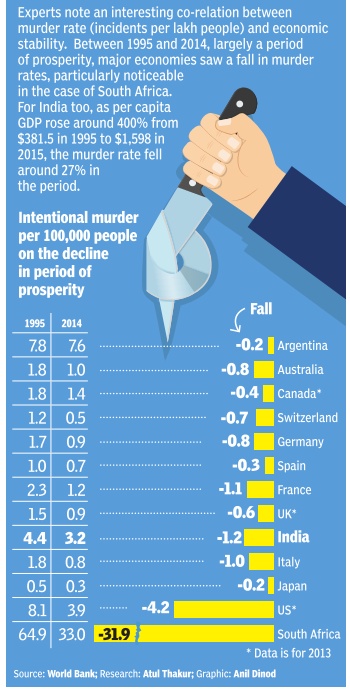
See graphic:
1995- 2015: as India’s per capita GDP rose 400%, the murder/ violent crime rate fell
[edit] 2011-16, thefts
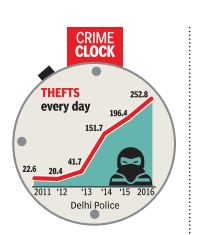
See graphic:
Thefts, every day, 2011-16
[edit] 2011-15, snatchings
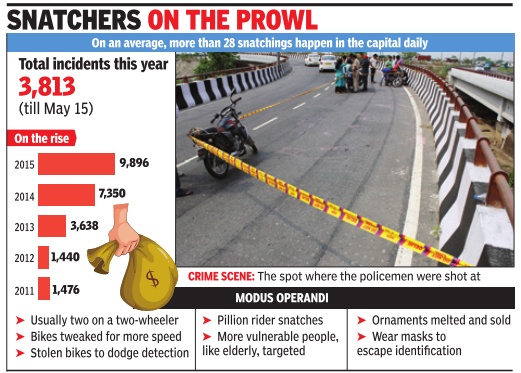
See graphic:
‘Snatchings’ in Delhi: 2011-15
[edit] 2012-17, crime in numbers
Rajshekhar Jha, December 16, 2017: The Times of India
See graphic:
i.) Crime in numbers, Delhi, 2012-17;
ii.) Steps taken by Delhi police for women's safety
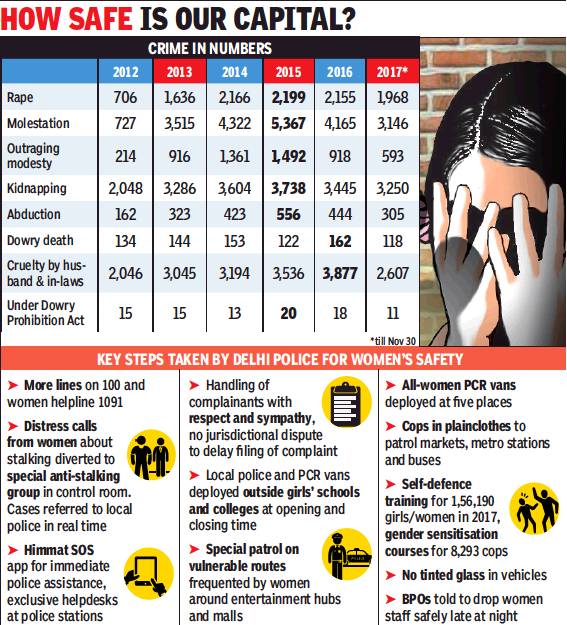
ii.) Steps taken by Delhi police for women's safety
From: Rajshekhar Jha, December 16, 2017: The Times of India
Five years ago, a 23-year-old paramedic student was raped and brutalised in a moving bus in south Delhi. The chilling December 16 event was a turning point for law enforcement in the capital. Delhi Police underwent an overhaul at the grass-roots level, and the effort to make the city safer for women is paying off.
In 2017, 1,968 cases of rape and 3,146 cases of molestation were lodged till November 30 against 1,992 rape cases in the same period last year (2,155 in the whole year) and 3,914 of molestation (4,165). The slide in the figures has come despite mandatory, free and easy registration of cases, so much so that police file FIRs even for complaints received on email. Till date, 2,174 people have been arrested on rape charges and 3,373 people for molestation.
The cops attribute the decline to a slew of measures taken by police commissioner Amulya Patnaik. “From setting up dedicated anti-stalking cells to initiatives like Sashakti for self-defence of women and Himmat app for easy access to us, Delhi Police has given top priority to women safety,” said the force’s chief spokesperson, Dependra Pathak.
DCP Madhur Verma added, “No jurisdictional dispute is allowed to delay police response to a complaint. Immediate action is taken by the officer on receipt of a complaint to apprehend the accused and to provide medical assistance to the survivor. Apart from attending to emergencies, staff on the 10 lines of 1091helpline also provides counselling.”
After December 16, 2012, policing “changed for the good,” said a senior cop who investigated that disturbing case. The case also led to the amendment of rape laws as recommended by the Justice JS Verma Committee set up after the incident. The amended laws ensured that cops felt duty-bound to assist rape survivors, beginning with the immediate registration of an FIR on receiving a complaint. Women can now also file complaints online — a slew of cases has already been registered based on email sent to police. They can also seek legal help from the police crisis cells. The growing awareness about legal remedies has resulted in more women reporting gender crimes.
The Verma Commission, after scanning 80,000 submissions from people in India and abroad, recognised the need to punish rape, molestation and other sexual offences such as voyeurism with imprisonment up to seven years. Stalking or unwanted attempts to contact a person repeatedly was made liable to three years’ imprisonment.
As for stalking, DCP Verma said that all distress calls related to stalking are diverted to a special anti-stalking group in the 24x7 central police control room. “From there, the staff calls the abusing number and deals with the aggressor in an effective manner, as demanded by most complainants. The cases are referred to the local police in real time through the cyber highway network,” Verma elaborated.
Besides deploying all-women PCRs at several locations, police also post male and female cops in plainclothes outside school and colleges when classes begin and end. There is special patrolling of the risk-prone routes taken by women returning from entertainment hubs and malls. To help them defend themselves, police facilitated self-defence training for 1,56,190 girls in 2017.
“The civic agencies are regularly being informed about poorly lit stretches of roads,” DCP Verma said, adding that 8,293 police personnel were given gender sensitisation training. The officer also disclosed that Operation Shishtachar — in which youths caught misbehaving with women undergo counselling by religious preachers and psychologists — had proved effective in reining in eve teasers.
[edit] 2013-14, cases solved

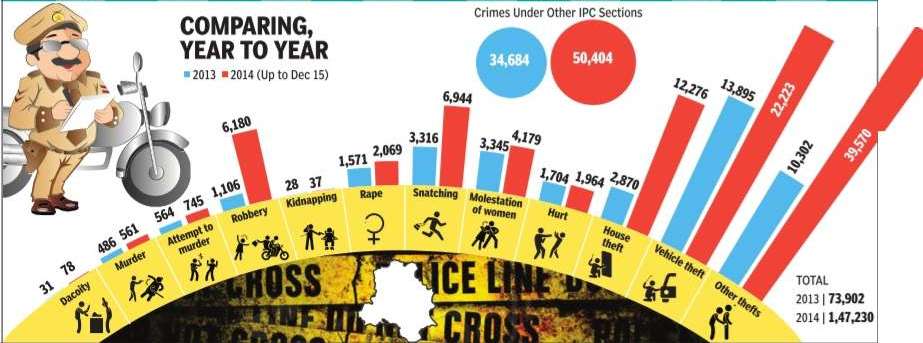
See graphic:
Delhi, 2013 and 2014: crime, cases solved and law and order
Delhi,crime: 2011- 2014
[edit] 2013> 2017, 2018 Jan-Sept
Major crimes down 25-70% in Delhi this year, claim cops, October 21, 2018: The Times of India

From: Major crimes down 25-70% in Delhi this year, claim cops, October 21, 2018: The Times of India

From: Major crimes down 25-70% in Delhi this year, claim cops, October 21, 2018: The Times of India
The crime situation in the capital appears to be well under control. At least, the numbers say so.
The crime data released by the Delhi Police shows a major dip in all major crimes till September 30 as compared to corresponding figures last year.
Not just that, many crimes, which had witnessed a constant rise in the last five years, have also gone down.
According to the police data, 1,639 cases of rape were registered till September 30 in 2018 as compared to 1,673 rapes last year in the corresponding period; 2,535 cases of molestation were reported against 2,610 cases in 2017.
Similarly, 357 murders were reported this year against 385 murders till September 30 last year; 487 murders were reported between January and December in 2017.
Cases of robberies and snatching on the roads of the capital have seen a huge dip from last year. From 6,772 snatching in 2017, only 5,034 cases have been reported this year. The corresponding figures in cases of robbery are 2,230 and 1,852.
550 less heinous crimes in capital than last year
Cases of burglary — which have always seen a rise since several years — have also dipped. From 14,307 cases in 2016, the numbers came down to 9,819 cases in 2017. This year, only 3,090 cases have been reported till September 30. Last year, the number was 8,327 cases in the corresponding time period. The police have not clarified whether the data released by them includes the e-FIRs or the crimes being registered online.
Vehicle thefts are only registered online at a virtual police station, which doesn’t exist in reality. As a result, this crime has gone up substantially over the years. From 20,449 cases till September 30 last year, 33,273 cases have been reported in 2018. This indicates that around 125 vehicles are being stolen every day.
Fatal accidents are on the rise as well. From 1,087 cases last year, 1,136 cases have been reported this year. Fatalities have risen by at least 10 per cent. Kidnappings of ransom have gone north too. From 15 cases last year, 17 cases have been reported till September 30 this year.
In an encouraging development, 4,295 heinous crimes have been reported this year against 4,853 cases last year till September 30. In 2014, this figure was 10,266 and 11,187 in 2015. It came down to 8,238 in 2016 and 6,527 in 2017.
[edit] 2015: Jan-May: dip in heinous crimes
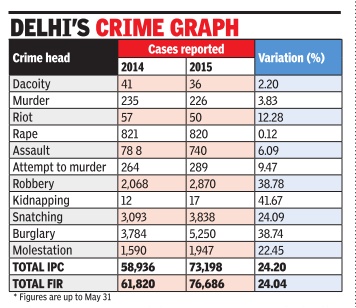
The Times of India, Jun 07 2015
Raj Shekhar
Capital witnesses dip in murders and dacoities
In a shift from the last five years' trend, Delhi has witnessed a dip in heinous crimes this year. Murders, rioting and dacoities--prime indicators of the law and order situation in a city--have plunged in the first five months of 2015. Delhi Police's half-yearly data reveals that murders have dipped by 3.83%. There were 226 murders in 2015 as compared to 235 cases in 2014 in the same period. Cases of rioting and non-communal violence between two groups of people have come down by 12%.
“There were 50 cases reported in 2015 whereas the count in the same time period (January 1-May 31) was 57.Cases of dacoity , too, have come down by 12.2%. There were 41 cases reported last year but the number this year is 36,“ special commissioner (law and order) Deepak Mishra said.
In 2015, fewer cases of police murders have also been reported. However, scuffles of the general public with policemen have increased this year. Free registration of street crime has led to increase in FIRs filed in cases of snatching and robberies.The snatching cases have ris en from 3,093 to 3,838 while robberies have risen from 2,068 to 2,870. From 12 cases reported till May 31 in 2014, kidnapping cases this year have gone up to 17.
Thefts and burglaries have seen an increase of 38% as police registered 5,250 cases from last year's 3,784 cases. Rape cases have come down by 0.12% as Delhi registered 1 fewer case than last year. This year, 820 cases have been registered till May 31.However, molestation cases have seen an increase from 1,590 to 1,947.
Analysis of heinous crimes suggests that sudden provocation was the leading reason for murders, accounting for about 21% of the killings. About 11% of murders were related to sex, 16% were murdered in enmity while 9% were killed in money-related matters, sources said.Property disputes, police claimed, caused 3% of murders. Crime-related murders were 8% of the total while 10% were due to family disputes. Unidentified dead bodies constituted 10% of the murders. The total number of IPC cases registered till May 31 has shot up from 58,936 to 73,198.
[edit] Heinous crimes, in detail
The Times of India Jan 05 2016
Anvit Srivastava
With 1,82,644 FIRs in 2015, as against 1,47,237 in 2014, Delhi last year witnessed a 24.05% increase in heinous crimes like robberies, rapes, attempt to murders and break-ins. Police record showed that 49,892 cases were solved.
Police attributed the increase in the number of cases to the “truthful registration“ of crime. A total of 7,192 cases of robbery , 541 cases of murder, 750 cases of attempt to murder, 73 cases of dacoity, 2,095 cases of rape, and 36 cases of kidnapping for ransom were reported last year. Police solved 3,367 robbery , 64 dacoity, and 415 murder cases.However, some of the grueso me cases, including the murder of two women whose bodies were found in northeast Delhi, remained unsolved.
An analysis of the motives behind the murders throughout the year showed that 16.64% of the cases were due to sudden provocation or trivial issues, 18.67% due to old enmity, 9.61% related to sexual indulgences, 13.49% due to differences among family members, and 9.61% as a result of disputes over property and money . Only 9.43% of the murders were crime related.
According to the record, 41% of the murders were committed using sharp-edged weapons, while in 18% of the cases, blunt objects were used.Strangling was recorded in 16% of the total murders, and in 13%, firearms were used.
[edit] 2015: Safest year since 2005
The Times of India Jan 05 2016
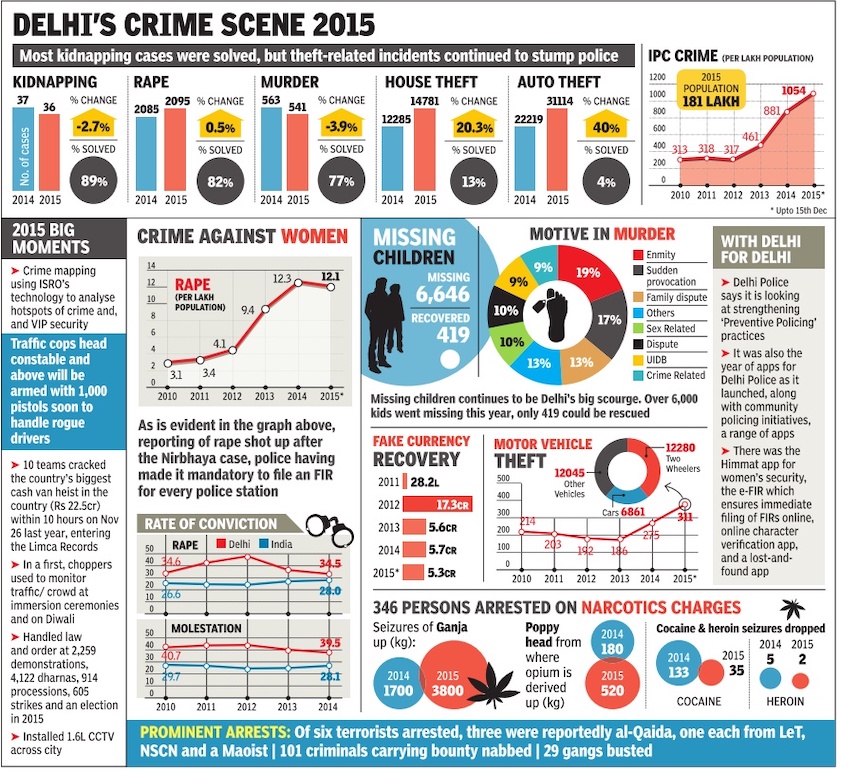
Somreet Bhattacharya
The vehicle count increased, but 2015 was the safest year in a decade in terms of traffic fatalities.There were 1,496 deaths in 1,532 accidents, as against 1,575 in 1,616 accidents a year ago. Police said strict enforcement of rules, including cancellation of licences, brought about the improvement, but data shows a 14% decrease in challans--from 42 lakh in 2014 to 36 lakh in 2015.
The eChallan system enabled police to identify repeat offenders, and more than 19,000 licences were seized in special drives recommended by the Supreme Court committee on road safety.In one of these `Chakravyuh' drives, more than 1,000 vehicles were challaned in a day.
Analyses of the accidents in 2014 helped police remove some of the causes. Road-owning agencies were asked to make changes on 137 accident-prone stretches.
Worryingly, the number of challans for drunk driving decreased by 11% from 2014; there were 24,960 chal lans till December 15 last year, as against 28,059 in 2014.While 707 licences were cancelled, 3,529 drunk drivers were sent to jail for 1-3 days, 21 for 4-5 days, seven for 6-9 days and six for 10 days. Another 38,224 reckless drivers were counselled on safe dri ving.
Police involved people in traffic policing through phone apps and their Facebook page, and 5,200 violations were reported by the public. Hired helicopters were also used for regulating and monitoring traffic movement during festivals in 2015.
1.9==2015>17: Despite dip, Delhi still the crime capital== Oct 23, 2019: The Times of India
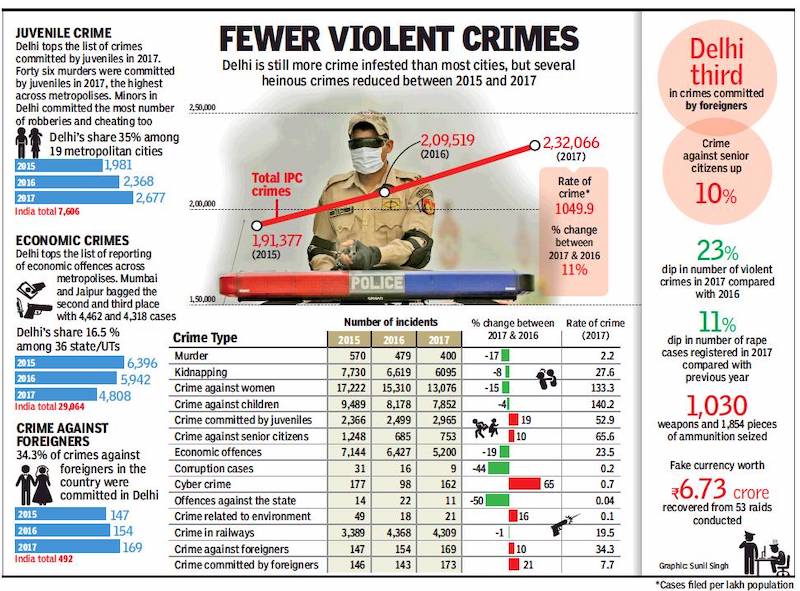
From: Oct 23, 2019: The Times of India
Delhi appears to have done enough to live up to its unwanted appellation as the crime capital of India, with the latest National Crime Records Bureau report, released on Monday, showing that around 1,050 police cases were registered for every lakh of population in the city in 2017 compared with a national average of just 238. Even though the rate of violent crimes slid, Delhi still accounted for 28% of the violent crimes reported in the metropolitan cities and for 40% of the Indian Penal Code crimes.
While the number of murder cases in 2017 dipped 17% and kidnapping by 8% compared with 2016, Delhi’s 400 homicides and 6,095 abductions still topped Mumbai and Bengaluru. Delhi Police also registered 1,229 cases of rape in 2017 compared with 287 cases in Mumbai.
Alarmingly, the number of crimes committed by juveniles rose to 2,965 in 2017 from 2,499 the previous year and 2,366 in 2015. The maximum crimes against senior citizens were also reported from Delhi with a 10% rise from 685 cases in 2016. Delhi also had the lion’s share, around 35%, of crimes against children in the metros.
While Delhi had the highest percentage (27%) of offences affecting the human body among metro cities ahead of Mumbai (10%) and Bengaluru (8.5%), it saw the most vehicle thefts in the country with 40,972 cases registered, two years after police introduced the lodging of e-FIRs for reporting vehicle thefts. Delhi also had among the most robbery cases (3,147) in the country and the most number of thefts in 2017 with 1,33,024 cases. Of this, 8,051 cases involved snatching. NCRB said there were 613 cases of attempt to murder and 36 cases of dacoity in the city. Of the 752 lost properties, only 76 were recovered by police, a worse record than in 2016 and 2015.
Delhi Police maintained that the rise in the crime statistics was actually the fallout of its several initiatives. “The figures indicative our pro-active policing, registration of e-FIRs and increase of police presence on the roads,” asserted Delhi Police spokesperson Mandeep Singh Randhawa. “The data shows a dip in crimes that are prime indicators of a city’s crime situation.” Police also cited data showing a decline of 28% in violent crimes and higher disposal of heinous cases to boost their claims.
[edit] Nov 2016: demonetisation reduced crime
Is demonetisation affecting crime in Delhi?, The Times of India 10 Dec 2016
According to police data, certain crimes in Delhi have shown a fall between November 9 - a day after the PM announced demonetisation - and December 8 of this year, as compared to the corresponding period last year. Most significantly, cases of extortion have almost halved. Others - including crimes against women - have shown a downward trend, too.
[edit] 2016: 26% decline in criminal activities
Heinous crimes dip 26%, south better off than north, Feb 14, 2017: The Times of India
To improve the law and order situation, Delhi, in 2016, was divided into two zones -north and south.The idea seems to have worked as far as certain crimes like murders and robberies are concerned.
Heinous crimes declined by 26% in 2016 as compared to 2015, Delhi Police data show.There were lower number of murders, snatchings and robberies too. In 2016, 9,571 cases of snatching were reported against 9,896 in 2015. Also, the number of murder cases stood at 528 against 570 in 2015, whereas 4,781 cases of robbery were reported against 7,407 in 2015. Cases of rioting (mostly non-communal) dipped in 2016 -numbering 79 against 130.
However, south zone fared better than north. According to data, south zone -headed by special commissioner P Kamraj -registered 87,910 cases under IPC against 1,11,581 in north zone, overseen by S B K Singh. Twenty-two cases of murder were reported in south against 24 in north. As many as 237 murders took place in south zone and 273 in north.The number of rape cases in south and north was 979 and 1,130, respectively.
Overall, registration of crime shot up by 9% in Delhi; 73% of these cases remained unsolved. As many as 2,09,519 cases were reported in 2016 against 1,91,377 in 2015. Alarmingly , 86% of vehicle thefts, 86% of house thefts and 40% of kidnappings remained unsolved. As much as 65% of snatchings, 23% cases of robbery , 40% cases of extortion and 14% cases of rape were not cracked.
Of the 14,307 burglary cases reported, only 2,405 were solved. Of the 9,571snatching cases reported last year, 6,207 remained unsolved. The detection rate of heinous cri mes increased to 12.82% in 2016, as police claimed that 71.67% cases were cracked. In 2016, 2,155 cases of rape were reported against 2,199 in 2015.
On terror front, Delhi Police's special cell, arrested 12 people in 2016. They also busted an ISIS module in early 2016 when B S Bassi was the police chief. Later in the year, the cell, along with NIA and Kerala police, busted another ISIS module.
Last year, counterfeit currency with face value of Rs 5.74 crore was recovered and 80 cases registered. The Crime Branch busted an espionage ring allegedly being run from Pak High Commission in Delhi.
[edit] 2017, Jan-May
Rajshekhar Jha, Cases of rape, molestation down in city in 2017, June 18, 2017: The Times of India
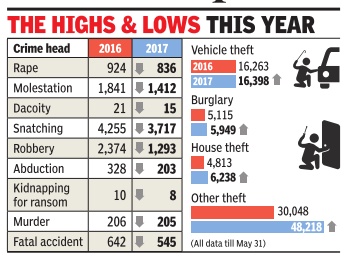
Crime against women seems to have reduced in the capital this year.According to figures released by Delhi Police, 836 cases of rape have been reported till May 31 compared with 924 in the same period last year. Mo lestation cases have gone down from 1,841 to 1,412.
The trend is attributed to a slew of measures taken by police commissioner Amulya Patnaik. These include deploying women patrol teams in markets, placing women officers in key posts and holding self-defence classes.
Heinous crimes such as murder and robberies have also declined: 1,293 robberies have been registered till May 31 compared with 2,374 in the first five months of 2016. The corresponding figures in case of murders are 205 and 206.
Street crimes, such as snatching, have reduced as well. A total of 3,717 cases have been registered in the first 150 days of 2017 compared with 4,255 last year. This means one case an hour is being reported on an average. The number of fatalities due to road accidents has gone down too: 545 people have been killed till May compared with 642 in fatal mishaps in 2016. Crimes like burglaries and thefts have in creased. Cases of burglaries have risen from 5,115 to 5,949 till May . House thefts have risen substantially from 4,813 to 6,238 cases in the first five months.
This is worrying as a little data crunching shows that last year there were 32 reported cases of house thefts daily in the first five months, but this year the figure is around 42 each day . It also means that two houses on an average are burgled in the capital every hour.
Vehicle thefts have risen again after being in check in April. From 16,263 cases till May last year, the figure has increased to 16,398. It means 109 vehicles are being stolen everyday in Delhi. Between January and April in 2016, 12,784 cases were reported and the figure stood at 12,666 in the corresponding period this year. This comes to around 105-106 cases a day .
Dacoities have fallen from 21to 15 and kidnapping dipped from 10 to 8 till May; 203 cases of abduction have been reported this year against 328 last year and 2,404 cases of kidnappings registered com pared to 2,505 last year.
The number of total heinous crimes have dipped from 3,837 to 2,638 cases. Non-heinous crimes such as thefts and burglaries have risen from 78,307 to 98,481. Overall, the total number of registered IPC cases have gone north from 82,144 to 1,01,119 cases till May.
[edit] 2018: Decline in crime ; More Cases Solved, More Registered
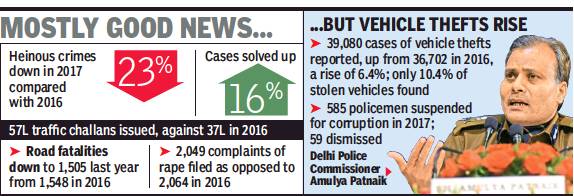
From: Rajshekhar Jha, Is Delhi safer? Police data shows fall in crime in 2017, January 12, 2018: The Times of India

From: Somreet Bhattacharya, January 12, 2018: The Times of India
More Cases Solved, And More Registered
The year 2017 has proved to be a good year for the police in Delhi. After several years, almost all genres of crimes — including crimes against women — have dipped, data released by the police at its annual press conference on Thursday shows. Road fatalities were down as well.
According to police data, not only have heinous crimes like murder, dacoity and robbery — the prime indicators of acrime situation in a city — gone down significantly but more cases were solved as well. According to police commissioner Amulya Patnaik, a focused approach to combating crime and strengthening groundlevel constabulary had resulted in this reduction.
“Street crime came under control with a sharp decline in robberies and snatchings by 21.05% in 2017. Insistence on concentrated investigation led to a high rate of detection of heinous cases, which was 87.98% in 2017, as compared to 71.81% last year,” Patnaik said. While the overall registration of crimes increased by around 12% from 2016, Delhi Police said it highlighted its efforts towards proactive and free registration of crime.
Patnaik attributed this increase to several factors, including online registration of crimes and the lodging of FIRs on complaints filed by email.
He also put out a vision of a tech-savvy police in the making as he announced that the much-awaited joining of a chief technical officer had already happened. Dr A K Mohapatra, earlier head of department (IT) at Indira Gandhi Delhi Technical University for Women, will be working with a special commissioner to speed up modernisation projects.
[edit] Overall
Cops arrest crime growth, but gaps a worry, January 10, 2019: The Times of India

From: Cops arrest crime growth, but gaps a worry, January 10, 2019: The Times of India
Police Chief Says More Cases Cracked In 2018
The capital’s police force solved more cases, made more arrests and resolved more pending cases in 2018 than in earlier years. At the annual police press conference on Wednesday, Delhi Police commissioner Amulya Patnaik declared that crime in the city was under control, but added that more efforts were on to plug the gaps that still remained.
Patnaik said he revamped the beat policing system and put officers of assistant subinspector rank in charge of their areas. He also said that Delhi Police collaborated with Quality Council of India to conduct a public perception survey get a feedback from the people on where the services delivered by the cops needed to be boosted.
Patnaik was happy to inform that 91% of heinous cases had been solved in 2018. “The detection rate in cases of kidnappings and dacoities was 100%, while 95% of rape incidents were solved and 86% of murder cases were cracked. Only 11% of murders were crime related,” he said.
The annual crime data showed that 91,291 people were arrested in 2018 against 84,999 in 2017, a rise of 7.4%. Also, 2,91,039 cases were cleared last year compared with 2,64,558 in 2017 and 1,81,806 in 2016. Overall, the police registered 2,36,476 cases under the Indian Penal Code in 2018 against 2,23,077 in 2017.
R P Upadhyay, special commissioner (law and order, south), added that 1,131 new history-sheets were opened in 2018 against 937 in 2017, while 120 absconding history sheeters were traced and 168 criminals carrying rewards on their heads arrested. The police also arrested 1,848 proclaimed offenders.
Data for 2018 showed heinous crimes dipping by 12%, dacoities by 36%, robberies by 20% and rioting by 54%. Kidnappings for ransom, however, rose by 35%. For consuming liquor in public, 33,873 people had cases registered against them.
Cracking down on organised crime was a priority, said special commissioner (Crime) Satish Golcha. He said 1,901 firearms were seized in 2018 against 1,318 in 2017, a 38% rise. “Under MCOCA, 17 cases were registered and 14 new proposals initiated, while 38 more criminals have been identified for action to be taken against them,” Golcha added.
The hiving off of law and order from investigation as a pilot project is aimed at improving the quality of investigation and to ensure that law and order remained in check. “This is currently being implemented in 30 police stations,” revealed Sandeep Goel, special commissioner (law and order, north). “This will help in timely disposal of criminal cases, better the conviction rate and improve coordination with the prosecuting agency.”
In 2019, Delhi Police will focus on curbing street crimes, disclosed Patnaik. Timewise and areas-wise mapping of incidents, ‘Raftar’ bike patrols at hotspots and strengthening of the anti-snatching teams are some of the measures that will be taken to bring down street crime.
Patnaik added, “We will also focus on technological upgradation, better service delivery and improved traffic management. Others on the top of the police agenda are the restructuring of the cyber cell for proactive action and modernisation of the training wing.”
[edit] Rapes decline for 2nd straight year, road deaths rise
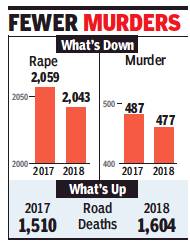
From: Rape cases decline in city for 2nd straight year, road deaths rise, January 10, 2019: The Times of India
Delhi, often called the country’s rape capital, has recorded a slight dip in the number of rape cases for the second year running. In 2018, the city registered 2,043 rape cases as against 2,059 the previous year.
However, the dip comes with the alarming revelation that rapes by relatives, immediate family members, friends
and neighbours — which police can hardly anticipate or prevent — have touched an all-time high of 97.5% of all cases. Conversely, strangers were involved in a record low of 2.5% of rape cases.
Presenting the annual crime figures, police commissioner Amulya Patnaik said on Wednesday that overall heinous crimes had gone down in 2018 by 12% while street crimes like snatchings and robberies declined by 18% and 20%, respectively. Murders, too, witnessed a marginal decline — from 487 in 2017 to 477 in 2018.
The traffic situation remained grim as fatal accidents rose from 1,491 to 1,562 in 2018. And these accidents killed 1,604 people last year as against 1,510 in 2017. Vehicle thefts too remained a cause for concern, registering a rise of around 13% last year — 44,158 cases as against 39,084 in 2017.
[edit] 2019
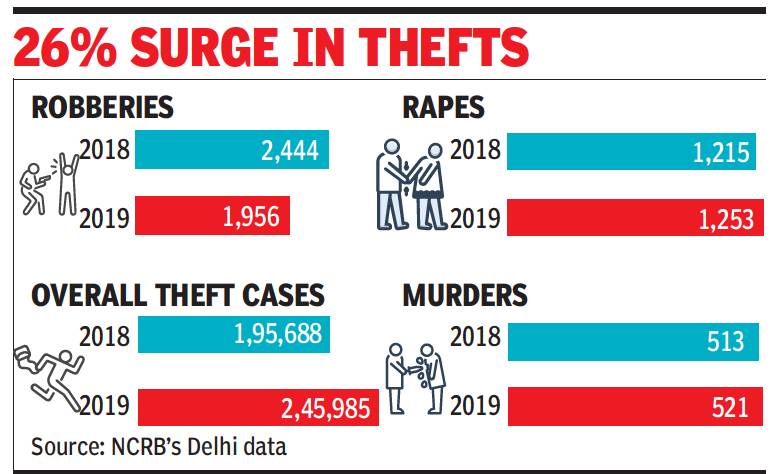
From: 20% spike in city crimes last year, but heinous offences down: NCRB, October 1, 2020: The Times of India
Cases of rapes in Delhi saw a rise of 3% in 2019 while overall registration of crimes in the capital witnessed a rise of around 20% in 2019 compared with 2018, data released by National Crime Records Bureau shows.
In 2019, 2,99,475 crime incidents were registered against 2,49,012 incidents in the previous year. However, overall heinous crimes saw a dip in registration. Robberies, for example, dipped with 1,956 cases last year against 2,444 cases reported in 2018. This is a fall of 20% but can be categorised as highest when compared nationally. In Delhi, the robbery rate — number of crimes per 100,000 population — in 2019 was 9.8 against the all-India rate of 2.3.
Last year, 1,253 cases of rapes were registered compared to 1215 cases in 2018, a rise of 3%. However, molestations came down in 2019 with 2,355 registered cases against 2,705 in 2018. In 2019, five cases of murders with rape were reported against three in 2018, NCRB data shows. 456 cases of sexual harassment were reported in 2019 against 552 in 2018.
Thefts 80% of registered crimes
Graft Cases Against Public Servants See 3-Fold Rise: NCRB
The NCRB data also shows that registration of “crimes against the state” witnessed a rise of 136% in 2019 compared to previous year. In 2018, 11 cases under this head were registered in Delhi whereas the figure jumped to 26 in 2019. Similarly, cases of corruption by public servants, which are registered under the Prevention of Corruption Act show a three-fold rise in 2019.
In 2018, six cases were registered under this Act where as 18 cases were registered in 2019, a rise of 200%. The incidents of vehicle thefts dipped slightly with 46,215 cases reported in 2019 compared to 46,433 cases in 2018. However, the rate of this crime per lakh population was recorded at 231.8 in 2019 against 17.8 nationally. The murders saw a marginal rise with 521 cases being reported in 2019 against 513 in 2018.
The data suggests that a big chunk of the overall registered crimes were those of thefts — 2,45,985 cases in 2019 against 1,95688 in 2018. The figures suggest that thefts constituted over 80% of the registered crimes. In 2018, a little over half the crimes pertained to thefts. The theft rate in Delhi was around 1,233 while the rate recorded nationally was merely around 50. Economic offences and cybercrimes showed a decline in 2019, NCRB data suggests.
Crimes pertaining to economic offences saw a slight reduction of around 0.5% from 4,918 in 2018 to 4,889 in 2019. The maximum number of cases reported were of forgery and cheating, 4533 cases were reported last year.
Also, registered cases of cybercrime saw a decline of around 35% from 189 in 2018 to 115 in 2019. In maximum number of cases, the motive of criminals was to dupe people, extort money and even revenge was seen as a reason. A total of 17 cases of online stalking of women were reported last year. Human and child trafficking cases reported a slight decline in 2019 with registration of 93 cases against 98 in 2018.
In the 93 reported cases, 536 of the victims were below 18. In many of the cases, the victims were in groups. In 2019, Delhi reported one custodial death and the person was not on remand. The NCRB, which functions under the Union home ministry, is tasked with collecting and analysing crime data as defined by the Indian Penal Code and special and local laws in the country.
[edit] Details

From: Nov 25, 2019: The Times of India

From: Nov 25, 2019: The Times of India
See graphics:
Crime in Delhi in 2019, vis-à-vis 2018: 1
Crime in Delhi in 2019, vis-à-vis 2018: 2
[edit] 2020
Sakshi Chand, February 20, 2021: The Times of India
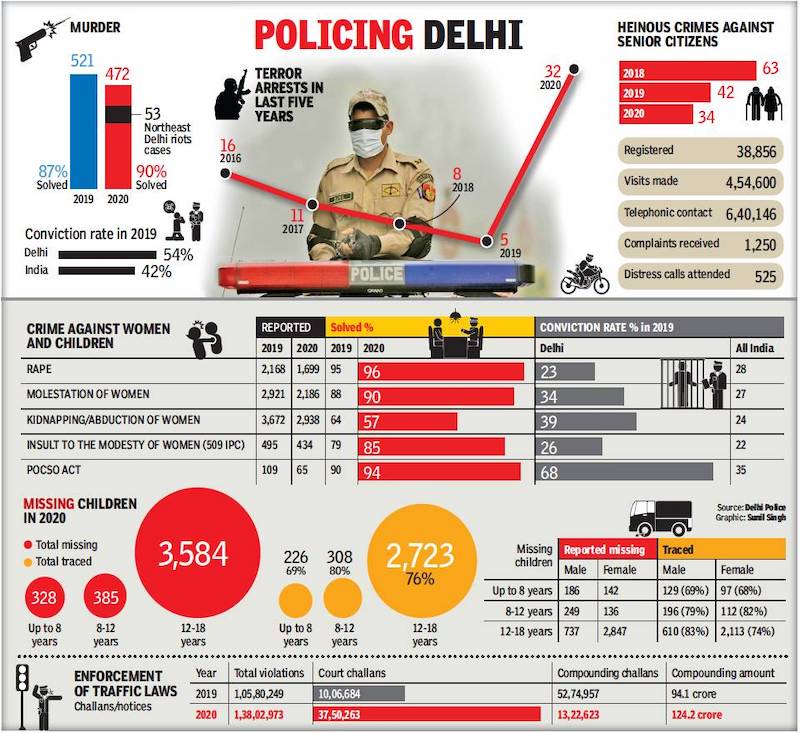
From: Sakshi Chand, February 20, 2021: The Times of India

From: February 20, 2021: The Times of India
See graphic:
Crime in Delhi in 2020
Crime in Delhi in 2020, the Covid year
When 2020 turned the corner, Delhi Police found itself engaged in a challenge that pitted its own against an insidious coronavirus. Police had not only to enforce the Covid-19 lockdown, but in doing so had to take care of its personnel. Its duties included policing the streets, securing containment zones, implementing social distancing, distributing food to the stranded and even handing out masks to the needy.
At one point of time, Delhi Police was managing around 2,500 containment zones, preventing people from stepping or moving around in the isolated area. To help the residents in such localities, police created WhatsApp groups and facilitated supply of essential items. All the while, the cops traced containment violators using geo-fencing technology and sometimes registered cases against them.
Around 31 cops succumbed to Covid and over 2,500 recovered after infection. Unfazed, police commissioner S N Shrivastava launched a plasma donation programme, urging personnel who had recovered to help others undergoing convalescent plasma therapy. The cops are still donating blood and plasma for Covid patients in Delhi.
An onerous task for the cops was caring for the stranded migrant labourers across the city. They not only provided meals, but also guided the beleaguered population to the nearest shelters. An even bigger challenge was moving the tens of thousands of migrants to the stations from where they could board special trains back home, all the while ensuring social distancing.
Amid all this, the cops also had to maintain law and order and carry out policing. It was a time when going to a crime scene was a hazard, especially if the crime had taken place in a containment zone. Apart from taking the mandatory precautions, police were able to carry out investigations, relying on extensive use of technology for the purpose.
Dedicated teams in each district tracked social media platforms like Twitter and Facebook and responded to the posts of people in distress. All police premises and colonies were regularly sanitised and complaints were heard from behind plastic barriers. Technology played a major role and complaints were accepted over video calls or online. Most of the cases registered in 2020 were online without police interface.
To motivate the force and their families, police organised wellness seminars and counselling sessions. Over one lakh Ayuraksha kits were distributed to boost the immunity of personnel, and yoga and pranayama camps were made mandatory at the district level.
Delhi Police also showed their humane side, and from June 15 last year till February 18 this year, it distributed over four lakh masks to the needy. Among other such exercises, it also reached out to those living alone, especially senior citizens. In a wonderful gesture, the cops made them feel supported amid the isolation by getting them cakes and celebrating their birthdays.
[edit] 2021 B
Sep 16, 2021: The Times of India
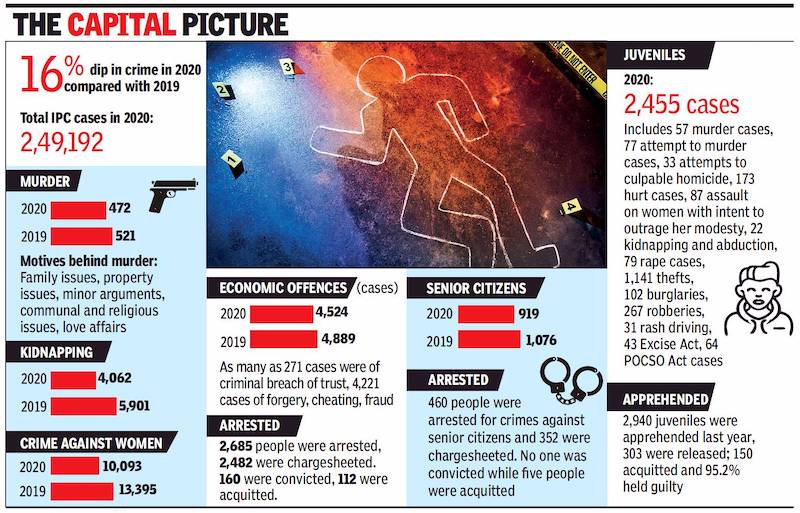
From: Sep 16, 2021: The Times of India
Crime in the time of Covid had a lesser sting for the city than the year earlier. The patrolling of the capital’s roads to enforce pandemic regulations appeared to have kept street crime and crimes against women in check. However, perhaps because of the online dependence for most activities during the period, cybercrime saw a relative spurt. These trends were revealed when the National Crime Records Bureau statistics for 2020 were released.
Cases of rape reported by women dipped by 21% in Delhi in 2020 in comparison with the previous year. The overall crimes against women in Delhi went down by 24%. Cybercrime, however, saw a significant rise of 55% in the city. The Covid lockdown in 2020 was a major factor that deterred street criminals and those who would commit crimes against women. NCRB put the number of crimes against women in 2020 at 9,782, much lower than the 12,902 reported in 2019.
Against 1,231 cases of rape in 2019, there were a much lower 967 last year, a dip of 21%. Cases of assault against women also slid to 938 in 2020 from 1,088 the previous year. Women also reported 644 cases of sexual harassment when in 2019 they had registered 862. There was also a significant 40% decrease in cases of stalking in 2020. The data shows that 235 cases of stalking were reported to the cops against 388 the previous year.
Police officers believed these were the result of Covid measures such as intensifying night patrolling and tightening security on the streets round the clock. “Patrolling and checking were intensified at night,” an officer said. “Police presence was also adequately enhanced to prevent untoward incidents in localities.”
Across 19 metropolitan cities in India too, there was a 21% decrease in crimes against women, according to the NCRB data. Against the total of 44,738 cases recorded in 2019, there were 35,331 cases of crime against women registered in 2020. The data shows that 30.2% of these cases pertained to either cruelty by husband or his relatives while 197% were cases of assault on women with intent to outrage her modesty. Kidnapping and abduction of women followed with 19% and 7.2%.
The lockdown and the restrictions placed on public interactions also played a vital role in keeping street crimes low in 2020. “Through the lockdown and despite the pandemic, our personnel stood guard on roads and in public for the safety of Delhiites," the officer said.
Cybercrime, however, soared by 55% in Delhi. Against 107 reported crimes in 2019, there were 166 in 2020. A major chunk of these crimes — 59 in 2020 — related to transmitting of sexually explicit content on the internet. Such cases had numbered just19 a year earlier.
Cyber fraud too saw an upward trend, increasing to 31 cases from 11, though cyber stalking cases fell to 12 from 16 in 2019. Cases of online bank frauds also increased to 19 in 2020 from a mere two the previous year.
“There was a rise in the various categories of cybercrime in 2020,” a police officer said. “One of the reasons why online crimes went up was also due to the lockdown. We detected numerous cases of fake job rackets, fake lotteries, people being duped while being promised Covid medicines and home delivery of other items when the city was at a standstill. Our cybercrime teams in each district registered and probed all cases diligently. Arrests were made in most of these cases."
[edit] 2021
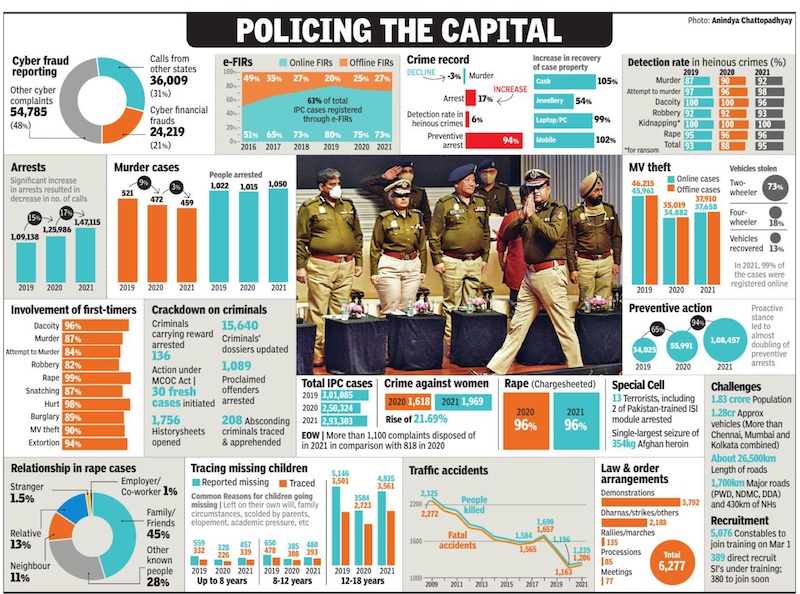
From: February 25, 2022: The Times of India
See graphic:
Crime in Delhi in 2021; 2019-21
[edit] Arms, illegal
[edit] 2016> 2018
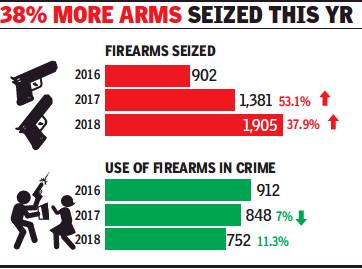
From: Somreet Bhattacharya & Sidharth Bhardwaj, Cops stem the flow of illegal arms into city, January 8, 2019: The Times of India
Steady action and improved coordination with the police of crucial states appear to have helped Delhi Police stem the flow of illegal weapons into the capital, and consequently their use in crime. According to police data, 752 crimes involved the use of guns in 2018 compared with 848 in 2017 and 912 in 2016. Concurrently, the recovery of weapons doubled from 902 in 2016 to 1,905 in 2018, with confiscation of 1,381 weapons in 2017.
Realising that the suppliers of clandestine arms used different routes to sneak into the capital, Delhi Police took up the issue of the origin of illegal weapons in their states with the DGPs of Madhya Pradesh and Bihar. Coordination with the cops from UP and Haryana was also tightened because of which, police in these states were able to crack down on suppliers based in the districts bordering Delhi.
“Police commissioner Amulya Patnaik has instructed all units to ensure a strict crackdown on the influx of weapons in the city,” said Madhur Verma, spokesperson, Delhi Police. Accordingly, the directive has stemmed the bulk flow of weapons to the capital, reflecting in the dip in the usage of fire arms in crimes in the past year.
The Special Cell of Delhi Police also made steady inroads into gunrunners’ operations. In all, in 2018 the cops arrested 1,901 people with illegal weapons against 1,141 in 2017 and 782 in 2016.
In June 2018, a gang supplying knockoffs of Glock 17 pistols with ‘Made in China’ tags was apprehended. Its members bought the weapons in Nepal and crossed the border at Sanauli in SUVs to bring them to India. In August, the Special Cell busted a mega gun racket and retrieved 50 sophisticated pistols.
Some of the weapons recovered were found to be made in factories in the National Capital Region, a shift from the traditional weapons markets in Bihar’s Munger, MP’s Khargone and Rajasthan’s Sri Ganganagar. While 65 pistols were seized from a factory in Ghaziabad, a manufacturing unit that a former Bihar arms supplier had set up in Karawal Nagar was closed down.
[edit] Automobile thefts
[edit] 2014-16, vehicle thefts
The Times of India, Apr 15 2016
A vehicle is stolen every 13 mins in city; rate up 44% since 2015
Rajshekhar Jha If you haven't yet secured your car with highend anti-theft devices, now is a good time to do it. A vehicle was stolen every 13 minutes in the capital in the first three months of the year, marking a sharp 44% rise over the same period last year. Only around 4% of these cars are recovered.
Delhi saw 9,714 vehicle thefts in the the first quarter of 2016, up from 6,724 in the first three months of last year. By April 13, the number had crossed 11,000, according to police figures.
Investigators blame the spurt on the creation of an app to register vehicle thefts, which has taken the pressure off local police stations to prevent and solve these cases.Car-theft investigations have virtually come to a standstill as no particular thana is held responsible any longer for unsolved cases.
The app automatically gives the user an untraced report after 21 days. For the app, introduced by the previous police chief, an e-police station was created and it became the `central agency' for handling vehicle thefts. The lax policing situation in the capital has led to it attracting car thieves from outside, according to police sources. The Meerut (Sotiganj) gangs are learnt to have devised a new way to crack open new electronic locks of high-end cars as well.
The app needs to be done away with or at least tweaked, the sources said, so that the responsibility for thefts goes back to the police.
Investigators accept the situation is grim. Lack of deterrence has emboldened thieves so much that they are using techniques and gadgets to override the modern anti-theft systems. Not only do they carry duplicate electronic keys but can also neutralise engine control modules (on-board computers) in fuel-injected vehicles in a few minutes.
“In 1990, a vehicle was stolen in New York City every 3.5 minutes, but new anti-theft technologies and a police crackdown ensured a 95% fall in vehicle thefts by 2013. Now, a vehicle is stolen in NYC once every 72 minutes. In Delhi, the focus is on doing away with probe,“ a senior cop said.
Motor vehicle theft makes up a fifth of all IPC crimes reported in Delhi and it is getting better organised by the day .
All that thieves need is a window of 3 hours to dispose of a stolen vehicle, sources said. Late at night, they can cross over into Haryana or UP from any place in Delhi within half an hour. Then, getting the vehicle to a salvage yard in places such as Meerut takes only about an hour more. Using deft hands and machines, the yards take apart a car in no time, and the chances of it be ing traced thereafter are practically nil. While many of the stolen vehicles are dismantled for parts, some are sold in Nepal, the northeast, and also Bihar and West Bengal.
Till 2014, five-six gangs from Sotiganj in Meerut, and other areas in Uttar Pradesh and Haryana, were active in Delhi, operating in twos and threes. Today , the thieves travel in sedans in groups of sixseven. They are armed to the teeth and take away two-three vehicles in a go.
The outlying police districts that share borders with neighbouring states have higher vehicle theft rates, with the maximum cases reported from east and northeast districts that abut UP . While the theft rate has shot up, the recovery rate remains abysmal.On average, if 100 vehicles are stolen, only four are traced.
In 2014, 22,223 vehicles were stolen in Delhi and 6,019 of these were cars. At the end of the year, 2,322 were found. In 2013, the number of stolen vehicles was 26,330. It was 24,231 in 2012, and 26,729 in 2011.
[edit] 2017: 120 thefts daily (i.e. 1/5 of all crime). Only 8% cases solved
Up to 120 vehicles stolen in capital daily, say police, February 25, 2018: The Times of India
New Delhi: Vehicle thefts remain a challenge for Delhi Police in 2018 with an average of 110-120 vehicles being stolen in the capital every day. In 2017, this crime was a major issue for the police. Less than 8% of vehicle thefts are solved by cops.
Till February 15, 2018, Delhi Police recorded 4,970 cases of vehicle thefts as against 40,692 in 2017. Though cops believe the increase in number of cases is due to the online registration of FIRs in vehicle theft cases, to take off the pressure from local police stations, investigations, however, have been moving at a slow pace. Last year, cops recovered only 10% of the stolen vehicles.
Motor vehicle thefts account for nearly one-fifth of the total number of cases registered under the IPC in Delhi. A few years back, cops had conducted a raid at Sotiganj near Meerut and caught around four gangs from Delhi that were using the place as a hideout to dismantle the vehicles.
The bordering districts of Delhi are most prone to vehicle thefts with the most number of cases being reported from parts of east and outer Delhi.
Cops have identified 10-15 gangs of vehicle thieves that outsource their activities to smaller gangs. The stolen cars are taken to Meerut, north-east states and Nepal where they are dismantled or sold off.
Investigators too have a few points about the causes of the rise in vehicle thefts, one of them being unavailability of parking spaces in residential areas. People’s indifference and “police-may-care” attitude is also listed as one of the reasons. Other reasons include reluctance of people to spend money on installation of security devices, secondhand market of vehicles in other states, re-registration of stolen vehicles in some states without completion of procedural formalities and unavailability of fixed registration number plate repainting on time.
Delhi Police has undertaken several initiatives to catch vehicle thieves. These include identification of affected places and time zones and proper deployment of staff in these areas; barriers put up at vulnerable spots; manufacturers requested to install security devices at showrooms and offices; parking attendants have been sensitised and educative advertisements in newspapers and radio channels have been distributed.
[edit] 2018: Over 44k vehicles stolen, only 4.6k found
January 10, 2019: The Times of India

From: January 10, 2019: The Times of India
Delhi Police has cited lack of parking space inside colonies and inadequate neighbourhood security as reasons behind the 13% rise in auto thefts in 2018. Last year, 44,158 vehicles were stolen against 39,084 in the previous year.
While 6,751auto lifters were arrested in 2018, cops could recover only 4,619 stolen vehicles. Vehicle thefts accounted for 19% of total IPC cases registered in Delhi. Delhi Police data reveals that around 12% of the vehicles recovered from Delhi were stolen in the National Capital Region.
In total, 1,46,707 e-FIRs for vehicle thefts have been registered since the inception of the online facility in April 2015. Last year, cops recorded 43,801 e-FIRs for vehicle thefts. E-courts have accepted 1,22,255 untraced reports through the e-FIR app that allows complainants to file their claims before insurance companies.
The data also reveals that two out of 10 vehicles stolen in the city are cars, while seven are two-wheelers. A majority of the vehicles were stolen from outside colonies after dark last year.
“The increase in the number of fancy cars has made them an easy target for vehicle thieves. Non-availability of parking spaces in residential area, reluctance to spend on security devices, no fixed registration numberplate and a growing second-hand car market play a major role in the absorption of stolen vehicles,” Delhi Police PRO, DCP Madhur Verma, said.
Vehicles stolen from Delhi were disposed in Uttar Pradesh, Bihar, West Bengal, J&K and Northeast states. Cops have undertaken several initiatives to curb this crime. This includes identification of affected places, time of thefts and deploying staff to deter vehicle thieves.
Police have also requested vehicle manufacturers to install security devices, like GPS tracking systems, before the cars leave the factories or showrooms. The record of stolen vehicles has also been computerised and shared with police forces of the neighbouring states to keep a lookout for them.
Last year, parking lot attendants were sensitised to detect stolen vehicles. Police have also been coordinating with insurance agencies for honouring claims for stolen vehicles.
The Delhi Police data revealed that two out of 10 vehicles stolen in Delhi were cars, while seven were two-wheelers. A majority of vehicles were stolen from outside colonies after dark last year. Non-availability of parking spaces in residential areas also contributed towards this crime
[edit] CCTVs help solve crime
[edit] 2018
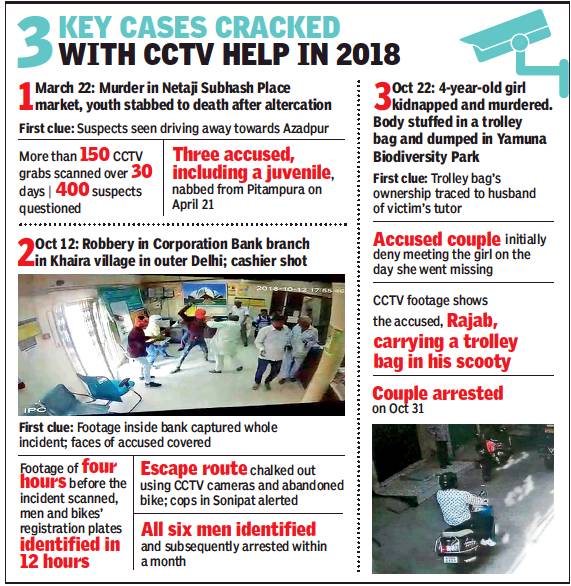
From: Sidharth Bhardwaj, Dim lights, camera, lot of action: Meet these footage warriors looking for clues in low-res, February 18, 2019: The Times of India
TECH TONIC: A Day In The Life Of Cops Using CCTV To Solve Crime
It’s 5am on a chilly January morning as a heavily bearded man in tattered clothes enters Netaji Subhas Place police station. As strange as it seem, the sentry welcomes the ragged fellow with a salute. Eavesdropping on their conversation reveals that the man is actually head constable Jairam Yadav, who has come after spending a night in the slums of Jahangirpuri. He has some clues to a murder of a man in the area and wants to confirm this through CCTV footage.
As a welcome cup of hot tea arrives, Yadav plugs in a USB drive that contains recordings from closed-circuit television cameras in the vicinity of the murder site. “CCTV footage has become a crucial aspect of investigation these days and has contributed to the solving of 60% of cases,” he says, as he constantly pauses, forwards and rewinds the images on the computer, his eyes peering at the screen for clarity on the registration number of a car.
Yadav, who recently got an out-of-turn promotion, is credited with having solved 109 cases and is a member of the emerging breed of cops with expertise in analysis of CCTV footage. This work is an inseparable part of investigation now, with the city covered by a network of CCTV cameras. In fact, as Yadav reveals, “The first step in a probe is to see if CCTV cameras are installed near the crime spot.”
All revelations by informers are correlated with CCTV video. “We determine, for instance, the possible escape route of the miscreants,” says Yadav. “On lucky days, we can identify the wrongdoer on the first few clips. Otherwise, the analysis can go on for months.” While investigating one murder case, Yadav pored through the output from over 100 cameras for a month before nailing the killers.
Yadav and his team members often divide the work. He mingles with informers and criminals on the streets — often disguised, as he was in Jahangirpuri — while the others tackle the technical investigation. But both are after details that corroborate each other, such as the colour of vehicles involved, the routes used, the attire and physical appearances of suspects, etc.
The technical investigation requires the cops to quickly get their hands on films from cameras installed privately or by government agencies. Explaining the difficulties they face, inspector Naveen Kumar, whose team solved the bank robbery in outer Delhi’s Khaira village in October last year, reveals, “Recordings of CCTV cameras get deleted or overlapped after three days, a week or 10 days. The race is to get them as quickly as possible before the evidentiary value is nullified.” The inspector adds, “Also, the specific time at which the suspect might have passed the vision field of the camera is not known, and we often have to sit through six-seven hours of footage to get a glimpse of them.”
Equal importance is given to footage from before the time of the incident. Inspector Vinay Yadav, while narrating how his team solved the robbery of a cash van in northeast Delhi’s Welcome, explains that professional criminals often case the area before executing a crime and are caught by CCTV cameras in their unguarded moments. “During a robbery, criminals may mask their faces,” Vinay Yadav says, “but they usually go about uncovered before that. Footage can show us their faces and help us identify them.” However, for all the expertise of these footage warriors, the lack of high-definition cameras still slows down their work.
Staring at the computer screen for hours at a stretch, their eyes focused on blurry images, does not make for a comfortable workday. Besides, as police doctors have noted, repeated exposure to gory images — of death, violence and antisocial acts — take an emotional toll on the men. But as head constable Jairam Yadav shrugs, “We signed up for this. Of course, the disturbing images keep playing in our heads. But it’s all part of our job.”
[edit] Children, missing
[edit] Crime against senior citizens
[edit] 2017, till June
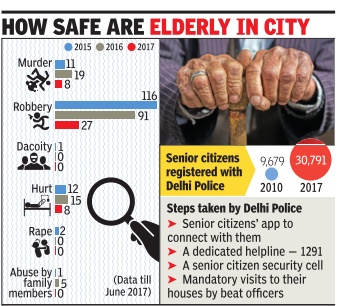
The data show 65% dip in crime against senior citizens in the capital this year compared to 2016.
Besides arranging regular visits by beat constables, Delhi Police has an Android app that not only keeps records of elderly people but also help them alert cops during emergencies. On International Day of Older Persons on Sunday , the police organised interaction programmes with senior citizens in all districts to make them aware about safety issues.
According to senior officers, with such measures the crime graph against senior citizens has dipped from 162 in June 2015 to 149 during the same period in 2016 to 52 this year.
Till June 1 this year, cops have registered 30,791senior citizens. Among them, 4,938 stay in west Delhi, 4,348 in south Delhi, 3,871 in east, 2,965 in northwest, 2,248 in southwest, 2,295 in southeast, 743 in northeast, and 1,427 people in central Delhi. Shahdara and Rohini police have 1,925 and 2,295 senior citizens registered with them.
Police commissioner Amulya Patnaik have asked officers to ensure regular in teractions with elderly people. The police are also trying to make the app more interactive. It already has an SOS button with which an elderly person can alert the area beat constable about any trouble.
The beat officers are required to click a selfie with newly registered senior citizens that will be uploaded to the data bank with a unique code for each person. A beat policemen can use the app to access the list of senior citizens living in his locality along with their addresses and phone numbers.The app also ensures that all visits by the local beat officers are logged and reviewed.
[edit] Crimes against women
The Times of India Jan 05 2016
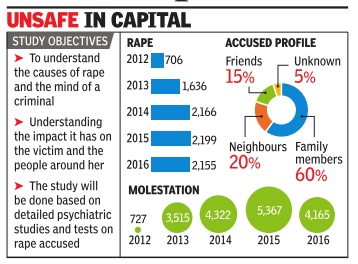
Somreet Bhattacharya & Anvit Srivastava
TNN
The capital saw a rise in crime against women in 2015 compared to the previous year. While 5,192 cases of molestation of women were reported last year, the number was 4,322 in 2014.
However, most cases were solved well in time. More than 70% of the crimes against women were worked out and chargesheeted within the fortnight of reporting the incident, police claimed.
In 2015, the number of rape cases reported was 2,095 as against 2,085 in 2014. Of the 2,095 cases, 1,715 were solved.In the data published by Delhi Police, 2,024 rapes were committed by the family members or people known to the victim, and 71accused were strangers. An analysis of the data showed that 50% of the victims were aged between 18 to 25 years.
According to the analysis, of the 2,095 rape accused, 911 studied till Class X and were between the age group of 18 to 25 years; 1,195 were from a poor economic background. A total of 86.73% of the rapes took place in houses or at slum clusters, and 3.29% at hotels and restaurants.
Of the total 5,192 molestation cases, 838 were solved.Police said 460 cases were solved within a week of registration of the FIR. According to the records, 39.25% molestation occurred on roads, while nearly an equal number at houses.
Delhi Police conducted gender sensitisation programmes in 2015 under which 11,130 boys were sensitised. It also held several selfdefence programmes for women at schools and colleges across the city . Besides, an operation to identify sexual offenders on roads and bus stops was also conducted under Operation Shishtachar.Women police officers in civvies were posted at busy vulnerable places.
Delhi Police also launched Himmat app in February last year using which the victims could make SOS calls to alert police.
[edit] 2014: rape cases, an increase
Jan 03 2015
Nitisha Kashyap
The year 2014 not only saw a considerable increase in the registration of rape cases, but also a majority of the cases being solved well in time. Be it the Danish woman's gang rape case with which the year started or the cab rape with which the year ended, the accused were arrested within 48 hours. Cops said hesitation in getting a rape case registered has come down. Survivors are also helping police with important details like photos or a description of the accused.
Police chief BS Bassi said 78% cases were solved within a fortnight. Around 61% rapes and 62% molestation cases were worked out within a week. Cops said the accused were known to the victims in 96% rape cases. In approximately 72% rapes, the crime was committed by a relative or a friend, while in 21% the accused was a neighbour.Cases of rape by employers or co-workers constituted 3% of the total.
Bassi has proposed compulsory self-defence training in schools for girls. For safety of women travelling in public transport, police has introduced Special Squad for Women Protection. This squad travels in civvies in buses to ensure no girl is being harassed.
In 2013, till December 15, 2,069 cases of rape were reported--a 31.7% increase over 2013 when 1,571 incidents were registered. Police claim to have solved 80.57% (1,667 of 2,069) of them. The number of molestation cases went up to 4,179, an increase of 24.93%, against 3,345 in 2013. Police claim to have solved 67.17% (2,807 of 4,179).
Currently , there are 859 pa trol vans to assist women travelling late or stranded. Police have also deployed motorcycle patrols, emergency response vehicles for women's security . Police officials are also posted outside girls' schools and colleges.
[edit] 2014: Rapes in Delhi
The Times of India, Aug 20 2015
Crime shoots up, women bear brunt
Somreet Bhattacharya
460 more rape cases in 2014 than in 2013
The year 2014 started with the gang rape of a Danish tourist and ended with the rape of a woman executive by the driver of her app-based taxi. All through the year, there were 2,094 other rapes--an alarming increase of 28.1% over 2013, NCRB data shows. In absolute terms, the number of rape cases increased by 460. Overall, complaints of crime against women increased by 18.4%, from 12,888 in 2013 to 15,265 in 2014. Police say cases were registered on almost all the complaints last year. Rape cases were registered on 2,096 of the 2,102 complaints and 1,667 cases were solved.
Young girls and women aged below 30 years were tar gets in about 87% of rape cases. Nearly half of the survivors were aged below 18 while 71 were aged below six.The number of minors raped in the city increased sharply from 757 in 2013 to 1,008 in 2014. Police claimed the accused were known to the survivors in 1,083 cases.
Molestation cases also shot up by 24.9%, from 3,345 in 2013 to 4,179 in 2014. Police claimed to have solved 67% of the molestation cases. Besides these, there were 4,227 cases of women and minor girls getting abducted.
While crime against women shot up, police claimed to have arrested 90% of the accused in rape cases, often within 48 hours.
The city police have 1,000 patrol vans and the staff has instructions to assist women travelling late or stranded on the way . Police also use motorcycle patrols and emergency response vehicles for women's safety . Personnel are positioned outside girls' schools and colleges and Delhi Police has proposed compulsory self-defence training in schools for girls.
Cops in plainclothes have started travelling in buses to catch youths passing lewd remarks and misbehaving with women under Operation Shishtachar. Recently , such a drive was launched in Metro trains also.
[edit] 2018
January 10, 2020: The Times of India
NEW DELHI: More number of crimes against women was reported in the national capital in 2018 compared with the previous year. Delhi Police registered 13,640 cases of crime against women, which was almost 4.7% more than the 2017 figures.
As per NCRB data, as many as 1,215 cases of rape were registered in 2018 compared with 1,168 cases of rape in 2017. Delhi also reported more cases of crime against women per one lakh population in 2018 as compared to other metropolitan cities, with 149.6 cases being registered per lakh population.
Police say that measures like removing dark patches of road and immediate registration of cases on basis of a complaint by a woman have led to the rise in the number of cases reported.
In most of the cases registered in 2018, the accused were either a family member, friend, neighbour or a person known to the victims. Out of the 13,640 cases, 1,215 cases of rape and 11 cases of attempt to rape were reported. Besides this, 3,416 cases of cruelty by husbands or relatives, 3,715 cases of kidnapping of woman, 2,705 cases of outraging the modesty of a woman, 18 cases of women-centric crime on the internet and 153 incidents of dowry death were reported. Investigation in at least 20,940 cases from the previous year is still pending and a case has also been reopened for investigation. The rape of a 20-year-old visually impaired girl at her residence in Central Delhi by her neighbour had sent shock waves in the city. The accused had entered her house on the pretext of asking for sugar. According to NCRB, the crime against girls also saw a rise with 394 more cases reported in 2018 compared with 7,852 the previous year.
In 2018, 8,246 cases were reported out of which 1,839 cases were of Protection of Children from Sexual Offences Act (POCSO), 52 murders, 72 of human trafficking and 687 of outraging the modesty of a child under sections of POCSO. In September 2018, a woman had accused a self-styled godman of raping her and molesting her daughter, which was shifted to crime branch.
[edit] Crime inside buses
[edit] 2011-17
Rajshekhar Jha|No law to deal with snatching in city|Jul 11 2017 : The Times of India (Delhi)
[edit] 2015: CCTVs bring down crime
The Times of India, Mar 10 2016
Rumu Banerjee
CCTVs in DTC buses bring down crime graph
After a failed GPS experiment, technology finally seems to be working for the Delhi Transport Corporation (DTC). A pilot project of installing CCTV cameras in 200 buses has not only resulted in improvement of staff behaviour, but even general security . “Two depots -Sarojini Nagar and Rajghat -were part of the experiment.Both have reported an improvement in the efficiency of the staff as well as a drop in the number of crimes, like pick-pocketing,“ said RS Minhas, the DTC spokesperson.
The report has been compiled from the time the CCTV cameras were installed in the DTC buses. Minhas said the first camera was installed in November 2014. “Since then, 200 buses have been fitted with the CCTVs. We plan to install it in all buses over the next few months,“ he added.
From schoolchildren fighting inside the bus to incidents of mobile theft and pick-pocketing, all the recordings have been kept or handed over to Delhi Police.The report shows that the first incident recorded was of a cellphone theft in No vember 2014, followed by a fight between schoolchildren in December.
Disputes between passengers, against the conductor or driver, as well as accidents with other vehicles have been recorded and resolved as per the CCTV recordings, says the report.“Even incidents of tyre bursting or windows being broken have been recor ded,“ said Minhas.
The project has had a positive impact on operations.“Efficiency has gone up, schedules are being kept, buses get parked in the right slots in depots and behaviour of staff has improved. Even passengers are well-behaved as they know about the CCTVs,“ he added.
The biggest achievement, perhaps, is that the CCTV cameras have not been removed or stolen like the GPS devices that were installed on DTC buses a few years ago.
[edit] Crime in metro
[edit] By women, 2016
The Times of India, December 15, 2016
In 2016, 532 women thieves caught in Metro
Anvit Srivastava
The Central Industrial Security Force has detained 532 women and identified 10 to 12 all-women gangs who were caught committing thefts in trains in 2016 alone.
That's a frequency of near ly two detentions every day . In fact, women gangs are four times more common than their male counterparts on the Metro network, said Raghubir Lal, DIG CISF (DMRC unit).
Despite 246 cases reported this year, police have failed to take further action as most vic tims avoid filing written complaints, the CISF said. Senior CISF officials said the women worked in groups of six or seven, usually operating at busy Metro stations during peak hours to avoid being identified. CISF officials said the women pickpockets in the Metro usually have a set modus operandi.
“Case studies and CCTV footages reveal that these women target a person and then board the Metro after himher.They surround the target and one of them feigns illness or an emergency situation to engage the target, while two of them steal valuables with the rest providing cover,“ said a senior CISF officer. He said the gang then disperses and gets off the train one by one at different stations to avoid suspicion.“These gangs operate only in moving and heavily crowded trains, which makes it difficult for us to trace them immediately after a commuter reports his or her valuables stolen,“ the officer said.
Lal said despite the huge number of detentions, these women cannot be prosecuted as there are not enough complaints filed against them.“These women target small valuables. Small pouch purses carried by women passengers or cash are the most commonly stolen items. Victims avoid filing an FIR as it's a time taking process. In case they alert the station controllers about the theft, they are contacted and the items are returned if recovered by our crime and intelligence wing,“ Lal said.
The DIG said after every detention, the Delhi Metro Rail Police is contacted but they can't take these women into custody without officially booking them for stealing.
The Delhi Police, however, says in many cases CISF recovers the stolen items and returns these to its owners.“They should rope in the police who would file a theft case. Only after that should the victim get back his belongings from court. Unless this practice is adopted, we can't take action.Not filing complaints is a problem that's preventing us from curbing the menace,“ said Jitender Mani, DCP Metro.
DIG Lal said it was difficult to keep these women away as they enter as normal passengers after buying tokens. “In cases where complaints are filed, like the theft of jewellery worth Rs 22 lakh on December 9, the FIR was registered and the gang arrested. We can stop these accused from entering stations as they now have a criminal record. We request victims to file a written complaint with the DMRP ,“ the DIG said. Lal said vigil has been raised in Metro stations after the jewellery theft.
Officials said women pickpockets are most frequently seen at the Inderlok, Shadipur, RK Ashram, Shastri Nagar and Seelampur stations, and live in cluster settlements near these spots.“Questioning of these women has revealed that most of them are migrants from Maharashtra, Chhattisgarh and Bihar.Many of them have drug-addict husbands or are staying alone,“ said an officer.
[edit] Crime at weddings
[edit] 2012-16

The Times of India
Please see graphic People killed by bullets fired at wedding celebrations in Delhi NCR, 2012-16
[edit] Crime in Delhi, region-wise
[edit] Anand Vihar stretch: 2017-18
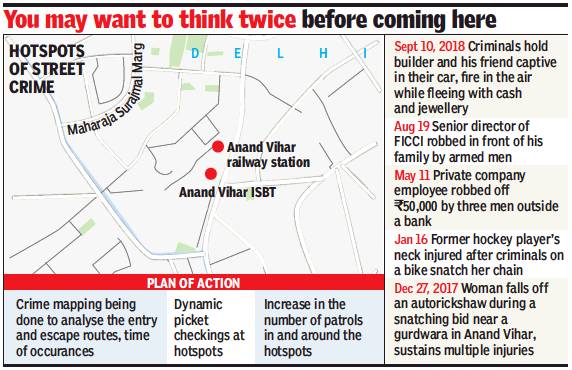
From: Sidharth Bhardwaj, Why this Anand Vihar stretch is a hunting ground for criminals, September 25, 2018: The Times of India
The areas adjoining Maharaja Surajmal Marg in Anand Vihar seem to have become a crime hotspot. Residents claimed that people coming to spawning eateries and liquor shops in the area often became easy targets of criminals.
The latest victim, Jasdev Singh (29), a resident of Jagatpuri, said he had gone for a movie with his wife in a Honda Civic car and just stopped near a mall on Maharaja Surajmal Marg to relieve himself when two men on a motorbike knocked at his window on the pretext of asking for a direction.
As Singh rolled down the glass, the pillion rider snatched the car keys while a third person pointed a pistol at him and told him to hand over his wife’s gold jewellery. While fleeing, they told Singh that they would throw the car keys a few metres ahead and he could pick it up later.
DCP (Shahdara) Meghna Yadav said a robbery case had been registered. “We are taking extra measures in the area to curb the menace,” she added. Cops admitted that wide roads and desolate stretches allowed criminals easy escape routes, and they often crossed over to UP through the Ghaziabad border.
The road, connecting Nand Nagri in northeast Delhi to Jagatpuri, has a mix of residential and commercial complexes. An officer said more than a dozen liquor shops on the stretch often attracted criminals to this area.
“The shops are brimming with customers since the morning and the crowd only surges as the night falls,” said a tea vendor, who has been running the business outside the mall for a few years. TOI found people drinking either in the open or inside their vehicles. The criminals active in northeast Delhi often drive to these areas, rob people drinking inside the car and return quickly to their hideouts, said an officer.
Another hotspot identified by the police are the areas around Anand Vihar ISBT and Anand Vihar railway station. Local shopkeepers said while only pickpocketing incidents were reported around the ISBT and station complexes, snatching and robberies often took place in the crowded areas lying ahead. The favourite target of criminals here are migrant labourers who come to the city for a better future.
[edit] South-west: Land wars
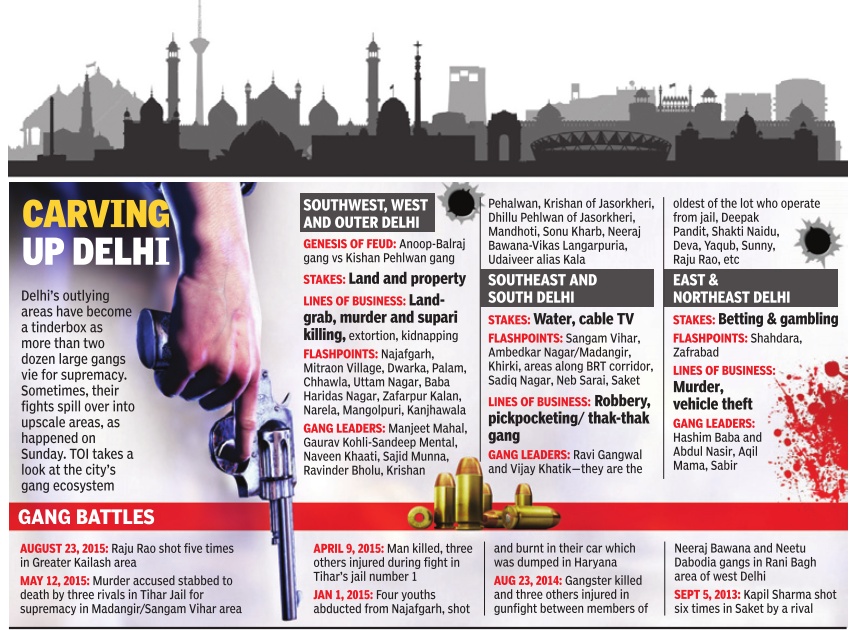
The Times of India, Aug 25 2015
Raj Shekhar
Land at root of SW Delhi's blood-thirst
Gangs across the city have been fighting for supremacy in different lines of business, but it all started in southwest Delhi 20 years ago as two men tried to monopolize land deals Life is cheap in southwest Delhi. As property prices in Najafgarh, Dwarka, Kanjhawala, Narela, etc continue to shoot up, more than a hundred lives have been lost in gang battles for control of the booming real estate market. Police say half of the gang wars in the area have been fought over property disputes and land-grabbing. All the gangs work to a pattern: first occupying a piece of land and then offering to help the owner recover it for a share in the property. This has been going on for almost two decades, but police seem unable to curb the lawlessness in a culture of clans and vendetta.
“This small cluster has defied all norms of public order for more than two decades now.While people in the rest of the city rely on patrol cops and the 100 helpline in crises, here they practise eye-for-an-eye,“ a policeman who has observed southwest Del hi's gang wars over the years said.
Gangs first formed in the area in the early 1990s as a result of the rivalry between two men, Kishan Pehlwan and Balraj. “The tension escalated into a killing spree over issues rooted in land disputes. Even the rivalry between Pehlwan and Balraj arose from a running feud between their families over 12 acres of land,“ a special cell officer said.“Pehlwan, though, changed the rules of the game as his men allegedly killed Balraj, his brother Anoop and others from the rival group in a span of a few years.“
The Balraj gang hit back by killing Pehlwan's uncle Rami and some others. But finally Pehlwan prevailed in southwest Delhi through the 90s and the noughties. The feud between these two families also alienated their villages, Mitraon (Balraj) and Dhichau (Pehlwan).
“In 2007, Pehlwan became even more powerful as his brother Bharat Singh was elected a municipal councillor. Next year, he became an MLA on an INLD ticket,“ the officer said.Pehlwan and his wife Neelam were also elected councillors in 2009 after he got arrested.
But in the years since Pehlwan's rise land had Pehlwan's rise land had become too valuable to be controlled by just one gang.New groups were form ing, and in 2012, the Anoop gang led by Udaiveer alias Kala made an at tempt on Bharat's life. The MLA was wounded but survived. A year later he lost the assembly election setting off the family's decline. The Pehlwan clan was soon reduced to one among many outfits in the Najafgarh area.
From 2013 onwards, the gangs got into the protection business, covering landowners who paid them and attacking those who didn't.There was a spate of killings to settle property disputes. The gangsters demanded a share in the new unauthorized colonies that were coming up.
Gangs led by Naveen Khati, Ravinder Bholu and others along with Manjeet Mahal, Sandeep Men tal and Vikas Langarpuria became active in the area. Older gangsters like Neeraj Bawana, Neetu Dabodia and Manoj Morkheri were already active in the area.
As these gangsters and local politicians declared all-out war to capture the real estate business, the area's villages became a ticking bomb. Four youths were murdered on New Year's Eve in 2014 as a result of the rivalry between the gangs led by Naveen Khati and Ravinder Bholu.Pehlwan's brother Bharat Singh was also bumped off in another attack.For southwest Delhi's new gang order, bloodshed over the most trivial issues is no big deal.
[edit] The worst affected areas
[edit] Parks safe haven for criminals at night
See graphic
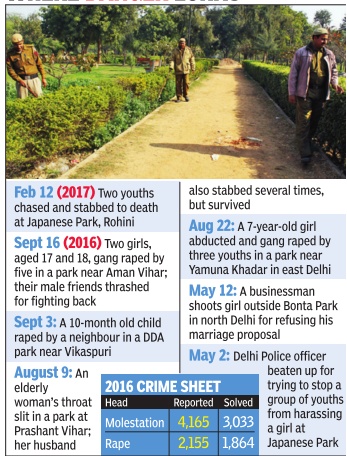
[edit] Crimes that shook Delhi’s conscience
See graphics:
1. The Priyadarshini Mattoo murder
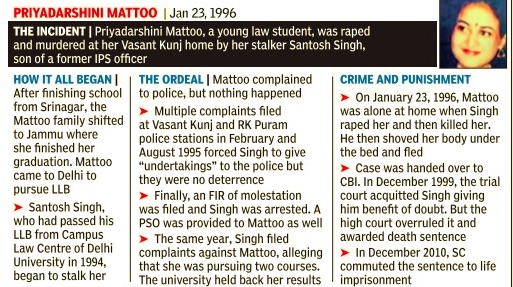
2. The Radhika Tanwar case

3. The Geetika Sharma case
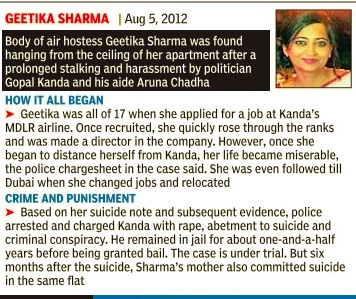
4. The Karuna murder case

5. The Riya Gautam murder case
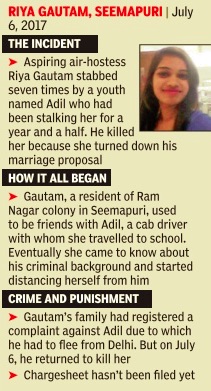
[edit] Cyber-crime
[edit] 2016-18: cases, and those solved
Cyber cell fails to crack 80% of cases, January 7, 2019: The Times of India

From: Cyber cell fails to crack 80% of cases, January 7, 2019: The Times of India
In 2 Yrs, Just 71 Of 327 Cases Taken To Logical Conclusion
The track record of Cyber Cell of Delhi Police was abysmal in the year 2018 as out of the 160-odd cases registered, the unit managed to complete investigations in only 26 cases. Moreover, the department has winded up the probe in just 21% cases in the past two years. This was revealed in an answer given by Delhi Police to a question raised in Rajya Sabha.
The data compiled by Delhi Police states that out of 327 cases registered from 2017 to November 30, 2018, the probe was only concluded in 71 (21.7%).
The number of offences being registered showed a jump from 138 in 2016 to 167 in 2017. In 2017, the unit could only complete investigations in 45 cases and nine cases were moved for cancellation or termed untraceable. At the end of November 2018, the number of cases registered was 160, but probe was concluded in only 26. Five cases were cancelled or termed untraced.
Delhi Police officials put the blame for the delay in investigations on getting information from websites, internet service providers, social media portals and telecom firms. However, sources said that the limited technical knowhow of Cyber Cell members is proving to be an obstacle and resulting in slowing the investigation process. This had also become an issue during the hearing of a case in court recently.
The Cyber Cell’s poor performance is also being attributed to the infighting within the unit that was attached with Special Cell early in 2018 with much fanfare. The disputes had become a talking point in the corridors of the police headquarters.
In the first month, the unit busted various cybercrime modules ranging from Bitcoin con to illegal Ethereum rigs. They had even cracked open a J&K-based hacker group. However, the success story didn’t last long as officers were shifted out and the cases began to pile up.
Sources said a major dent was how the infrastructure was barely put into use. A cyber forensic mobile van, equipped with the latest capabilities to probe hacking, digital extortion, ransomware and identity thefts, was launched last year. However, sources in the unit said that it has barely moved and covered a distance of just around 100km till December. The van stands in the parking lot gathering dust.
[edit] 2016>17
Oct 23, 2019: The Times of India
Fraud was the motive behind most of the cyber crime cases — 45 — registered in Delhi in 2017, followed by extortion, revenge and playing pranks. In all, 162 cases were registered with the cyber crime cell of Delhi Police in 2017 against 98 in 2016.
According to the latest National Crime Records Bureau (NCRB) report, sexual exploitation of women were reported in 32 cases, out of which nine were found to be related to cyber stalking and 13 to pornography. The cell registered 14 cases of identity theft, eight of cheating using a computer device and 34 cases of publication or transmission of obscene and sexually explicit act in electronic form. No case was lodged under the head of cyber terrorism.
In 2017, the cops probed 394 cases of cyber crime, including some pending from the previous years, and arrested 105 people, out of which only two were convicted. Chargesheets were issued in 68 cases.
The cell disposed of 566 cases, including the ones pending over the past few years. Out of the solved cases, 46 were computer-related, 19 fraudrelated and 17 were connected to publishing or transmitting sexually explicit content.
In the same year, Delhi Police launched a dedicated website where victims of cyber crime can log in and lodge a complaint. A cyber laboratory providing assistance to deal with cyber crime cases was also set up in 2017.
[edit] Drugs
[edit] 2018: Four-fold rise in heroin seizures
January 10, 2019: The Times of India
Drugs gave Delhi Police a headache through the year. There was a fourfold rise in seizure of heroin over 2017 — the police seized 196.7 kg of heroin as against 51.6 kg in 2017. There was a spike in the seizure of opium as well — it shot up by three times in 2018. The police recovered 53.7 kg through the year as against 19.6 kg in 2017.
According to police data, 493 cases were registered last year under the Narcotic Drugs and Psychotropic Substances (NDPS) Act compared to 362 in 2017. The number of people arrested under the Act also shot up significantly — 662 smugglers were arrested as compared to 491 in 2017. Many foreign nationals were among them.
Among the major operations against traffickers of heroin, the special cell busted a ‘Golden Triangle’, seizing high-grade heroin worth Rs 100 crore from two smugglers. They were bringing the drug from Myanmar into India through Assam and then transporting it to Delhi in trucks.
The cops said such contraband is being used as a source of revenue by Maoists. In July last year, the special cell busted a module transporting opium and poppy straw from Jharkhand to Punjab via Delhi. Two men
were arrested and 12 quintals of poppy straw worth about Rs 10 crore found.
Ganja, too, was on a high with 4,272 kg recovered as compared to 2415 kg the previous year. TOI had earlier reported about the rise in usage of the contraband with highquality concentrates of the contraband being made.
Recovery of charas, however, declined with cops seizing 14.1kg as against 58.4 kg in 2017.
[edit] Economic offences
[edit] 2015>17
Rajshekhar Jha , Oct 23, 2019: The Times of India
Kanpur, long famous for its sweet shop called Thaggu Ke Laddu, lived up to the thug reference with 28 cases of counterfeiting in 2017. But the real thug capital was Delhi. The city not only was way above Kanpur in the number of counterfeiting cases with 65, but the capital also topped the economic offences chart in the National Crime Record Bureau data for 2017 with 4,808 cases among metro cities, relegating Mumbai and Jaipur to the second and third place with, respectively, 4,462 and 4,318 cases.
The 2017 figure gave Delhi an unenviable 16% share of the total economic offences reported across India’s states and Union territories. Despite this, the capital actually logged a drop in economic offences given that in 2016 and 2015 such cases numbered a higher 5,942 and 6,396, respectively. According to NCRB, 4,379 cases of forgery, cheating and fraud and 364 cases of criminal breach of trust were registered in 2017.
Among cases involving economic offences, Delhi reported one case where the worth of the property involved was over Rs 100 crore, while three others were between Rs 25-50 crore. In 11 cases, the loss was estimated at Rs 10-25 crore, and in 93 cases, between Rs 1 crore and Rs 10 crore. There were 298 instances of defraud of Rs 50 lakh-1crore, 1,303 cases of Rs 1-10 lakh and 571of Rs 10-50 lakh. The highest number of cases, 1,545, involved losses of under Rs 1 lakh.
However, Delhi Police did not properly dispose of these cases. The NCRB data revealed that though 3,743 people were arrested for these offences in 2017, only 2,880 were eventually charge-sheeted. Of the arrested, 77 were women, of whom 63 had a charge-sheet filed against them.
The courts convicted 963 people of economic offences, while discharging 72 and acquitting 27. Not a single woman was convicted, while two were discharged and acquitted.
Investigation was poor and slow in 2017 if the NCRB data can be interpreted in this manner. Delhi Police dealt with 4,808 cases reported in 2017 but had 13,408 cases from the previous years for which the investigation was pending. Police also opened three cases for re-investigation that year. In total, therefore, the cops probed 18,219 cases in 2017. No other metropolis had so much pending investigation work.
The data also showed that police submitted a final report in 245 cases of economic offences, stating they were of the nature of civil disputes or “mistake of fact”. Eight cases were transferred to other states, while one was withdrawn by the state.
[edit] Foreigners, crimes by and against
[edit] 2017
Oct 23, 2019: The Times of India
Delhi is noticeable for both crimes against foreigners as well as crimes committed by foreigners. In 2017, crime data for which was released by NCRB on Monday, over one-third of the crimes against foreigners in India took place in the capital. Conversely, Delhi was third in terms of crimes committed by foreigners.
Of the 492 cases where foreigners were crime victims, Delhi accounted for 169. The capital was followed by Maharashtra and Tamil Nadu, which registered 61 and 43 cases, respectively. Places like Andaman Islands, Tripura, Puducherry, Daman & Diu and Jammu & Kashmir did not report a single crime against foreigners.
There has been a constant rise in such crime in Delhi since 2015, when 147 cases were reported, rising to 154 in 2016. Most of these pertain to theft, cheating, forgery and robbery. Delhi also registered 173 cases of foreigners committing crimes, behind West Bengal and Karnataka. Most of the foreign nationals arrested were Bangladeshis, who were involved in 2,725 crimes, while 193 were from Nepal, 162 from Sri Lanka and 70 from Pakistan.
The cops rescued seven trafficked Nepalese and one Bangladeshi among the total of 404 rescued while being trafficked in and out of Delhi.
[edit] Hoax calls
[edit] 2015- 2019, Aug
Somreet Bhattacharya, August 21, 2019: The Times of India
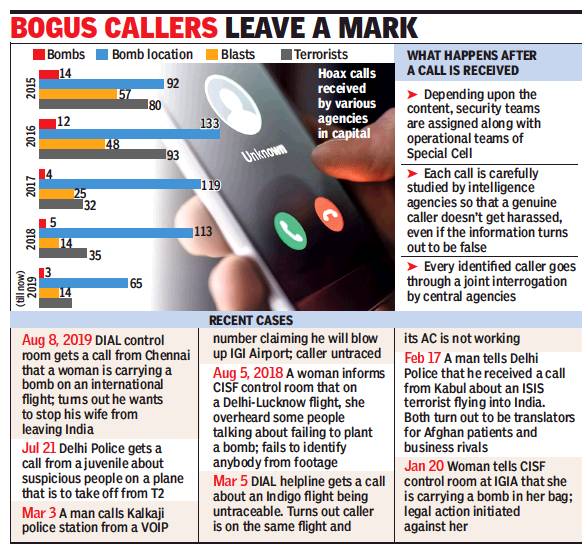
From: Somreet Bhattacharya, August 21, 2019: The Times of India
A few months ago, a man called up the Delhi Police’s control room, informing about an Islamic State terrorist named Baryalai Zeyarkash entering India on a flight from Kabul. The caller gave specific details like the flight number and the time of arrival. Police and the intelligence agencies swung into action, and a man from Kabul by the name mentioned by the caller was indeed found on the flight. While one team started looking for the caller, the other began to scan the antecedents of the suspect. Two days later, it turned out that the caller Mohammed Akbar, a resident of C R Park, had a rivalry with Zeyarkash, and he wanted to implicate and harass him.
Hoax calls have become a major headache for Delhi Police and intelligence agencies. In 2018, they had received 132 bomb-related calls, while they have already received 82 this year. Similarly, 35 terror-related calls were received in 2018, while this year 24 such calls have already landed in the control rooms of various agencies.
Officials say that these calls consume the stretched resources of different wings of the police, intelligence agencies and other security agencies as full protocols are followed for every call.
“Depending upon the contents of the call, bomb disposal team, sniffer dog squads, aircraft crew, CISF and quick reponse teams apart from SWAT commandos are pressed into action, apart from the operational teams of the Special Cell. Every identified caller is put through a joint interrogation along with intelligence agencies to fully examine his intent and the content of his communication,” Delhi Police spokesperson Mandeep Singh Randhawa said. Many agencies also get involved because the point of landing of such calls are many, including control rooms of DIAL, CISF, police and customer care numbers of airlines.
A new trend that has been noticed by the agencies of late is the use of voice over internet protocol (VOIP), which makes it impossible for them to track the callers. At times, these calls are made to virtual private networks (VPNs) using proxy servers that take the cops on a wild goose chase. Even e-mails are used.
An assistant sub-inspector at the Kalkaji police station had recieved a call from a VOIP number 0034602091721 in which the caller had mentioned about a plot to blow up the IGI airport. Immediately, teams from central security agencies, bomb disposal squads, SWAT and the special cell were pressed into action. The airport was scanned, but no explosives were recovered. Cops also couldn’t trace the caller.
Many a times, cops have even found that the owners of the SIM card used in making hoax calls were innocent. “It is of fundamental importance for police to carefully study the caller so that a genuine caller doesn't get harassed,” says DCP Manishi Chandra.
[edit] Holi and crime
[edit] 2017: 2 deaths, 11,000 violations
Crashes kill 2, 11,000 booked for violations, March 15, 2017: The Times of India

1,096 Vehicles Impounded
Holi in 2017 saw two fatal accidents in the capital. In the first incident, a 10-year-old boy was crushed near Dabri while playing Holi; in the second incident, a man on a scooter was mowed down by a speeding car in Patel Nagar.
The boy , Prince, was crossing the Sitapuri Chowk with his father Guddu and another woman when a car hit them. The father and son were flung to one side of the road while the woman escaped with minor injuries.Prince sustained a fatal head injury . The two were rushed to a hospital where Guddu was released after treatment but Prince was declared dead on arrival. A case of causing death due to negligence was registered.
The second incident occurred at a Patel Nagar roundabout where one Mayur Agarkar lost control of his car and rammed a scooter that had one Bhim Sain (53) riding it. Sain was hurt on the head and Agarkar took him to a hospital. But Sain didn't make it and was declared dead on arrival.
Agarkar later said in his statement that he was returning him from a market with his wife and mother-in-law when the incident occurred.
Apart from these two accidents, 11,570 drivers were booked for violating traffic norms by 200 police teams.Traffic police impounded 1,096 vehicles and 7,000 people were booked for riding without helmets, drunk and dangerous driving.
Police said strict action was being taken also against those found jumping signals, triple riding and performing stunts on two-wheelers. Senior officers had monitored the traffic arrangements as well.
[edit] Illegal immigrants
[edit] 2017: 1,134 arrested
Vishal Sharma3, 1,134 illegal immigrants nabbed in 4 yrs, September 25, 2018: The Times of India
With general elections not far off, the issue of illegal Bangladeshi immigrants is being repeatedly raised in political speeches. But just how many Bangladeshis are living illegally in the capital? Nobody seems to know for sure, certainly not Delhi Police.
The police have no conclusive data on the number of illegal immigrants in Delhi. What they can say for certain is that they captured 1,134 illegal Bangladeshi migrants in the past four years, who were sent to Bangladesh via the Foreigner Regional Registration Office.
These figures were cited in response to an RTI query by Zeeshan Haider, director of the Public Movement Organisation.
A separate “Bangladeshi cell” was formed by Delhi Police some years ago to monitor illegal Bangladeshis. Initially, this cell was operating in only a few districts. As more instances of illegal voting came to light, the cell became active in all districts about 10 years ago. But this activity has failed to translate into many detentions. Just one illegal Bangladeshi immigrant was arrested in New Delhi district four years ago, and jailed in a criminal case.
[edit] Juvenile, crime by
[edit] 2013, an increase in juvenile crime
Juveniles, cyber crooks keep police on toes
Raj Shekhar & Somreet Bhattacharya New Delhi:
TNN
The Times of India Jul 02 2014
More Minors Involved In Rapes; Most Offenders Fall Under 16-18 Age Group
Cases involving juvenile offenders have increased by 28%--2,140 minors were tracked down in 1,590 criminal cases registered in 2013. In 2012, the figure was 1,541 against 523 cases.
In 2013, most juveniles were charged with theft as has been the trend. Unlike 2012, they were found to be involved in more rape cases than murders.
Of the 2,140 juveniles apprehended, 2,087 were found to be involved in cognizable offences; 697 were sent to home after admonition and advice, while 301 were released on probation. As many as 692 juveniles were sent to special homes, 17 faced fines and 149 were acquitted; 267 cases are pending.
Among those apprehended, 821 had dropped out of school at the higher secondary level; 599 were primary school dropouts, and 421 were illiterate.
As many as 1,774 were found to be also living with their parents, while 69 were homeless; 849 children were found to have a family income below Rs 25,000 a year, while 714 belonged to the in come group of Rs 25,001-Rs 50,000.
In 2013, juveniles were involved in 928 cases of theft, burglary or snatching, followed by 163 cases of rape and 76 murder cases.
In 2012, the figure was 1,144, of which 523 were involved in theft, followed by100 cases of murder and 63 of rape.
The NCRB statistics reinforce the need to bring down the juvenile age limit to 16, which Delhi Police has been demanding since the Nirbhaya case.
Out of 2,087 apprehended juveniles, 1,148 were in the age-group of 16-18. In 2012, this figure was 860. Nationally, 66.8% of the juveniles are in this age group.
Among the apprehended juveniles, 875 were boys between 12 and 16; the figure was 617 for 2012. The cops apprehended 23 girls of different ages for various crimes. In 2013 and 2012, juveniles were found to be involved in rapes, gruesome murders of elderly people and robberies.
Around a dozen escapes from correctional homes were reported in the last two years.
Delhi Police has requested juvenile justice boards and child welfare committees to put in place stronger rehabilitation programmes at correctional homes so that minors can be weaned away from criminal activities.
Senior police officers made this request to Child Welfare Committee officials during a sensitization programme.
In a programme conducted by the Delhi police earlier this year, the principal judge JJB-II, Suchi Laler, had even asked the counsellors to find out the reason behind children resorting to crime and had called for educating the parents too.
[edit] 2015>17
Rajshekhar Jha , Oct 23, 2019: The Times of India
Hinting at the failure of welfare scheme for children of a vulnerable age executed by Delhi government and Delhi Police, the city topped the number of crimes committed by juveniles in 2017. With 2,677 cases, Delhi accounted for 35% of such crimes in metropolitan cities.
There has been a steady rise in this category of crime in Delhi, with NCRB data logging 1,981 cases in 2015 and 2,368 in 2016. The data showed that minors committed 46 murders in 2017, the highest across the metropolises, and committed the most robberies and fraud among the metros.
Delhi Police has implemented schemes like Yuva and enrolled juvenile delinquents or vulnerable minors in vocational programmes to prepare them for employment. The state government too has schemes to wean youngsters away from crime. However, the data suggests these weren’t as successful as hoped for.
This is evidenced by the highest number of juveniles apprehended in Delhi. In 2017, the number of minors held by police was 3,268. The cops also apprehended 1,611 juveniles whose cases were pending investigation from the previous year, taking the total number of minors held to 4,879. No other metro city came close to this figure. Pune lagged in second place with 1,949 followed by Mumbai with 1,702 apprehensions.
The data showed that 752 of the apprehended juveniles were illiterate, while 1,084 had received education till the primary level. While nine minors had studied beyond the higher secondary level, 1,213 had studied up to Class X and 210 till Class XII.
Of the minors held, 2,783 were found to be living with their parents, 248 with guardians, but 237 minors apprehended in 2017 were homeless.
As per the data, only eight of those apprehended were sentenced to imprisonment, though 86.9% of them were found guilty of the crimes they had been accused of. While 89 juveniles were acquitted, in 406 cases, they were discharged after the cases against them were found to have not occurred or were quashed by the court. The court sent 409 juveniles home after advising or warning them, while 106 were sent to special homes, or “Fit Institutes”, and 66 were penalised with fines. At the end of 2017, there were 3,795 cases still “pending investigation”.
The data showed that 752 of the apprehended juveniles were illiterate, while 1,084 had received education till the primary level
[edit] Kidnapping/ abduction
[edit] 2001-2017

From: Rajshekhar Jha, January 27, 2018: The Times of India
See graphic:
Kidnappings for ransom in Delhi: 2001-2017
[edit] Procedural issues, lapses
[edit] 2017
Oct 23, 2019: The Times of India
Delhi Police has disposed of 2.47 lakh cases in 2017, but chargesheets were not filed in 1.7 lakh of them due to insufficient evidence or investigating officers’ failure to collect enough clues. According to the latest National Crime Records Bureau report, the figure is the highest in the country, followed by Uttar Pradesh.
At 1,52,110, Delhi also had the highest number of pending cases carried forward from the previous year, of which only 117 were reopened. In 2017, 16,779 cases registered under Indian Penal Code ended up as mistakes and were turned into civil disputes. Among the metropolitan cities, Delhi had the highest number of such mistakes.
The capital also had the maximum number of cases with pending investigation from 2016 at 1,70,311 followed by Maharashtra at 1,59,395. As many as 1,82,833 authentic cases were disposed of by Delhi Police due to insufficient evidence, no clue or other similar factors, the data stated.
The report showed that 5,522 cases were abated during investigation and 25,368 cases of 2016 were chargesheeted the next year, in addition to 26,707 cases of 2017. Twenty-five cases were transferred from Delhi Police to other agencies or states.
Delhi Police filed 47,635 chargesheets in 2017, including 22,799 which were carried forward from the previous year. Delhi, however, has one of the lowest pendency of previous cases (32.1%) as compared with Kolkata (55.1%) and Mumbai (69%) .
[edit] Regions that criminals come from
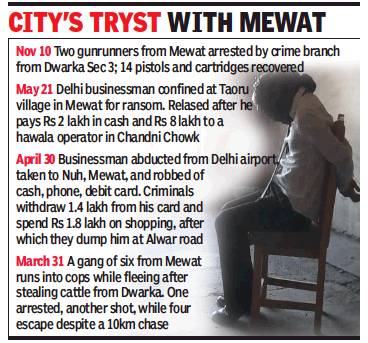
From: Rajshekhar Jha, Criminals from Mewat, Nuh pose headache for capital, November 14, 2018: The Times of India
Till a few years ago, a commercial vehicle driver handing over vertically-folded currency notes at toll plazas at the borders was enough to send Delhi Police into a tizzy. The act was typical of criminals from Nuh and nearby areas of Haryana.
Police had carried out a study to understand the functioning of the gangs that ventured into Delhi, mainly to steal cattle. Subsequently, a crackdown was initiated under MCOCA and several gangs were busted between 2013 and 2015 leading to the arrest of over 50 criminals. Since then, Delhi had not witnessed any major incident by these gangs.
Tuesday’s mowing down of a cop has brought back the focus on these gangs. Police suspect that accomplices of the truck driver, Asgar Khan, could have got down before the police picket. The numberplate of the truck was found folded, a modus operandi adopted by criminals from this region.
At least six major incidents where these criminals were involved have been reported this year. On March 31, cops in Dwarka had a run-in with criminals from Mewat fleeing after stealing cattle. More than 20 rounds were exchanged, one criminal was shot at and another brought down from a tree while four escaped.
In April, a gang led by Akram Khan and Meman kidnapped a businessman and took him to Nuh. He had to pay a ransom for his release. In May, criminals from Nuh kidnapped a north Delhi businessman and made him shell out Rs 10 lakh as ransom. Last week, Crime Branch arrested two Mewati gunrunners with 14 pistols.
[edit] Road accidents
[edit] 2014, on a decline
Jan 03 2015
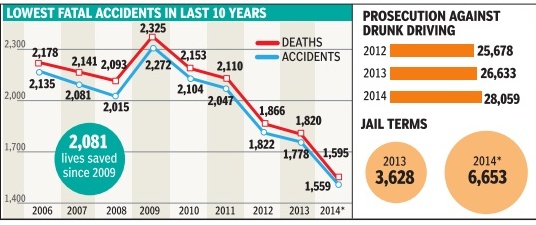

Roads are safer: 10year low in accidents
Somreet Bhattacharya
Despite an increase in the number of vehicles, 2014 witnessed the lowest number of accidents in the past 10 years. In all, 1,595 deaths were reported in 1,559 accidents. During the previous year, 1,820 people had died in 1,778 accidents.
The police have attributed the decrease to steps like installing speedchecking equipment and conducting intensive drives against drunken driving and speeding which cause the maximum number of accidents in the city .Delhi Police commissioner B S Bassi blamed multimodal traffic, rapid unplanned commercialization along roads and an indifferent attitude towards road safety for the high rate of accidents. A special initiative was taken to identify high-speed corridors where traffic violations are rampant leading to deaths. The traffic police also formed a committee to analyse the cause, time and nature of every road accident that had taken place in 2014 and took corrective measures.
Out of the 7 lakh prosecutions by the traffic police last year, 1,23,676 vehicles were prosecuted for speeding as against 29,045 in 2013. The cops also introduced 11 high-speed interceptors that were deployed in areas where drivers tend to speed. A fleet of 50 highway patrol vehicles was deployed on the national highways passing through the city .
The traffic police cracked down on heavy vehicles plying without a rear under-run protection device, a bar that prevents smaller vehicles from slipping under the bigger one during a crash. This prevents fatalities and is a mandatory feature. Till mid-December, 21,514 heavy vehicles had been prosecuted. Delhi Police might also push for taking stricter action against heavy vehicle owners failing to comply with the prescribed standards. They booked 1,90,000 heavy vehicles for dangerous driving and impounded 1049 of them for failing to observe traffic norms. The cops also prosecuted 6653 drunk drivers this year which is nearly 50% more than 2013. Out of these, 17 were given a jail term ranging between one and three days, 21 four and five days, seven six and nine days and six for 10 days. The cops also counselled 38,224 traffic rule violators after challaning them.
Drives were conducted against e-rickshaws which had been banned from plying in the city and 7038 were imponded.
Measures were also taken to increase traffic police presence past midnight resulting in a decrease in fatalities. The duty hours of the personnel were extended to 4am to carry out special drives and night checking.
The traffic cops issued all challans through the e-challan system which allows them to maintain a database of traffic violators. Repeat offenders were targeted and 707 licences cancelled for drunk driving. Action was taken on the basis of complaints found on the traffic police facebook page.
[edit] Cluster buses and violations: 2012-14
Feb 13 2015
Somreet Bhattacharya
Cluster buses have become a cause for concern to the cops as an increasing number of them have been found involved in serious traffic offences, including dangerous driving and driving by minors. Just this year, 231 cluster buses have been booked for various offences in a month. In fact, repeated requests by traffic police to rein in errant drivers have yielded no results. More than 1,200 cluster buses have been introduced since 2012 due to lack of public service vehicles, but no clear policies were framed on the level of training required for drivers. Traffic officials say that last year 702 drivers were booked for rash driving.Shockingly, 64 owners were also booked for allowing minors to drive the buses.
The Delhi Integrated Multi-modal Transit System (DIMTS) has contracted the service to private operators who employ drivers according to their specifications.Such drivers are paid a daily salary while the income generated is transferred to DIMTS. Delhi Police crime branch had unearthed a nexus to recruit cluster bus drivers and arrested a gang in 2013. They suspect more criminals are involved in the recruitment process.
A police officer said many former Blueline bus drivers, who were barred from driving for being involved in fatal accidents, have managed to enter this service as DIMTS doesn't have a say in their recruitment. Also, enforcement is lacking in the case of buses either halting without a bus stop or in the middle of the road for picking up or dropping passengers, which leads to maximum accidents.Last year, 12 people were killed in accidents involving cluster buses, while in 2015 two people have been killed.
A traffic cop said in 2014 they had sent a notification to DTC and DIMTS to ensure the drivers are imparted basic training, but nothing has been done. Data is now being prepared to identify repeat offenders. Once identified, police will send a request to the transport department to get their licenses cancelled.
[edit] Hit-and-run cases: 2014-15
The Times of India, Jul 28 2015
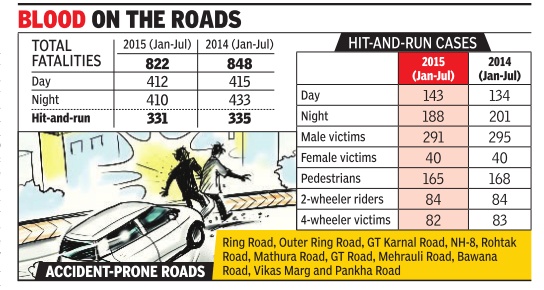
Somreet Bhattacharya
Only 10% solved; poor CCTV coverage and lack of eyewitnesses major impediments
Delhi remains an unsafe city for road users, underlining the urgency in Prime Minister Narendra Modi's expression of concern over the death of 20-year-old Vinay Jindal, a hit-and-run victim who lay bleeding for 10 minutes. Though the traffic police data shows a fall in the number of fatal accidents in the city, the number of hit-andrun cases has not shown any dip since last year. And, shockingly , in only 10% of these cases has the errant driver been traced and booked. Lack of a policy for dealing with such cases strongly is a major impediment in preventing such incidents. This year, out of 822 road fatalities, 331 were cases of hit and run. In the corresponding period last year, 848 incidents had been reported and 335 people had died in hit-and-run incidents. Traffic police officers say they expect the figures to dip following a drive to check the movement of heavy vehicles past midnight.
Experts say though the drives have checked the number of accidents on the highways, roads within colonies are not monitored. For example, Jindal, who was mowed down in Vivek Vihar, was hit as soon as he had driven out of the colony road. Police sources say their plans to monitor these roads using CCTV cameras are still on paper. Though this incident was captured by a CCTV , police could not get a breakthrough due to the quality of the video.
“We have been pushing for technology-based policing at night along with regular pa trols to reduce the number of fatalities. These would include night-vision cameras and speed-checking devices,“ said additional commissioner, traffic, Sharad Aggarwal.
Moreover, it becomes difficult for policemen to find eyewitnesses as people avoid being questioned by the police, fearing harassment. Studies by the traffic police and International Road Federation have shown that in 90% of the cases, the victim dies or turns criti cal as precious moments are wasted in informing the police and ambulance. “People generally avoid contacting the PCR despite assurances they won't be harassed,“ said an official.
In his “Mann Ki Baat“ address, Modi reiterated the need to launch an all-India emergency number,1033, to report such incidents which will be forwarded to the people concerned. It has been observed that a majority of these accidents take place between 9pm and 4am when police presence is limited. Experts blame speed ing, drunk driving and lack of concern for safety of others to be the major reasons for these accidents. Traffic officials say 50% of the casualties involve pedestrians and two-wheelers “In a city like Delhi, some roads are extra wide with fewer number of vehicles. Invariably, motorists tend to overspeed,“ said K K Kapila, IRF chairperson.
Most drivers in the city also do not pay any attention to the high pick-up or weight of their vehicles while driving. “Most drivers speed on a certain stretch and have to slow down suddenly which leads to a pile-up effect,“ an expert pointed out.
The traffic police and ministry of road transport had started a campaign for providing free reflective tapes to cyclists in Delhi and more than three lakh bicycles. Experts say that apart from creating awareness, the government should close loopholes and stiffen penalties in hit-and-run cases.“The requirement is a tougher sentences for those who drive away ,“ said an expert.
[edit] 2018: More fatal crashes
More fatal crashes in 2018, more fines too, January 10, 2019: The Times of India
Police Collect Over ₹100 Crore In Challans
The number of people getting killed on the roads rose in 2018 as compared to the previous year even as Delhi Traffic Police focused on prosecutions. In total, 1,562 fatalities were reported in 2018 in which 1,604 people were killed as compared to 1,491 incidents in 2017 in which 1,510 deaths were witnessed. The total amount of fines collected crossed Rs 105 crore from 64.8 lakh challans as against Rs 96 crore from 56.7 lakh challans the previous year.
To contain the rising number of accidents, police focused on prosecution of violations that endanger the lives of others. If all goes well, the first phase of intelligent traffic management system (ITMS) will become operational this year. Police commissioner Amulya Patnaik confirmed TOI’s report that an expression of interest for appointment of a consultant has been floated after an inprincipal nod has been received from MHA.
“The tentative timeline, programme evaluation and review technique (PERT) charts along with cost estimates will be prepared by the consultant in the detailed project report,” said Patnaik.
Last year, 145 accident prone spots were identified. There was a 1.8% dip in the number of accidents falling to 6,274 in 2018 from 6,386 in 2017.
The number of injured also reduced by 4.7%. Police also cracked down heavily on drunk driving and speeding, the two major reasons behind fatal accidents, and issued 1,74,753 challans under these heads. Also, 11.9 lakh drivers were booked for driving without helmets. Cops booked 11.6 drivers for wrong parking in the decongestion plan ordered by lieutenant governor Anil Baijal.
A record 9.36 lakh public transport vehicles, including 70,000 chartered buses, were found slowing down traffic and challaned.
Special drives against HTVs and commercial vehicles led to a dip in wrong driving and overtaking from the left side. In all, 16.09 lakh drivers of commercial goods vehicles were booked, while 45,926 goods vehicles were turned away from the borders. During special drives, 1.58 lakh e-rickhshaw drivers were booked for various offences.
To reduce road fatalities and to improve traffic management, PWD has been sent 400 design changes on major stretches across the capital.
[edit] Smoking in public
[edit] 2018, 2019 Feb: no. of people fined
Somreet Bhattacharya, 50k fined for smoking in public last year, March 28, 2019: The Times of India
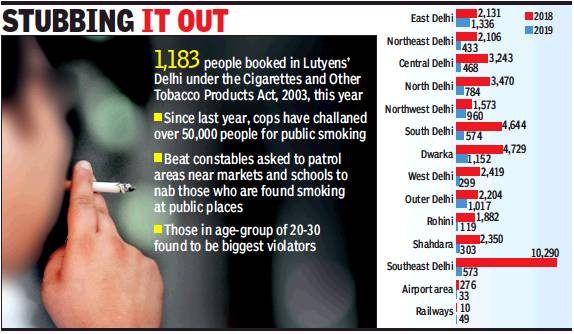
From: Somreet Bhattacharya, 50k fined for smoking in public last year, March 28, 2019: The Times of India
The next time you are standing near a bus stop or metro station in south Delhi, suppress the urge to light a cigarette as there are high chances of getting caught and being fined Rs
200. In 2018, over 10,000 people were booked for this offence in south Delhi alone. This year, 574 have ended up paying the fine till date. In Lutyens’ Delhi, 1,183 people have been challaned this year.
Since last year, more than 50,000 people have been challaned for public smoking under Cigarettes and Other Tobacco Products Act (COTPA), the highest number since the law was enacted. Beat constables have been asked to patrol markets and areas near schools to nab smokers.
The anti-public smoking drive showed that youths between the age-group of 20-30 were the biggest violators. Women constituted about 30% of the violators. Officers said 95% challans were issued to smokers and 5% to tobacco product vendors near educational institutions. In some instances, the violators were found to be repeat offenders.
Delhi Police PRO, DCP Madhur Verma said that cops have been asked to keep a watch on markets, metro stations and bus stops where the maximum violations are detected. “We issue fines on the spot and counsel offenders about smoking in public places. A police station is tasked each day to conduct such a drive in their area,” he added.
The police drive peaks between 6pm and 9pm, the time when many people are found violating the norms. The rules governing the sale of tobacco products are enforced strictly outside hospitals and policemen have been deployed outside schools to enforce the ban on sale of tobacco within 100 metres of the establishments. Apart from police, a team from the tobacco control cell has been keeping a check on the sale of tobacco to minors.
Police said issuing a challan under COTPA has proven effective. Earlier, challans were issued under “kalandra” proceedings (breach of peace or disturbing public tranquility) where the fine would be payable in the presence of a magistrate. Police sources said that the system proved less effective as violators didn’t provide ID cards or turn up to pay the fine.
[edit] Snatching
[edit] 2002-17

See graphic:
Number of snatching cases in Delhi, 2002-17
[edit] 2015-2018, June
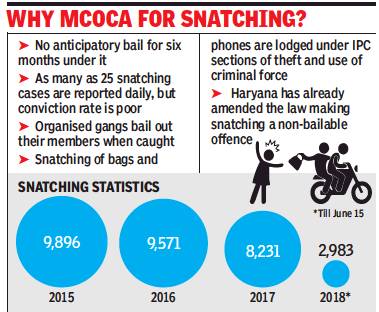
From: Sidharth Bhardwaj, Snatching under MCOCA, cops create database to widen net, July 8, 2018: The Times of India
See graphic:
Snatchings in Delhi, 2015-2018, June
[edit] Chain snatching/ 2016
The Times of India, Apr 11 2016
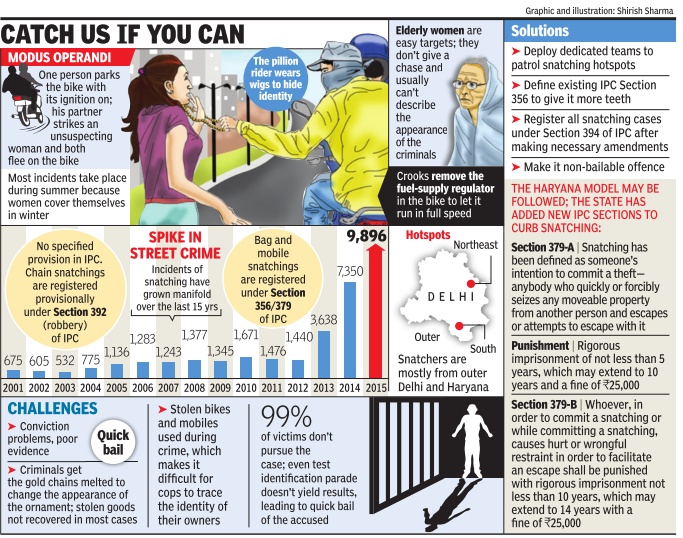
40 snatchings a day, yet no law deals with it
Rajshekhar Jha A few days ago, two men on a bike intercepted a motorcyclist at ITO, metres from Delhi Police headquarters, and robbed him of Rs 50,000. When police registered an FIR, it had to be under sections related to theft and use of criminal force while committing a crime. Yes, in a city where snatchers strike at 30-40 places every day , there is no law to deal with this crime.
Haryana has brought in two special sections to deal with the crime. Ironically , the tightening of the screws in Haryana seems to have led to an exodus of snatchers to more lenient Delhi, with sources con firming that the majority of snatchers now active in the city are from the neighbouring state. Haryana has made snatching a non-bailable crime and enhanced punishment for theft under Section 379 of Indian Penal Code to up to 10 years' imprisonment. While the Delhi Police attribute the in crease in the number of snatchings to reforms that have made it easier for citizens to register crimes, the sheer numbers are alarming. Both the cops and legal experts that TOI spoke to agreed that it was time a stringent law was enacted to tackle the problem. Delhi can perhaps replicate Haryana's amendments to Sections 379.
At present, snatchers in the city are booked under IPC Sections 379 (theft) and 356 (assault or criminal force during theft). The maximum punishment for a crime under Section 356 is two years' imprisonment, while it is three years under Section 379. Chain snatchings are provisionally registered under IPC Section 392 (robbery) in which the accused may be punished with rigorous imprisonment up to 10 years with a fine. However, police admit that cases registered under Section 392 frequently fall flat in courts for lack of evidence.
“Snatching cases have a poor conviction rate because most victims do not pursue the case,“ said an investigator. Also, the test identification parade often proves a failure because most victims cannot recog nise the snatchers, who wear helmets to hide their faces at the time of committing the crime. Frequently stolen bikes are used by snatchers, making it difficult to pin the identity of the criminals.
“And then,“ the investigator added, “the stolen chains are melted within hours so there is no case property to establish the theft.“ The accused go free within months in most cases.
Police say that factors like the poor conviction rate, absence of a dedicated law and constraints in proving the involvement of a suspect are factors why snatchers have a free run in the capital.
To add to the complexity of the crime, the cops are detecting new trends. Till 2009, small-time liquor smugglers committed such crimes.“When crimes under the Excise Act became non-bailable, many smugglers from the Sansi community shifted to chain snatching,“ a police officer said. “Now, new entrants include college and school students, with no police records, looking to make an extra buck.“
[edit] 2017/ snatchings, region-wise
Rajshekhar Jha, Snatchers most active in Anand Vihar, October 2, 2017: The Times of India
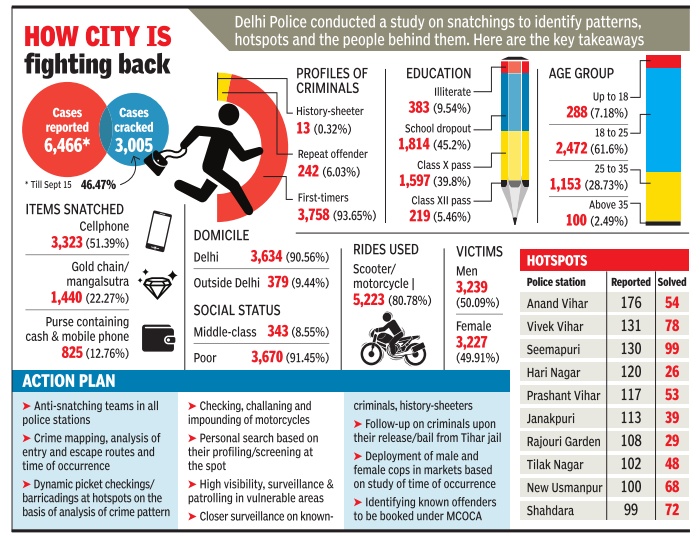
85% Of Incidents Recorded At 96 Police Stations; 94% Of Those Arrested Are First-Timers
Anand Vihar is where the most snatchings in Delhi -176 -have taken place till September 15 this year, followed by Vivek Vihar with 132 incidents and Seemapuri with 130. Hari Nagar and Prashant Vihar occupy the fourth and fifth positions, with 120 and 117 cases, respectively , being recorded.
Half of the snatchings -a prime indicator of the streetcrime situation -reported in Delhi occurred in just 37 police station areas; 85% of incidents have been recorded at 96 police stations in the capital and 21 stations have reported no incidents so far this year, according to the findings of a study conducted by Delhi Police as part of an organised crackdown on snatching ordered by police commissioner Amulya Patnaik.
The study reveals another surprising fact: 94% of the criminals arrested for the offence are first-timers.
Areas like Janakpuri, Rajouri Garden, Tilak Nagar , New Usmanpur and Shahdara are in the bottom-five list, with Shahdara at 10th place with 99 snatchings till September 15.
The study also shows that mobile phones are snatched in half the reported cases and gold chains or mangalsutras in 22.27% of cases. The rest of the snatched items comprise bags, etc. The study shows that the snatchers strike irrespective of a victim's gender: 50% of victims are male while 49.91% of victims have been females.
Patnaik told TOI that the Delhi Police had arrested 45% more snatchers than last year and also solved 47% of snatchings this year, as against 27% in 2016.
“All police stations have an anti-snatching cell since July this year. These teams have apprehended over 2,600 snat chers since then. Detection under this head had always been difficult due to a large percentage of criminals being first-timers and leaving no clue at the site. Victims, traumatised, cannot even provide physical descriptions of the culprits,“ Patnaik said, adding, “However, curbing this crime has been a priority and we have been able to crack down on it to quite an extent.“
According to police data, there were just two snatchings reported per day in 2001. Delhi's population was around 2.7 million at that time. Ten years later, the city , with a population of 16.7 million, began to witness four cases a day .
By 2016, the population shot up to 1.8 crore and the city started to see 26 cases a day ,a six-fold jump. According to police data, from 675 cases in 2001, Delhi recorded 6,965 snatchings in 2016, more than a 10fold increase.
However, 2017 has seen a dip in this particular crime.Data shows that this year snatching incidents declined 7.16% from 2016, and 5.98% from 2015.Till September 15 in 2017, 6,466 cases have been registered against 6,965 in the same time period in 2016. Violent snatchings, which are registered under the section dealing with robbery , have fallen 40%.
More cases have been solved in 2017. “While 3,005 cases have been solved this year, the figure was 1,894 last year and only 1,405 cases were solved in 2015. The data shows that 4,013 persons have been arrested this year as against 2,752 in 2016 and 1,977 in 2015,“ special commissioner Dependra Pathak, spokesperson of the Delhi Police, said.
According to police data, a majority of the snatchers are poor and illiterate and a small percentage are school dropouts or have studied till Class XII. More than 69% of criminals are below 25 years of age and 91% of them reside in Delhi. Most snatchers (61.6%) are between 18 and 25 years of age, the study says.
[edit] 2018: ten case studies
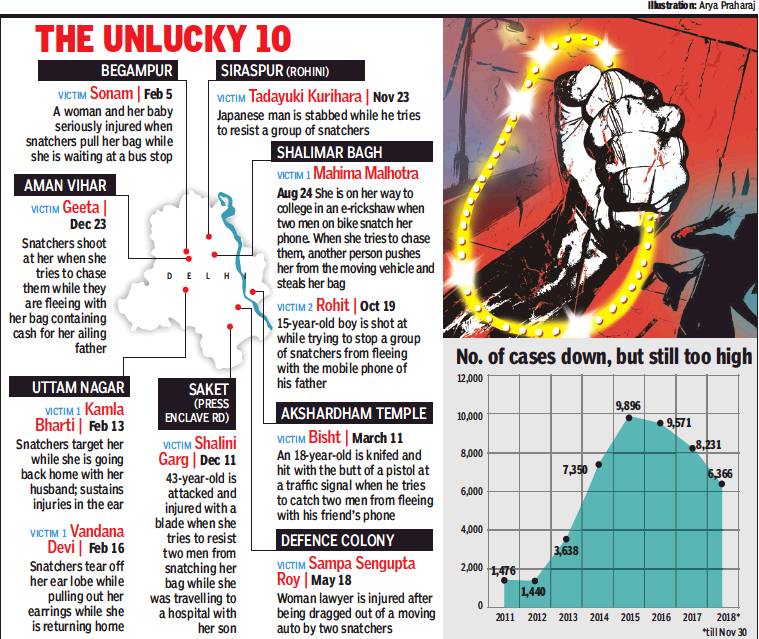
No. of cases, 2011-17
From: Somreet Bhattacharya & Sidharth Bhardwaj, How they snatched city’s peace of mind, January 7, 2019: The Times of India
SNATCHERS INSTIL FEAR: Victims Recount Incidents That Shook Them In 2018
It’s going to be nearly 11 months since two men tore the earlobes of 59-year-old Kamla Bharti while snatching her earrings, but she still dreads going out wearing jewellery. The incident that took place in February 2018 near a bus stop in Uttam Nagar has shaken her to the core and she is always on an edge while venturing out.
Kamla is not the only one living in fear as many victims of snatching have not been able to forget their traumatic experience. Despite a crackdown on street crimes, the cases of snatching remained high in 2018. Victims of 10 of the most shocking incidents relived their trauma to TOI.
“My wife had to undergo surgery and the scar on her ear is a constant reminder of what she went through. She fears the criminals will target her again once they are out of jail,” said OP Bharti, Kamla’s husband.
Two days later, the same group targeted another woman, Vandana Devi (59). She recalled that passersby didn’t try to stop the criminals even as she kept crying for help. The snatchers were caught a few days later.
On May 18, lawyer Sampa Sengupta Roy, who was on her way to the Delhi high court to cast her vote for the bar association elections, was dragged out of an autorickshaw by criminals trying to snatch her bag. She was saved from being run over as the SUV travelling behind braked just in time. “She has recovered from the injuries, but deep down a trauma remains,” said her husband, Partha Roy.
Sonam (28), a resident of Kerala, and her sevenmonth-old baby suffered injuries when she tried to stop bikers from snatching her phone in Begumpur. The pillion rider kicked her and she fell. “I was waiting at the bus stand when the men tried to snatch my mobile phone. I tried to resist, but let go of the phone after my child fell and took him to a hospital for treatment,” Sonam said. Police were unable to trace the criminals.
An engineering student, Mahima Malhotra (20), had to be hospitalised after falling off an e-rickshaw while trying to save her mobile phone from bike-borne snatchers on August 24 in Shalimar Bagh. She was on her way to college at the time. Even as she screamed for help, the e-rickshaw driver turned deaf and didn’t stop the vehicle. As a result she fell on her face and lost consciousness. What was worse was that a co-passenger tried to steal her purse.
“I lost my gold chain to snatchers in the same spot a year ago. We have complained to police to increase patrolling in the area,” said Vinod Malhotra, Mahima’s father.
Geeta was shot at by snatchers when she caught one of them by the collar near Prem Nagar in Aman Vihar on December 24. She was robbed of her gold chain, cash and mobile phone. Her brother Sumit said she is yet to recover completely from the attack. “She had come from Agra to meet our father who had been diagnosed with cancer. We are yet to hear from the cops,” he added.
Rohit (15), who had tried to help an elderly man from a gang that had snatched his gold chain, suffered a similar fate when he was shot at by the fleeing criminals at Rampura Road near Shalimar Bagh in October. “I did my duty as a responsible citizen. The bullet injury in my abdomen still throbs at times,” he said.
On December 11, 43-yearold Shalini Garg, who was going to a hospital in an autorickshaw, was attacked with a blade when she resisted the attempt of two men from snatching her bag at Press Enclave Road. The snatchers were caught two days later from Madangir. “Snatchings may be petty street crimes for police, but the trauma a victim goes through is inexplicable,” said her son, Ashish.
A Japanese national, Tadayuki Kurihara, was stabbed multiple times in northwest Delhi’s Siraspur on the eve of Guru Nanak Jayanti on his maiden visit to the capital in October by some men trying to snatch his mobile phone and wallet.
[edit] Subways
[edit] As in 2018
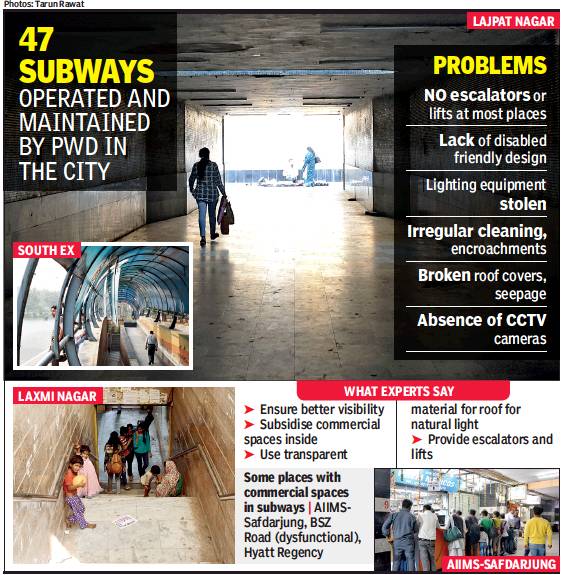
From: Paras Singh, Subways now Delhi’s dark underbelly, PWD plans to make them safe again, November 18, 2018: The Times of India
Neglected Facilities Turning Into Crime Dens; PWD Hopes Illumination, Shops Might Help
As tend to hasten down the subway at South Extension because you fear the loosely hanging fibreglass roof will fall on your head. Paan stains mark every possible corner of the dirty, unlit passageway. Suresh Kumar, the guard who has been stationed there for eight years now, revealed that smack addicts had stolen the fluorescent lights. “I once got into fight with them at 2-3am, and they held a knife to me. I can’t sacrifice my life for a lamp, so I replaced a few of the stolen CFLs with my own money,” old man mumbled.
Move a few kilometres ahead, things are no better in Lajpat Nagar. The in the guard’s uniform there is drunk and out of his senses. “He is always like this despite so many complaints,” said a dismissive Ram Kumari, a sanitation worker. The space where an escalator is to be installed is filled with garbage, but Shikha Singh said they had no other way to cross the busy Ring Road. “I have seen men urinating at this spot, and after evening now woman uses the subway,” she added.
In the last two decades, Delhi government has spent crores on these underground walkways. The Public Works Department maintains 47 of them, most in south Delhi. Others operated by the municipal corporations are defunct, many of them having turned into a hangout for drug addicts, like the one in South Extension. When TOI checked out the subways at Laxmi Nagar, Bahadur Shah Zafar Marg, South Extension, IIT, Lajpat Nagar, AIIMS, Bhikaji Cama Place and Munirka, it discovered how neglected these pedestrian facilities actually are.
Things might change with PWD preparing a plan to have shops in the subways, mainly to prevent “antisocial activities” after evening hours. “We have been directed by PWD’s engineerin-chief Puneet Kumar Vats to make zone-wise list of subways where space, electricity and water are available and where it is feasible for shops to stay open till late in the night,” disclosed a PWD official. People in the department also revealed that the issue of anti-social activities was discussed in a meeting chaired by lieutenant governor Anil Baijal.
Though subways at Connaught Place, AIIMS-Safdarjang Hospital and BSZ Marg have had commercial outlets for some time now, the image of a passageway as just a pedestrian structure has affected their viability. Over half a dozen shops are operating in the AIIMS-Safdarjang subway and keep the space lively and active. Chemist Naveen Singh testified, “If they have ownership of space, people take care of it. Shopkeepers prevent miscreants from taking over the area.”
Professor Sewa Ram of the School of Planning and Architecture agreed that the shops would be a welcome addition, but said the design of the subways actually played a crucial role. “Subways must allow people to see inside before entering and clear visibility should be possible. No one wants to use units like the Yusuf Sarai subway because they feel like tunnels,” Ram explained.
Ram also argued that business turnover should not be the aim in opening the shops. He pointed out how focusing on commerce has led to the experiment of cafes in the BSZ Marg subway failing. When built in 1995, it was the location for the Media Coffee Home, a joint venture of the municipal corporation and DTTDC. “The maintenance of the subway was the corporation’s responsibility and matters pertaining to the café, including marketing, were to be handled by DTTDC,” a civic official explained. The café did not survive for long. Various other food chains tried their hand, but the last closed earlier this year, leaving the space neglected and accessible for the homeless.
Experiences like these would have informed the new plan to have shops in subways. Perhaps, the planners now have a formula that can work — and the subways cease being risk-filled spots.
[edit] Thefts
[edit] Jan-April 2017/ thefts on a decline
Going by the numbers released by Delhi Police, crime seems to have declined in the first four months this year as compared to 2016. While murders and rapes -which are the prime indicators of the crime situation in the city -have dipped, even snatchings and robberies have gone south as well.
Moreover, this is the first time in the last few years that vehicle thefts have gone down, though marginally .From 12,784 thefts reported between January and April in 2016, the figure stands at 12,666 in the corresponding period this year.
While 164 murders were reported early last year, this year the number is 158 till April 30.This is a pleasant change as compared to the sudden spike in murders in the first two months of 2017. This year, 647 rapes and 1,110 molestation cases have been lodged as compared to 685 rapes and 1,443 molestations reported till April 30 last year.
Snatching, the prime indicator of street crime, has also seen a fall from 3,378 in 2016 to 2,923 in 2017 in the first four months. The total number of heinous crimes has dipped from 3,071 to 2,131. Even the ro ads seem safer as 433 fatal incidents have been reported this year as compared to 528 cases reported till April 30, 2016. Robberies have seen a dramatic fall from 1,959 to 1,081and dacoities have fallen from 17 to 14. Kidnapping for ransom has dipped from 9 to 6 in the first four months.
Officers attribute the dip in crime to several factors, including enhanced patrolling and a more visible police force on the streets. Another major contributing factor, officers said, is police commissioner Amulya Patnaik's engagement with all ranks of the force. Be it special commissioners or beat constables, the top cop has ensured that he reaches out to everyo ne. Patnaik also showed a rare gesture by meeting beat cops, the backbone of the force, in south Delhi two weeks ago. Apart from lauding the efforts of offi cers, Patnaik has fixed accountability for lapses as well. With zero tolerance on corruption, the police chief has ensured that all supervisory officers are held responsible for their respective jurisdictions.
Special commissioners (law and order) and joint commissioners of all ranges have been asked to engage in on-the ground policing. This precedent has clearly reflected in the crime figures.
Patnaik now wants to make public transport safer for women after dark. He said that monitoring systems would be set up to keep a check on drivers of public service vehicles.It would the force's priority to ensure safety of women who usually travel alone.
[edit] 2018> 19: success rate in solving cases

From: Oct 15, 2019: The Times of India
See graphic:
2018> 19: the success rate in solving snatching and robbery cases in Delhi.
[edit] Unsolved crimes
[edit] Murders, unsolved
The Times of India Jul 13 2015
[edit] Patel Nagar double murder (2010) and Rajouri Garden murder (2011)
On July 9, 2010, Anuradha Nangia (34), wife of a property dealer, and her son Charis (6) were found murdered in West Patel Nagar, central Delhi. Eighteen months later, on January 14, 2012, Gurpreet Kaur (29) and her daughter Jasmin (8), were murdered at their house in Rajouri Garden. The two cases had striking links: all the victims had hair strands either in their hands or lying near them. Charis's elder brother and Jasmin went to the same residential school in Himachal Pradesh. And both sets of murders happened within weeks of the mothers visiting the school. Police have visited the school and got the hair strands tested but the killers remain elusive.
[edit] Shobhit Modi murder
The 20-year-old IT student was stabbed to death a few hundred metres from home in Vasant Kunj on May 5, 2011. Interrogation of more than 7,000 people, including ruffians, drug addicts and peddlers, and history-sheeters, besides questioning of 1,200 auto drivers and 1,400 workers at DLF Mall didn't yield clues.Police also analysed 10,000 mobile and landline numbers. Shobhit's family alleged relatives of one of his women friends were involved. Police found them clean.
[edit] Rohini triple murder
On September 21, 2012, a couple and their daughter were found murdered inside their Sector 17 house in Rohini. The couple's heads had been smashed but their daughter was smothered with a pillow after suspected rape. She was probably tied up to a window at the time of rape Analyses of phone calls and the family's contacts didn't yield any clues but police haven' given up hope as DNA lifted from teacups found on the dining table--indicating a friendly entry--might eventually lead to the killers.
[edit] Sarojini Bartwal murder
The 78-year-old retired journalist was found killed inside her flat on January 10, 2012.She was smothered with a towel. Her son, Hemendra, then an advisor to the British High Commission, lived in Indirapuram, Ghaziabad.More than 200 people, including ragpickers and shopkeepers, were questioned. Police also looked into the property and robbery angles but couldn't crack the case.
[edit] GK senior citizen murder
Jogesh, a 66-year-old retired woman journalist, was found strangled inside her GK-I (R block) house in November 2011. She lived with her hus band, a retired government employee, nephew and niece Her room was ransacked, im portant papers were strewn around but neither jewellery nor electronic goods were missing. Enmity or a prop erty dispute was the most plausible theory.
[edit] Neha Jindal murder
(2009) 20-year-old DU alumna Neha Jindal's burnt body was found in the backyard of her father's official residence located behind Sarai Rohilla Police Station in North Delhi. Her mother was a Delhi Police sub-inspector. Neha's father Shyam Sunder Jindal, who underwent scientific examination, said he had gone to pick up his wife from Parliament House. On returning, he claimed, he found the front door open and the house ransacked, although police didn't buy this. Burnt bits of paper were found near the body . Police examined suicide and murder angles but couldn't make a breakthrough.
[edit] Chhitarmal Jain murder
Chhitarmal Jain (50), owner of Deluxe Store in Defence Colony Market, didn't return home on the night of October 26, 2012. His body was found next morning in Delhi Cantonment but his Hyundai Accent car was in the VIP parking at AIIMS. His phone was traced to a labourer in Madhya Pradesh who claimed to have found it at Sarai Kale Khan ISBT. There were two initial suspects: a 20-year-old who had met Jain and started working for him a month ago and his friend who worked with an NGO. Both were found innocent eventually and the case was buried.
[edit] Valentine's Day murder
Simranjeet Kaur (26), a married woman who worked as HR manager with a Noida MNC, was killed at 7.36 pm on February 14, 2014 in a Karol Bagh neighbourhood.The killer stabbed her in the heart with a kitchen knife just outside the house of her cousin whom she wanted to surprise with a visit. Kaur was heard shouting “chor, chor“ and CCTV cameras of nearby houses showed a young man wearing dark jeans and white jacket trail her, stab and flee. Police see it as a rob bery gone wrong. They drew up a list of 70 suspects, of whom 60 were de clared clean and the rest went untraced.
[edit] Cash van heists in 2013, 2014
On October 27, 2013 bikers in two pairs snatched Rs 90 lakh at gunpoint from a cash van in northeast Delhi. On November 30, 2014, two armed robbers on a bike shot dead a cash van guard and looted Rs 1.5 crore from staff loading cash in a Citibank ATM in Kamla Nagar, north Delhi. Neither group of robbers has been identified. In the Kamla Nagar case, 26 ex-employees of the cash replenishment company who were either sacked or quit were verified and found clean.
[edit] 2016: Unsolved cases, all-time high
2016 wasn't a particularly good year for Delhi Police as far is solving criminal cases was concerned. Data with the cops show that the percentage of unsolved cases was at an all-time high last year. The cops wouldn't be proud that 86% of vehicle thefts and a similar number of domestic robberies were not sewn up. While 40% of kidnapping cases reached no conclusion, 65% of snatchings and 40% of extortion cases weren't cracked either.
This trend was particularly disappointing since the figures showed crime on the up in the capital. The total cases registered under the Indian Penal Code shot up from 1,91,377 in 2015 to 2,09,519 last year, of which 1,53,562 remained unsolved. In terms of number, police were unable to get to the bottom of 11,902 of 14,307 burglaries and 33,304 of 38,644 vehicle thefts.Similarly , perpetrators of 12,645 of 14,307 house robberies escaped the police net.
The performance of Delhi Police in curbing crimes against women wasn't great either. Of the 4,165 molestation cases, 1,132 were not unravelled, while 291 (14%) cases of rape of a total of 2,155 remained unsolved as well. Ironically, the spike in un solved percentages was accompanied by a spiral in several criminal categories. 2016 saw 1,459 more cases of burglaries over 2015 and around 6,000 more cases of vehicle thefts and 3,603 more cases of kidnappings of minors too.
The brighter side of crime fighting in 2016, though, was that heinous cases dipped in comparison with the figures of 2015. There were fewer murders and robberies in 2016 than 2015. Other crimes, such as snatchings, also showed a downward trend. But, as TOI had pointed out in December, this was rather the result of the chaos created by demonetisation than efficient policing.
In 2016, 9,571 heinous crimes were reported against 9,896 the previous year. Against 570 murders in 2015, there were 528 last year. Similarly, robberies showed a big slide from 7,407 in 2015 to 4,781in 2016. Cases of rioting (mostly non-communal in nature) also dipped to 79 last year against 130 the previous year.
Usually , Delhi Police holds an annual press conference early in January every year to disclose information on crime and the cops' performance in the capital. This year, it was scheduled for January 3, but was first moved to January 10 and then postponed indefinitely with the change at the helm in the capital's Police Headquarters.
[edit] 2017-18

From: Rajshekhar Jha, Why cops are losing sleep over those who got away, February 24, 2018: The Times of India
There have been quite a few sensational crimes in recent times that have remained unsolved. These range from murders to cash van loots. The pile-up has put the specialised units of Delhi Police under severe strain.
This year, at least three sensational murders have had the police on their toes. On February 9, a businessman was killed in Malviya Nagar in south Delhi, days after he returned from the UK. Three days earlier, a Congress functionary and real estate businessman Vinod Mehra was gunned down on a busy flyover in northwest Delhi. Police suspect the south Delhi murder was due to personal rivalry and the Congress member was killed in road rage.
In January, a 30-year old man was shot dead in full public view at Prashant Vihar. Ravi Bhardwaj was shot 16 times in what was, according to the police, a gang war. Gangster Jitender Gogi is the prime suspect in the case.
The list of unsolved murders is long. The brutal murder of a doctor inside St Stephen’s hospital is another case in point. The suspect in this case, another doctor, was identified but can’t be traced. He is suspected to have fled to Nepal or some spiritual place where he could be practising yoga, sources said.
In October-end, businessman Pankaj Garg (35) and his accountant Harish Bhatia were shot dead while on their way to a bank. The killers then fled with a cash bag containing Rs 25 lakh. Garg’s driver and another staffer escaped with injuries. Police released sketches of the shooters and suspect the role of an outer Delhi gangster but haven’t made any breakthrough yet.
Other than the murders, there were cash van loots and ATM thefts that also haven’t been solved.
In May and June last year, criminals on bikes attacked cash vans. At Bhalswa Dairy on June 23, such a van was attacked and its gunman shot. Rs 19 lakh was looted in this heist. There were also cases where entire ATMs were uprooted and taken away between October last year and January this year. Incidentally, a suspended crime branch policeman is a suspect.
Police sources said there was an urgent need to reshuffle officials in specialised units. While the special cell is mostly busy with documentation of surrenders of interstate criminals or filing chargesheets and collecting evidence in cases handed over to them by intelligence agencies, the crime branch seems to be focusing on routine arrests of petty criminals. Cracking the Jindal family murders, rescuing a kidnapped child and handling the Dhinakaran bribery case, have kept them occupied in the last one year.
[edit] Women, crimes against
[edit] 2015>17
Oct 23, 2019: The Times of India
Fewer crimes against women were logged in Delhi in 2017 than in the previous year, but the city still had a higher rate — 152 cases per lakh population — than in other metro cities. There were 13,076 cases of crimes against women registered in 2017 against 15,310 in 2016.
According to NCRB data, police registered 1,229 cases of rape, among them 73 gang rapes and 43 committed by parents, guardians or teachers of the victim. In 2017, Delhi saw six cases of rape and murder, the most since 2015. Of the rape victims, 871 were in the 18-30 age group. Around 96% of the accused in the rape cases were found to be familiar to the victims. The cops also reported 2,548 cases related to molestation and outraging the modesty of a woman.
While Delhi Police reported 102 dowry deaths in 2017, there were five cases of acid attacks on women despite the ban on sale of acid being reiterated that year. There were 229 cases of kidnapping of women and 13 cases of human trafficking. Delhi saw the most stalking cases at 472, ahead of Mumbai (383) and Pune (127). In cases of voyeurism, including women being recorded while undressing in the bathroom or shop changing rooms, Delhi was marginally second to Mumbai having logged 38 cases to the financial capital’s 39. Police registered 25 cases of sexual harassment at the workplace, the second highest after Hyderabad, and 560 cases of sexual harassment.
Delhi Police responded that the rising figures reflected the immediate registration of cases on complaints made by women.
[edit] Women, crimes by
[edit] 2015>17
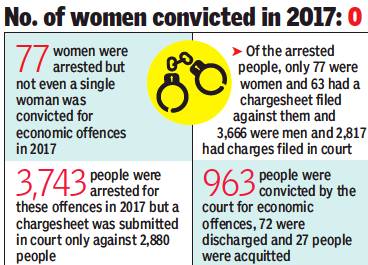
From: Rajshekhar Jha , Oct 23, 2019: The Times of India
See graphic, ‘Number of women convicted in 2017’
[edit] PART B: INVESTIGATION, PROSECUTION
[edit] Year-wise developments
[edit] 2019
November 6, 2020: The Times of India

From: November 6, 2020: The Times of India
90% of IPC cases pending trial: Report
NGO’s Analysis Of Data Reveals Chargesheets Filed In Just 16% Cases In 2019
New Delhi:
Delhi Police filed a chargesheet in just 16% of the cases registered under Indian Penal Code (IPC) in 2019. Also, 90% of the total IPC cases were pending trial at the end of the year. These were a few of the findings that were revealed by NGO Praja Foundation after analysing crime data obtained through various sources, including Right to Information Act.
The report, released, showed a pretty grim picture of the investigation done by Delhi Police. Praja’s White Paper showed that while 3,10,983 cases were lodged, chargesheets were filed in only 16% last year.
Poor investigation of cases also resulted in a low conviction rate. “The accused in 59% of the cases of crime against women and 38% of crime against children were acquitted or discharged. Further, there was a high pendency of investigation in cases of crime against women (58%) and children (55%) in 2019. Also, 89% of the total Special and Local Laws crime cases were pending trial,” the report claimed.
In cases registered under Protection of Children from Sexual Offences (Pocso) Act, Praja found that in 2019 there were 1,719 child sexual abuse cases, including 969 of rape, 604 of sexual assault, 90 of unnatural offences and 50 of sexual harassment. “In the same year, Pocso courts adjudged just 118 cases. Moreover, only 25% of these judgments (30 out of 118) were pronounced within one year, which is required by the Act,” said the report.
Girls were victims in 93% of the cases. The low proportion of male cases also reflected the stigma attached to reporting of sexual crimes against males, stated the report, while also highlighting how reporting of cases had fallen in all major crimes in the last five years in Delhi. Reporting of murders fell by 9%, rape by 1%, molestation by 46% and kidnapping by 24%.
Praja claimed that cybercrime investigation was also in the doldrums. “Cybercrimes can be registered at the 13 district cyber cells and not at police stations. This led to poor reporting — 115 cases in 2019, 29% less than in 2017. The conviction percentage drastically decreased from 50% in 2017 to 14% in 2019,” the report stated. While complaints could also be filed online, the NGO said a cyber cell in every police station was the need of the hour.
The data analysis revealed that just 35% of 14,836 victims of kidnapping and abduction were recovered in 2019, a fall from 48% in 2017. Kidnapping of girls had risen in the past five years. While in 2015 there were 54% cases of girl child kidnapping, in 2019 this rose to 63%. The recovery rate of alive kidnapped victims fell from 48% in 2017 to 35% in 2019.
The report also highlighted the shortage of police personnel at various ranks, which was severely impacting investigation of heinous crimes.
Meanwhile, Delhi Police said it was a professional force that carried out investigation according to the law and cases were probed and finalised in a time-bound manner.
